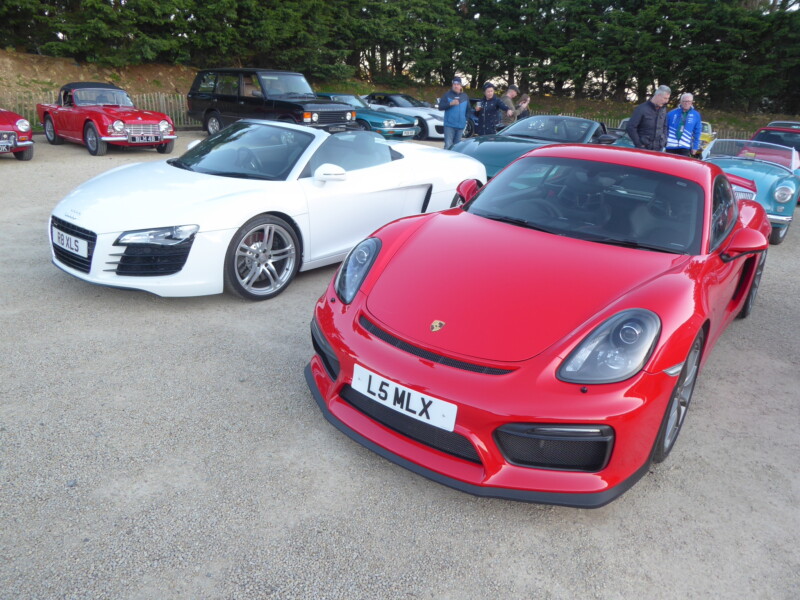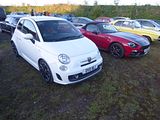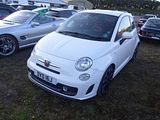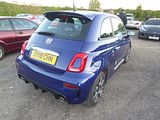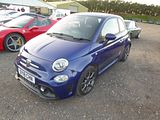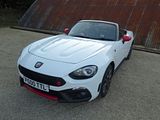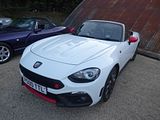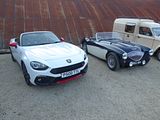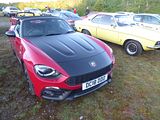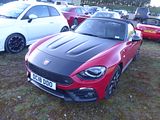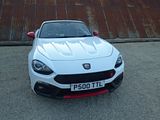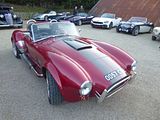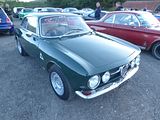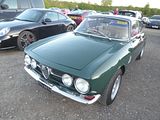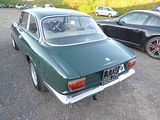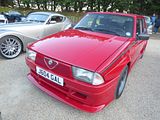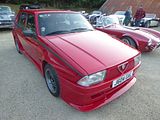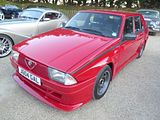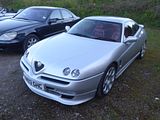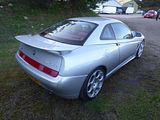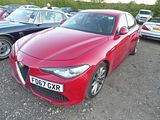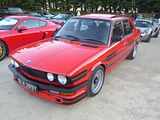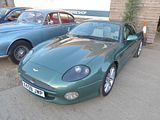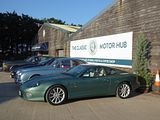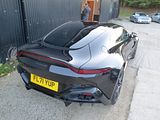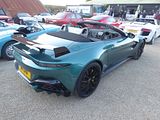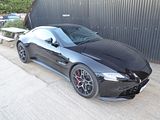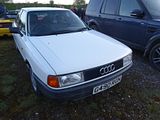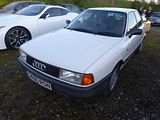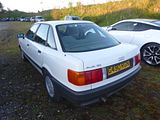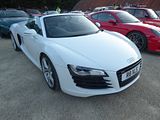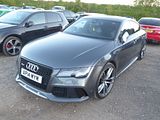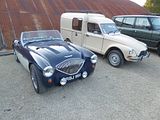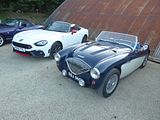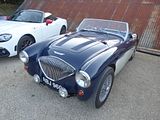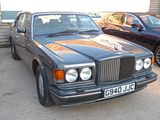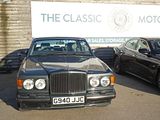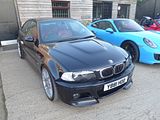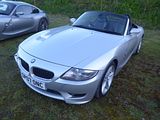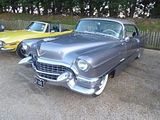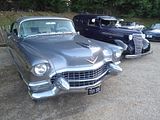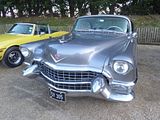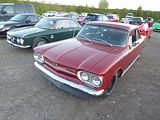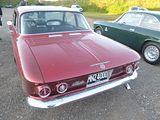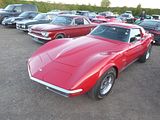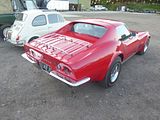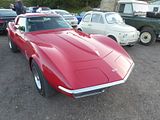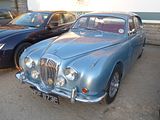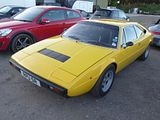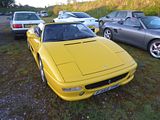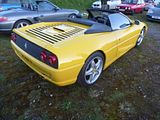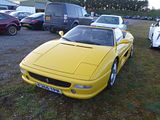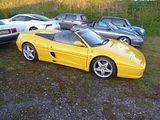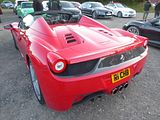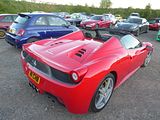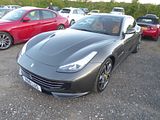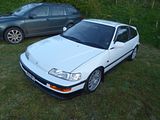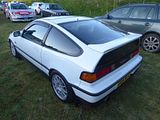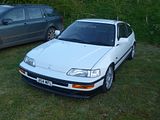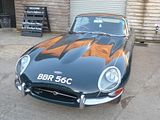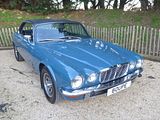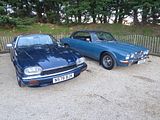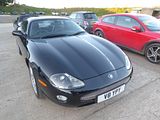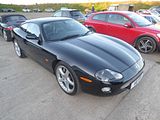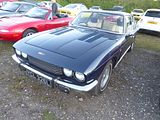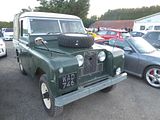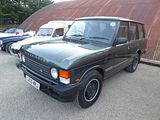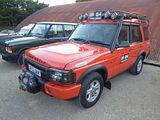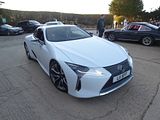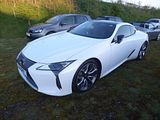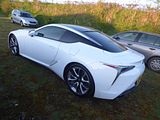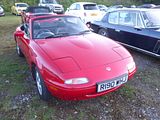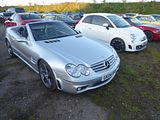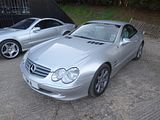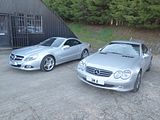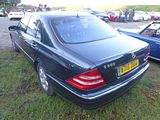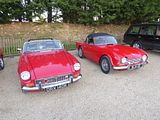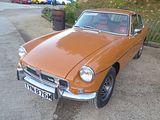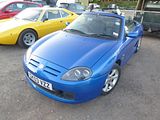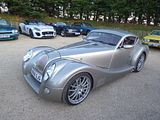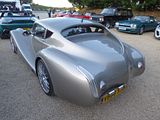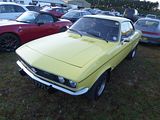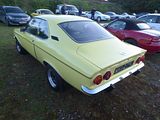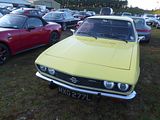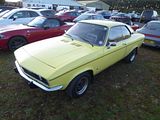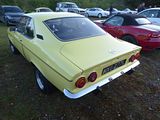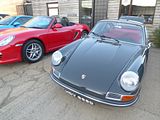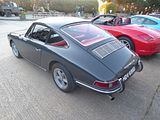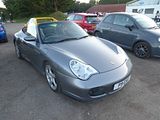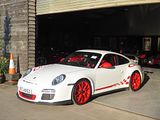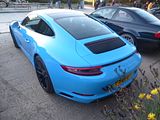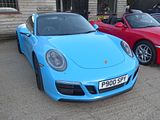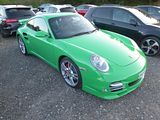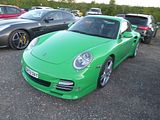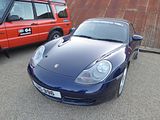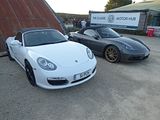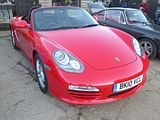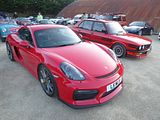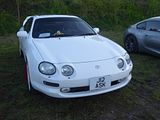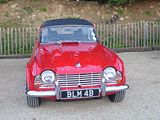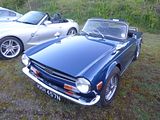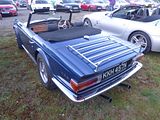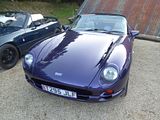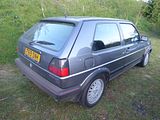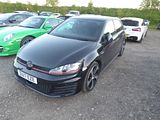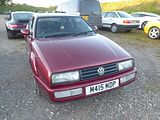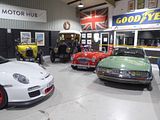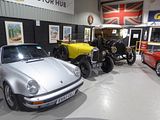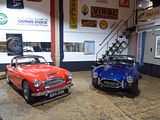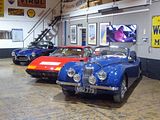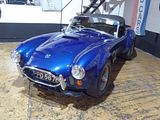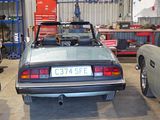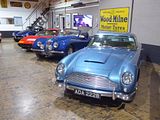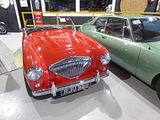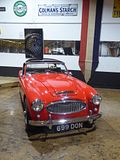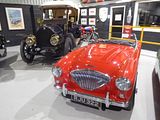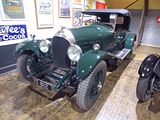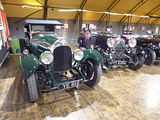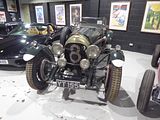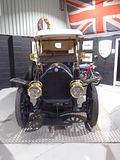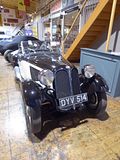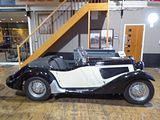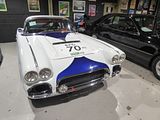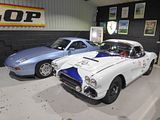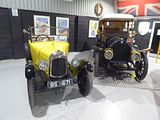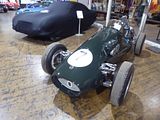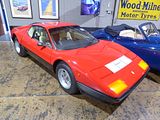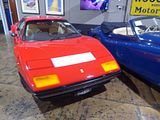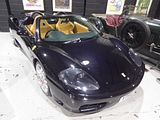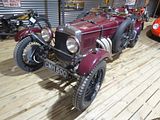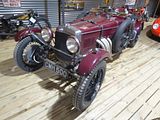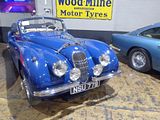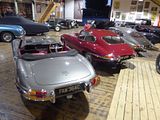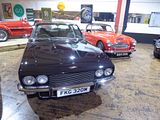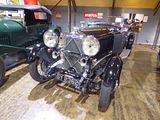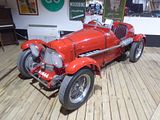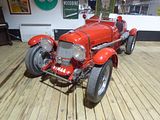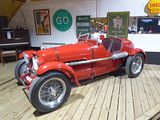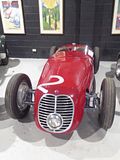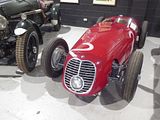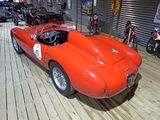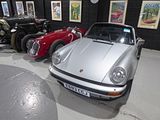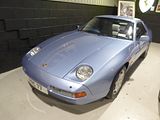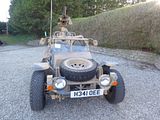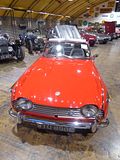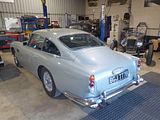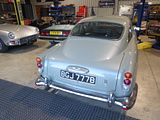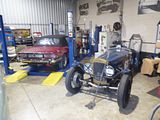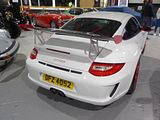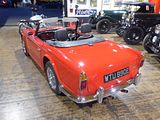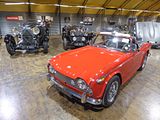With the arrival of much lighter evenings, April is the month when a whole load of mid-week after work events start to appear in the diary. The enthusiast is genuinely spoiled for each even without having to travel over a particularly large area. Some gatherings, of course, are larger than others, depending to some extent on how much local competition they have, how much space there is and indeed how well known they are. Scoring highly on all three of those points must the Classic Motor Hub. Located a few miles outside the charming Cotswold village of Bibury there are few, if any rival events within even quite a large radius of the location, but equally the visitors to this event would also likely come from something of a distance, something that they are keen to do, as the venue is now well known, and of course there is lots of space on site for some pretty sizeable gatherings. Couple in some welcome spring sunshine (though it perhaps was not quite as warm as you might have hoped for even noting that this was only mid April) , and I assumed that the first Classic SunDowner event of 2023 would be well attended. I arrived not long after the official start, and there were only a few cars already parked up, and whilst plenty more did arrive, the site was far from full. That perhaps made it easier to see everything that was on site and also gave time to chat to people and to grab some coffee, though we did miss out on food and had to address that with a hit and miss (and it was more miss than hit) selection of a pub we saw on the way home. Here are the cars that came along:
ABARTH
I did announce this event in the Abarth community, but it did not get much of a response, so there were only a handful of the marque here. Oldest of these was David Robinson’s car, an example of the 500-based cars which have been on sale since the end of 2008, following a launch at the Paris Show that year. Since that time there have been a number of detailed changes to the standard cars and a lot of limited editions. Those who really know the marque can spot most of them, but some are so subtle that unless there is a badge you can see, you will not be quite sure which version you are looking at. It used to be relatively easy, when the model was first launched, as there was only one version as shipped ex works called the 500. It had a 135 bhp 1.4 litre turbo-charged engine coupled to a five speed manual gearbox, with 16″ alloys as standard, and the option of 17″ wheels, and a colour palette comprising of two whites (BossaNova White, the standard colour, or the pearlescent Funk White), Red (Pasadoble), Pale Grey (Campovolo) or Black. If you wanted more power – 160 bhp – then you could order an Esseesse kit, which came in a large wooden crate, containing new wheels, springs, an ECU upgrade, the Monza exhaust system and badging. It was dealer fitted and could be applied at any time within the first 12 months or 10,000 miles from registration. Needless to say, it proved popular. As were many of the optional extras, with stickers for the sides, a large scorpion for the bonnet and even a chequered pattern for the roof among the personalisation options offered.
The Series 4 version of the familiar 595 first reached the markets in the middle of 2016. After rumours had circulated all winter following the launch of the facelifted Fiat 500 in 2015, Abarth finally unveiled the Series 4 at the end of May 2016. Initially, we were told that the cars would not be available in the UK until September, but that came forward somewhat, with dealers all receiving demo cars in June, and the first customers taking delivery in July. Three regular production versions of both the closed car and the open-topped C were initially available, all badged 595, and called Custom, Turismo and Competizione, as before, though numerous limited edition models have since appeared and in most case disappeared. The most significant changes with the Series 4 are visual, with a couple of new colours, including the much asked for Modena Yellow and a different red, called Abarth Red, which replaces both the non-metallic Officina and – slightly surprisingly – the tri-coat pearlescent Cordolo Red. as well as styling changes front and rear. The jury is still out on these, with many, me included, remaining to be convinced. At the front, the new air intake does apparently allow around 15 – 20 % more air in and out, which will be welcome, as these cars do generate quite a lot of heat under the bonnet. Competizione models for the UK retain the old style headlights, as they have Xenon lights as standard, whereas the Custom and Turismo cars have reshaped units. At the back, there are new light clusters and a new rear bumper and diffuser. Inside, the most notable change is the replacement of the Blue & Me system with a more modern uConnect Audio set up, which brings a new colour screen to the dash. Mechanically, there is an additional 5 bhp on the Custom (now 145) and Turismo (now 165 bhp) and the option of a Limited Slip Diff for the Competizione, which is likely to prove a popular option. Details of the interior trim have changed, with a filled-in glovebox like the US market cars have always had, and electric windows switches that are like the US ones, as well as a part Alcantara trim to the steering wheel in Competizione cars.
Eagerly awaited, the 124 Spider went on sale in September 2016. A quick reminder as to what this car is: The Abarth 124 Spider was developed in parallel with the Fiat model. It does cost a lot more, and there are those who think you don’t get enough extra for your money, but those who have driven it will tell you otherwise. You certainly get more power. The 1.4 MultiAir turbo unit jumps up from 138bhp to 168bhp, while torque also increases by a modest 10Nm to 250Nm, which gives it a 0-62mph time of 6.8 seconds, which is half a second quicker than the 2.0-litre Mazda MX-5. The top speed is 143mph. It weighs just 1060kg meaning a power-to-weight ratio of 158bhp-per-tonne, and with the new Record Monza exhaust system it sounds great even at idle. The Abarth version gets a stiffer suspension setup than the regular Fiat 124 Spider, with Bilstein dampers and beefed-up anti-roll bars. Bigger Brembo brakes also feature, with aluminium calipers. It can be had with a six-speed manual or six-speed automatic transmission with paddles, and the latter gets a Sport mode for quicker shifts. Many of the UK cars sport the ‘Heritage Look’ pack, which is a no-cost option. It brings a matt black bonnet and bootlid, plus red exterior trim detailing and has proved popular. The £29,565 starting price gets you standard equipment such as cruise control, climate control, Bluetooth, a DAB radio and satnav, plus Alcantara black and red (or pure black) seat trim. The automatic gearbox is a £2,035 extra, while an optional visibility pack brings LED DRLs, auto lights and wipers and rear parking sensors. The final cars were sold during 2019, so there are only around 1800 of them in the UK, which means that this is always going to be quite a rare sighting
AC
Real AC Cobras are a very rare sighting as not many were built and many remain in the US. But there are loads of replica and recreation cars out there, many of which look very similar to the original 1960s cars. This is one such a Pilgrim Sumo. Pilgrim have been building cars since the 1960’s and became an incorporated company under the joint ownership of it’s founder Den Tanner and Bill Harling in 1985. The company was purchased by Tony Holmes in 2002, and then reclaimed by Den in 2009. In 2014 Den sold Pilgrim to Trade Direct Sussex, owned by Paul Bennett and Adrian Hewetson. The company was renamed, Pilgrim Motorsports. The years of manufacture are shown from the time each model was produced in final Prototype, but it is helpful to remember that a small number of cars fall outside of the production dates shown because they are pre-prototype releases, trials or concept cars. The numbers of each model produced are best estimates, not exact figures, even with these exceptions, all Pilgrim’s models have passed the necessary tests in force at the time, and are fully road legal, low volume production motor vehicles. The Sumo is Pilgrim’s most successful model, designs began in 1980, during which a small number were produced, with full production commencing in 1985. Over 12,000 have been built and put on the road. The Sumo is still in production and is the undisputed flagship of the Pilgrim range. It is a replica of the AC Shelby 427 Cobra; The Sumo was originally built using a Ford Cortina donor car. It had a ladder frame chassis with a GRP inner tub and outer body shell.
ALFA ROMEO
There’s a complex history to this much-loved classic. The first car was called the Alfa Romeo Giulia Sprint GT, and was revealed at a press event held at the then newly opened Arese plant on 9 September 1963, and displayed later the same month at the Frankfurt Motor Show. In its original form the Bertone body is known as scalino (step) or “step front”, because of the leading edge of the engine compartment lid which sat 1/4 an inch above the nose of the car. The Giulia Sprint GT can be distinguished from the later models by a number of features including: Exterior badging: Alfa Romeo logo on the front grille, a chrome script reading “Giulia Sprint GT” on the boot lid, and rectangular “Disegno di Bertone” badges aft of the front wheel arches; flat, chrome grille in plain, wide rectangular mesh without additional chrome bars; single-piece chrome bumpers; no overriders. Inside the cabin the padded vinyl dashboard was characterised by a concave horizontal fascia, finished in grey anti-glare crackle-effect paint. Four round instruments were inset in the fascia in front of the driver. The steering wheel was non-dished, with three aluminium spokes, a thin bakelite rim and a centre horn button. Vinyl-covered seats with cloth centres and a fully carpeted floor were standard, while leather upholstery was an extra-cost option. After initially marketing it as a four-seater, Alfa Romeo soon changed its definition of the car to a more realistic 2+2. The Giulia Sprint GT was fitted with the 1,570 cc version of Alfa Romeo’s all-aluminium twin cam inline four (78 mm bore × 82 mm stroke), which had first debuted on the 1962 Giulia Berlina. Breathing through two twin-choke Weber 40 DCOE 4 carburettors, on the Sprint GT this engine produced 105 hp at 6,000 rpm. Like all subsequent models, the Sprint GT was equipped with an all-synchromesh 5-speed manual transmission. The braking system comprised four Dunlop disc brakes and a vacuum servo. The rear brakes featured an unusual arrangement with the slave cylinders mounted on the axle tubes, operating the calipers by a system of levers and cranks. According to Alfa Romeo the car could reach a top speed of “over 180 km/h (112 mph)”. In total 21,902 Giulia Sprint GT were produced from 1963 to 1965, when the model was superceded by the Giulia Sprint GT Veloce. Of these 2,274 were right hand drive: 1,354 cars fully finished in Arese, and 920 shipped in complete knock-down kit form for foreign assembly. For 1966, the Giulia Sprint GT was replaced by the Alfa Romeo Giulia Sprint GT Veloce, which was very similar but featuring a number of improvements: a revised engine—slightly more powerful and with more torque—better interior fittings and changes to the exterior trim. Alongside the brand new 1750 Spider Veloce which shared its updated engine the Sprint GT Veloce was introduced at the 36th Geneva Motor Show in March 1966, and then tested by the international specialist press in Gardone on the Garda Lake. Production had began in 1965 and ended in 1968. The Giulia Sprint GT Veloce can be most easily distinguished from other models by the following features: badging as per Giulia Sprint GT, with the addition of round enamel badges on the C-pillar—a green Quadrifoglio (four-leaf clover) on an ivory background—and a chrome “Veloce” script on the tail panel; black mesh grille with three horizontal chrome bars; the grille heart has 7 bars instead of 6; stainless steel bumpers, as opposed to the chromed mild steel bumpers on the Giulia Sprint GT. The bumpers are the same shape, but are made in two pieces (front) and three pieces (rear) with small covers hiding the joining rivets. Inside the main changes from the Giulia Sprint GT were imitation wood dashboard fascia instead of the previous anti-glare grey finish, front seats revised to a mild “bucket” design, and a dished three aluminium spoke steering wheel, with a black rim and horn buttons through the spokes. The Veloce’s type 00536 engine, identical to the Spider 1600 Duetto’s, featured modifications compared to the Giulia Sprint GT’s type 00502—such as larger diameter exhaust valves. As a result it produced 108 hp at 6,000 rpm, an increase of 3 hp over the previous model, and significantly more torque. The top speed now exceeded 185 km/h (115 mph). Early Giulia Sprint GT Veloces featured the same Dunlop disc brake system as the Giulia Sprint GT, while later cars substituted ATE disc brakes as pioneered on the GT 1300 Junior in 1966. The ATE brakes featured an handbrake system entirely separate from the pedal brakes, using drum brakes incorporated in the rear disc castings. Though the Sprint GT Veloce’s replacement—the 1750 GT Veloce—was introduced in 1967, production continued throughout the year and thirty final cars were completed in 1968. By then total Giulia Sprint GT Veloce production amounted to 14,240 examples. 1,407 of these were right hand drive cars, and 332 right hand drive complete knock-down kits. The Alfa Romeo 1750 GT Veloce (also known as 1750 GTV) appeared in 1967 along with the 1750 Berlina sedan and 1750 Spider. The same type of engine was used to power all three versions; this rationalisation was a first for Alfa Romeo. The 1750 GTV replaced the Giulia Sprint GT Veloce and introduced many updates and modifications. Most significantly, the engine capacity was increased to 1779 cc displacement. Peak power from the engine was increased to 120 hp at 5500 rpm. The stroke was lengthened from 82 to 88.5 mm over the 1600 engine, and a reduced rev limit from 7000 rpm to 6000 rpm. Maximum torque was increased to 137 lb·ft at 3000 rpm. A higher ratio final drive was fitted (10/41 instead of 9/41) but the same gearbox ratios were retained. The result was that, on paper, the car had only slightly improved performance compared to the Giulia Sprint GT Veloce, but on the road it was much more flexible to drive and it was easier to maintain higher average speeds for fast touring. For the United States market, the 1779 cc engine was fitted with a fuel injection system made by Alfa Romeo subsidiary SPICA, to meet emission control laws that were coming into effect at the time. Fuel injection was also featured on Canadian market cars after 1971. Carburettors were retained for other markets. The chassis was also significantly modified. Tyre size went to 165/14 from 155/15 and wheel size to 5 1/2J x 14 instead of 5J x 15, giving a wider section and slightly smaller rolling diameter. The suspension geometry was also revised, and an anti-roll bar was fitted to the rear suspension. ATE disc brakes were fitted from the outset, but with bigger front discs and calipers than the ones fitted to GT 1300 Juniors and late Giulia Sprint GT Veloces. The changes resulted in significant improvements to the handling and braking, which once again made it easier for the driver to maintain high average speeds for fast touring. The 1750 GTV also departed significantly from the earlier cars externally. New nose styling eliminated the “stepped” bonnet of the Giulia Sprint GT, GTC, GTA and early GT 1300 Juniors and incorporated four headlamps. For the 1971 model year, United States market 1750 GTV’s also featured larger rear light clusters (there were no 1970 model year Alfas on the US market). Besides the chrome “1750” badge on the bootlid, there was also a round Alfa Romeo badge. Similar Quadrofoglio badges to those on the Giulia Sprint GT Veloce were fitted on C pillars, but the Quadrofoglio was coloured gold instead of green. The car also adopted the higher rear wheelarches first seen on the GT 1300 Junior. The interior was also much modified over that of earlier cars. There was a new dashboard with large speedometer and tachometer instruments in twin binnacles closer to the driver’s line of sight. The instruments were mounted at a more conventional angle, avoiding the reflections caused by the upward angled flat dash of earlier cars. Conversely, auxiliary instruments were moved to angled bezels in the centre console, further from the driver’s line of sight than before. The new seats introduced adjustable headrests which merged with the top of the seat when fully down. The window winder levers, the door release levers and the quarterlight vent knobs were also restyled. The remote release for the boot lid, located on the inside of the door opening on the B-post just under the door lock striker, was moved from the right hand side of the car to the left hand side. The location of this item was always independent of whether the car was left hand drive or right hand drive. Early (Series 1) 1750 GTV’s featured the same bumpers as the Giulia Sprint GT Veloce, with the front bumper modified to mount the indicator / sidelight units on the top of its corners, or under the bumper on US market cars. The Series 2 1750 GTV of 1970 introduced other mechanical changes, including a dual circuit braking system (split front and rear, with separate servos). The brake and clutch pedals on left hand drive cars were also of an improved pendant design, instead of the earlier floor-hinged type. On right hand drive cars the floor-hinged pedals were retained, as there was no space for the pedal box behind the carburettors. Externally, the series 2 1750 GTV is identified by new, slimmer bumpers with front and rear overriders. The combined front indicator and sidelight units were now mounted to the front panel instead of the front bumper, except again on the 1971-72 US/Canadian market cars. The interior was slightly modified, with the seats retaining the same basic outline but following a simpler design. 44,269 1750 GTVs were made before their replacement came along. That car was the 2000GTV. Introduced in 1971, together with the 2000 Berlina sedan and 2000 Spider, the 2 litre cars were replacements for the 1750 range. The engine displacement was increased to 1962 cc. The North American market cars had fuel injection, but everyone else retained carburettors. Officially, both versions generated the same power, 130 hp at 5500 rpm. The interior trim was changed, with the most notable differences being the introduction of a separate instrument cluster, instead of the gauges installed in the dash panel in earlier cars. Externally the 2000 GTV is most easily distinguished by its grille with horizontal chrome bars, featuring protruding blocks forming the familiar Alfa heart in outline, smaller hubcaps with exposed wheel nuts, optional aluminium alloy wheels of the same size as the standard 5. 1/2J × 14 steel items, styled to the “turbina” design first seen on the alloy wheels of the Alfa Romeo Montreal, and the larger rear light clusters first fitted to United States market 1750 GTV’s were standard for all markets. From 1974 on, the 105 Series coupé models were rationalised and these external features became common to post-1974 GT 1300 Junior and GT 1600 Junior models, with only few distinguishing features marking the difference between models. 37,459 2000 GTVs were made before production ended and these days they are very sought after with prices having sky-rocketed in recent years.
The Alfa 75 was the last Alfa model to be developed before the company was bought by Fiat. It was introduced in May 1985, to replace the 116 Series Giulietta with which it shared many components. It was named to celebrate Alfa’s 75th year of production. The body, designed by head of Alfa Romeo Centro Stile Ermanno Cressoni, was styled in a striking wedge shape, tapering at the front with square headlights and a matching grille. The 75 was only ever sold as a four door saloon, though at the 1986 Turin Auto Salon, a prototype 75 estate was to be seen, an attractive forerunner of the later 156 Sportwagon. This version was, however, never listed for sale, being cancelled after Fiat took control of Alfa Romeo. The car, dubbed the 75 Turbo Wagon, was made by Italian coachbuilder Rayton Fissore using a 75 Turbo as the basis. Two estate versions were to be found at the later 1987 Geneva Motor Show; one was this Turbo Wagon and the other was a 2.0 litre version named the Sportwagon. The 75 featured some unusual technical features, most notably the fact that it was almost perfectly balanced from front to rear. This was achieved by using transaxle schema — mounting the standard five-speed gearbox in the rear connected to the rear differential (rear-wheel drive). The front suspension was a torsion bar and shock absorber combination and the rear an expensive de Dion tube assembled with shock absorbers; these designs were intended to optimise the car’s handling; moreover the rear brake discs were fitted at the centre of the rear axle, near the gearbox-differential group. The engine crankshaft was bolted directly to the two-segment driveshaft which ran the length of the underside from the engine block to the gearbox, and rotated at the speed of the engine. The shaft segments were joined with elastomeric ‘doughnuts’ to prevent vibration and engine/gearbox damage. The 2.0 litre Twin Spark and the 3.0 litre V6 were equipped with a limited slip differential. The 75 featured a then-advanced dashboard-mounted diagnostic computer, called Alfa Romeo Control, capable of monitoring the engine systems and alerting the drivers of potential faults. The 75 engine range at launch featured four-cylinder 1.6, 1.8 and 2.0 litre petrol carburettor engines, a 2.0 litre intercooled turbodiesel made by VM Motori, and a 2.5 litre fuel injected V6. In 1986, the 75 Turbo was introduced, which featured a fuel-injected 1779 cc twin-cam engine using Garrett T3 turbocharger, intercooler and oil cooler. In 1987, a 3.0 litre V6 was added to the range and the 2.0 litre Alfa Romeo Twin Cam engine was redesigned to have now two spark plugs per cylinder, the engine was named as Twin Spark. With fuel injection and variable valve timing this engine produced 146 hp. This was the first production engine to use variable valve timing. In North America, where the car was known as the Milano, only the 2.5 and 3.0 V6s were available, from 1987 to 1989. The North American 2.5-litres were fundamentally different from their European counterparts. Due to federal regulations, some modifications were required. Most noticeable from the outside were the ‘America’ bumpers, with the typical rubber accordions in them. Furthermore, these bumpers had thick (and heavy) shock-absorbing material inside them and in addition, they were mounted to the vehicle on shock absorbers. To accommodate these shock absorbers, the ‘America’-bodies were slightly different from the European ones. The North American cars also had different equipment levels (depending on the version: Milano Silver, Milano Gold or Milano Platinum). electrically adjustable outside mirrors, electrically reclining seats and cruise control were usually optional in Europe. The car was also available with a 3-speed ZF automatic gearbox option for the 2.5 V6. Other, more common options such as electrically operated rear windows and an A/C system were standard in the USA. The USA-cars also had different upholstery styles and of course different dashboard panels also indicating speed in mph, oil pressure in psi and coolant temperature in degrees F, and as a final touch the AR control was different, including a seat belt warning light. The European-spec 2.5 V6 (2.5 6V Iniezione or 2.5QV) was officially sold only between 1985 and 1987, although some of them were not registered until 1989. Relatively few of them were sold (about 2800 units), especially when the 155 PS 1.8 Turbo was launched, which in some countries was cheaper in taxes because of its lower displacement. To create a bigger space between the V6 and the inline fours, the 2.5 was bored out to 2959 cc’s to deliver 188 PS and this new engine was introduced as the 3.0 America in 1987. As its type designation suggests, the 3.0 only came in the US-specification, with the impact-bumpers and in-boot fuel tank. However, the European ‘America’s’ were not equipped with side-markers or the door, bonnet and boot lid fortifications. Depending on the country of delivery, the 3.0 America could be equipped with a catalytic converter. In 1988 engines were updated again, the 1.8 litre carburettor version was replaced with fuel injected 1.8 i.e. and new bigger diesel engine was added to the range. In the end of 1989 the 1.6 litre carburettor version was updated to have fuel injection and 1990 the 1.8 Turbo and 3.0i V6 got some more power and updated suspension. The 3.0 V6 was now equipped with a Motronic system instead of an L-Jetronic. The 1.8 Turbo was now also available in ‘America’-spec, but strangely enough not available for the USA market. The 3.0 V6 did make it to the United States, and was sold as Milano Verde. The UK never particularly warmed to the 75 when it was new, but its reputation has got ever stronger as the car ages. Many UK cars were snapped up by the owners of driving schools at racing circuits, thanks to its handling characteristics, but there are also some nice road cars left.
The GTV and Spider 916 Series is a range which achieved classic status almost before production ceased, and thanks to the much improved rust protection and build quality standards of the late 90s, the survival rate is good. Prices for the remaining cars did continue to diminish for some time but in recent months they have started to increase suggesting that the market has seen the appeal of these cars, something the owners did not need to be told. The 916 Series cars were conceived to replace two very different models in the Alfa range. First of these was the open topped 105 Series Spider which had been in production since 1966 and by the 1990s was long overdue a replacement. Alfa decided to combine a follow on to the Alfetta GTV, long out of production, with a new Spider model, and first work started in the late 1980s. The task was handed to Pininfarina, and Enrico Fumia’s initial renderings were produced in September 1987, with the first clay models to complete 1:1 scale model made in July 1988. Fumia produced something rather special. Clearly an Italian design, with the Alfa Romeo grille with dual round headlights, recalling the Audi-based Pininfarina Quartz, another design produced by Enrico Fumia back in 1981, the proposal was for a car that was low-slung, wedge-shaped with a low nose and high kicked up tail. The back of the car is “cut-off” with a “Kamm tail” giving improved aerodynamics. The Spider would share these traits with the GTV except that the rear is rounded, and would feature a folding soft-top with five hoop frame, which would completely disappear from sight under a flush fitting cover. An electric folding mechanism would be fitted as an option. Details included a one-piece rear lamp/foglamp/indicator strip across the rear of the body, the minor instruments in the centre console angled towards the driver. The exterior design was finished in July 1988. After Vittorio Ghidella, Fiat’s CEO, accepted the design, Alfa Romeo Centro Stile under Walter de Silva was made responsible for the completion of the detail work and also for the design of the interiors, as Pininfarina’s proposal was not accepted. The Spider and GTV were to be based on the then-current Fiat Group platform, called Tipo Due, in this case a heavily modified version with an all new multilink rear suspension. The front suspension and drivetrain was based on the 1992 Alfa Romeo 155 saloon. Chief engineer at that time was Bruno Cena. Drag coefficient was 0.33 for the GTV and 0.38 for the Spider. Production began in late 1993 with four cars, all 3.0 V6 Spiders, assembled at the Alfa Romeo Arese Plant in Milan. In early 1994 the first GTV was produced, with 2.0 Twin Spark engine. The first premiere was then held at the Paris Motor Show in 1994. The GTV and Spider were officially launched at the Geneva Motor Show in March 1995 and sales began the same year. The cars were well received. At launch, many journalists commented that Alfa had improved overall build quality considerably and that it came very close to equalling its German rivals. I can vouch for that, as I owned an early GTV for eighteen months, and it was a well built and reliable car. In 1997 a new engine, a 24-valve 3.0 litre V6, was available for the GTV along with bigger, 12.0 inch brakes and red four-pot calipers from Brembo. The console knobs were changed from round central to rectangle ones and to a three-spoke steering wheel. Some versions were upgraded with different front bumper mesh to bring the wind noise down to 74 dBA. In May 1998 the cars were revamped for the first time, creating the Phase 2 models. Most of the alterations were inside. The interior was changed with new centre console, painted letters on skirt seals, changed controls and switches arrangement and different instrument cluster. Outside, the main changes included chrome frame around the grille and colour-coded side skirts and bumpers. A new engine was introduced, the 142 hp 1.8 Twin Spark, and others were changed: the 2.0 Twin Spark was updated with a modular intake manifold with different length intakes and a different plastic cover. Power output of the 2.0 TS was raised to 153 hp. Engines changed engine management units and have a nomenclature of CF2. The dashboard was available in two new colours in addition to the standard black: Red Style and Blue Style, and with it new colour-coded upholstery and carpets. The 3.0 24V got a six-speed manual gearbox as standard and the 2.0 V6 TB engine was now also available for the Spider. August 2000 saw the revamp of engines to comply with new emission regulations, Euro3. The new engines were slightly detuned, and have a new identification code: CF3. 3.0 V6 12V was discontinued for the Spider and replaced with 24V Euro3 version from the GTV. 2.0 V6 Turbo and 1.8 T.Spark were discontinued as they did not comply with Euro3 emissions. By the 2001-2002 model year, only 2 engines were left, the 2.0 Twin.Spark and 3.0 V6 24V, until the Phase 3 engine range arrived. The Arese plant, where the cars had been built, was closing and, in October 2000, the production of GTV/Spider was transferred to Pininfarina Plant in San Giorgio Canavese in Turin. In 2003 there was another and final revamp, creating the Phase 3, also designed in Pininfarina but not by Enrico Fumia. The main changes were focused on the front with new 147-style grille and different front bumpers with offset numberplate holder. Change to the interior was minimal with different centre console and upholstery pattern and colours available. Instrument illumination colour was changed from green to red. Main specification change is an ASR traction control, not available for 2.0 TS Base model. New engines were introduced: 163 hp 2.0 JTS with direct petrol injection and 237 hp 3.2 V6 24V allowing a 158 mph top speed. Production ceased in late 2004, though some cars were still available for purchase till 2006. A total of 80,747 cars were made, and sales of the GTV and Spider were roughly equal. More V6 engined GTVs than Spiders were made, but in 2.0 guise, it was the other way round with the open model proving marginally more popular.
Most recent Alfa Romeo was this current Giulia.
ALPINA
There were three different Alpina models based on the E28, the B7S Turbo and the B9 and B10 Saloons. The B9 came first, launching in November 1981, a few months after the debut of the standard E28, featuring a 3.5 litre inline 6 cylinder engine. When this unit was updated in 1985, the model designation changed to B10. 577 of these cars were made. In standard form, the BMW 3.5 litre engine delivered 218 bhp, but after the special Alpina treatment, this was upped to 245 bhp. Other changes included new springs, gas-filled dampers, uprated discs and 16″ Alpina wheels on the outside, and a leather steering wheel, Alpina upholstery and Recaro seats on the inside. The second generation B7 Turbo arrived in April 1984 and just like the E12 based B7S Turbo cars which had been built between November 1981 and May 1982, this was the fastest 4 door saloon in the world, and this latest one took performance to new levels. Using the BMW 3.5 litre engine again, as it now had a higher compression than before, boost was not quite as great as it had been, at 0.7 bar, but that and the other detailed changes Alpina made were enough to give the new B7 Turbo an output of 300 bhp and 320 bhp in the catalyst equipped models, along with 509 Nm of torque, resulting in a top speed of 265 – 270 km/h, and a 0- 100 km/h time of either 4.8 or 6.1 seconds depending on which test source you believe. The gearbox was a Getrag 5 speed manual unit that had been developed for the 745i. Uprated Bilstein suspension was fitted, with height adjustable rear dampers and the car had what for the time were huge wheels, 205/55 16″ at the front and 225/55 at the rear. Inside the car was much like the B7 Turbo but with a black roof lining. Alpina made 236 non cat and 42 catalyst cars before “production” ended in the summer of 1987.
ASTON MARTIN
With the DB7, produced from September 1994 to December 2004, Aston Martin made more cars from a single model than all Astons previously made, with over 7000 built. Known internally as the NPX project, the DB7 was made mostly with resources from Jaguar and had the financial backing of the Ford Motor Company, owner of Aston Martin from 1988 to 2007. The DB7’s platform was an evolution of the Jaguar XJS’s, though with many changes. The styling started life as the still-born Jaguar F type (XJ41 – coupe / XJ42 – convertible) designed by Keith Helfet. Ford cancelled this car and the general design was grafted onto an XJS platform. The styling received modest changes by Ian Callum so that it looked like an Aston Martin. The first generation Jaguar XK-8 also uses an evolution of the XJ-S/DB7 platform and the cars share a family resemblance, though the Aston Martin was significantly more expensive and rare. The prototype was complete by November 1992, and debuted at the Geneva Motor Show in March, 1993, with the car positioned as an “entry-level” model below the hand-built V8 Virage introduced a few years earlier. With production of the Virage (soon rechristened “V8” following Vantage styling revisions) continuing at Newport Pagnell, a new factory was acquired at Bloxham, Oxfordshire that had previously been used to produce the Jaguar XJ220, where every DB7 would be built throughout its production run. The DB7 and its relatives were the only Aston Martins produced in Bloxham and the only ones with a steel unit construction inherited from Jaguar . Aston Martin had traditionally used aluminium for the bodies of their cars, and models introduced after the DB7 use aluminium for the chassis as well as for many major body parts. The convertible Volante version was unveiled at the North American International Auto Show in Detroit in 1996. Both versions have a supercharged straight-six engine that produced 335 bhp and 361 lb·ft of torque. The Works Service provided a special Driving Dynamics package, which greatly enhanced performance and handling for drivers who wanted more than what the standard configuration offered. In 1999, the more powerful DB7 V12 Vantage was introduced at the Geneva Motor Show. Its 5.9 litre, 48-valve, V12 engine produced 420 bhp and 400 lb·ft of torque. It has a compression ratio of 10.3:1. Transmissions were available with either a TREMEC T-56 six speed manual or a ZF 5HP30 five speed automatic gearbox. Aston Martin claimed it had a top speed of either 186 mph with the manual gearbox or 165 mph with the automatic gearbox, and would accelerate from 0–60 mph in 4.9 seconds. It is 4,692 mm long, 1,830 mm (72.0 in) wide, 1,243 mm (48.9 in) high, with a weight of 1,800 kg (3,968.3 lb). After the launch of the Vantage, sales of the supercharged straight-6 engine DB7 had reduced considerably and so production was ended by mid-1999. In 2002, a new variant was launched, named V12 GT or V12 GTA when equipped with an automatic transmission. It was essentially an improved version of the Vantage, its V12 engine producing 435 bhp and 410 lb·ft of torque for the manual GT, although the automatic GTA retained the 420 bhp and 400 lb·ft of torque of the standard DB7 Vantage. Additionally, the GT and GTA chassis had substantially updated suspension from the DB7 Vantage models. Aesthetically, compared to the Vantage it has a mesh front grille, vents in the bonnet, a boot spoiler, an aluminium gear lever, optional carbon fibre trim and new wheels. It also has 14.0 in front and 13.0 in rear vented disc brakes made by Brembo. When being tested by Jeremy Clarkson on Top Gear in 2003, he demonstrated the car’s ability to pull away in fourth gear and continue until it hit the rev limiter: the speedometer indicated 135 mph. Production of the GT and GTA was extremely limited, as only 190 GT’s and 112 GTA’s were produced worldwide with 17 of them shipped to the US market, for a total of 302 cars
Following the unveiling of the AMV8 Vantage concept car in 2003 at the North American International Auto Show designed by Henrik Fisker, the production version, known as the V8 Vantage was introduced at the Geneva Motor Show in 2005. The two seat, two-door coupé had a bonded aluminium structure for strength and lightness. The 172.5 inch (4.38 m) long car featured a hatchback-style tailgate for practicality, with a large luggage shelf behind the seats. In addition to the coupé, a convertible, known as the V8 Vantage Roadster, was introduced later in that year. The V8 Vantage was initially powered by a 4.3 litre quad-cam 32-valve V8 which produced 380 bhp at 7,300 rpm and 409 Nm (302 lb/ft) at 5,000 rpm. However, models produced after 2008 had a 4.7-litre V8 with 420 bhp and 470 Nm (347 lb/ft) of torque. Though based loosely on Jaguar’s AJ-V8 engine architecture, this engine was unique to Aston Martin and featured race-style dry-sump lubrication, which enabled it to be mounted low in the chassis for an improved centre of gravity. The cylinder block and heads, crankshaft, connecting rods, pistons, camshafts, inlet and exhaust manifolds, lubrication system and engine management were all designed in house by Aston Martin and the engine was assembled by hand at the AM facility in Cologne, Germany, which also built the V12 engine for the DB9 and Vanquish. The engine was front mid-mounted with a rear-mounted transaxle, giving a 49/51 front/rear weight distribution. Slotted Brembo brakes were also standard. The original V8 Vantage could accelerate from 0 to 60 mph in 4.8 seconds before topping out at 175 mph. In 2008, Aston Martin introduced an aftermarket dealer approved upgrade package for power and handling of the 4.3-litre variants that maintained the warranty with the company. The power upgrade was called the V8 Vantage Power Upgrade, creating a more potent version of the Aston Martin 4.3-litre V8 engine with an increase in peak power of 20 bhp to 400 bhp while peak torque increased by 10 Nm to 420 Nm (310 lb/ft). This consists of the fitting of the following revised components; manifold assembly (painted Crackle Black), valved air box, right and left hand side vacuum hose assemblies, engine bay fuse box link lead (ECU to fuse box), throttle body to manifold gasket, intake manifold gasket, fuel injector to manifold seal and a manifold badge. The V8 Vantage had a retail price of GB£79,000, US$110,000, or €104,000 in 2006, Aston Martin planned to build up to 3,000 per year. Included was a 6-speed manual transmission and leather-upholstery for the seats, dash board, steering-wheel, and shift-knob. A new 6-speed sequential manual transmission, similar to those produced by Ferrari and Lamborghini, called Sportshift was introduced later as an option. An open-topped model was added to the range in 2006 and then in the quest for more power a V12 Vantage joined the range not long after. All told, Aston produced 18 different versions of the model in a production run which continued until 2018, with a number of limited edition cars swelling the ranks.
The latest and still current Aston Martin Vantage was unveiled on 21 November 2017 with production starting in June 2018, replacing the previous model which had been in production for 12 years. It introduced a new styling direction but this was not universally well received and the car had a hefty price increase over its predecessor. Muted press enthusiasm did not help and sales have been disappointing. Aston Martin have continued to develop the model with a number of new versions introduced, to try to improve demand. The Vantage AMR is a track-focused variant of the Vantage. The main highlight of the model is the replacement of the ZF 8-speed automatic transmission with a dog-leg Graziano Trasmissioni 7-speed manual transmission previously used on the V12 Vantage S. The AMR also comes with a driver-selectable AMSHIFT system which controls the throttle during gear shifting. A new limited-slip differential ensures linear delivery of power. The power-band of the engine is wider and the unit is designed to deliver 625 N⋅m (461 lb⋅ft) of torque from 2,000 rpm to 5,000 rpm. The use of a manual transmission and carbon-ceramic brakes reduce the weight by 95 kg (209 lb). New adaptive dampers with the section of Sport, Sport + and Track modes improve handling. Performance figures include a 0–97 km/h (60 mph) acceleration time of 3.9 seconds, half a second more than the standard Vantage while the top speed remains the same as the standard model. Visual changes include 20-inch forged wheels as available on the Rapide AMR, new carbon fibre side vents and cooling vents present on the hood a sports exhaust system with quad tailpipes and racing bucket seats. Production of the AMR will be limited to 200 units worldwide. Available exterior colours for the AMR include Sabiro Blue, Pnyx Black, China Grey and White Stone. The final 59 cars will be finished in a Sterling Green exterior colour with Lime accents and will pay homage to the 1959 24 Hours of LeMans victory of Aston Martin. Once the production of the AMR ceases, the 7-speed manual transmission will become available on the standard Vantage. The vehicle went on sale in May 2019, with delivery set to begin in Q4 2019. Revealed in February 2020, the Vantage Roadster is a convertible version of the V8 Coupe with a fabric roof. The roof claimed to be the fastest of any automotive automatic convertible system, takes 6.7 seconds to lower and 6.8 seconds to raise and can be operated at speeds of up to 50 km/h (31 mph). The Vantage Roadster has a dry weight of 1,628 kg (3,589 lb). The F1 Edition is a version of the V8 Coupe and V8 Roadster commemorating Aston Martin’s return to Formula One after 61 years. The car features a fixed rear wing at the back, increased engine power to 535 PS (528 bhp), a top speed of 314 km/h (195 mph), new 21-inch wheel rims, and a 0–100 km/h (0–62 mph) acceleration time of 3.5 seconds. The car is available in three colours: Aston Martin Racing Green, Jet Black, and Lunar White. A convertible version called the Roadster is also available. Delivery began in May 2021.
AUDI
In September 1986, Audi released a new Typ 89 Audi 80 for the 1987 model year on the European market and introduced it elsewhere within a year. It was based on a new platform which broke the relationship between the 80 and the Volkswagen Passat, the corresponding third generation of which used the transverse-engined Volkswagen B3 platform, whilst Audi stuck with the longitudinal front wheel drive layout for the B3-series 80. Production codes were Typ 89 from 1987 to 1989, and Typ 8A from 1990 onwards (in line with a restructuring of many VW platform designations). It introduced a new aerodynamic look and a fully zinc coated galvanised bodyshell. Unlike its predecessor, the B3 was marketed worldwide only as the Audi 80 or Audi 90. Initially, Audi transferred existing powertrain concepts to the new model although fuel injection was now available for some engines. A range of new petrol and diesel inline four-cylinder engines became available to European customers along with the procon-ten safety system which became standard fitment from 1991. Procon-ten was a notable safety feature comprising a series of hidden steel cables routed behind the gearbox, attached to the steering wheel and front seatbelt inertia reels. In the event of a front impact, the engine and gearbox are forced rearwards, pulling on these cables. This action simultaneously pulls the steering wheel into the dashboard to prevent the driver colliding with it while tightening the front seatbelts. This innovation was a precursor to the airbag, which became popular on mass produced cars during the 1990s after being patented by Mercedes-Benz in 1982. In 1987, the Audi 90 was reintroduced as an upmarket, more luxurious variant of the 80. To begin with it would again feature a choice of 10-valve inline five-cylinder petrol engines, and could be specified with or without quattro. The 90 differs visually to the 80 by a full width tail-light panel; headlights which featured additional high-beam lights and a slightly different front grille. Indicator lamps were moved from beside the headlights to the bumpers next to the fog lights, which were standard fitment on the 90. Brightwork surrounds for the windows, tops of the bumpers and side rubbing strips were also standard. Interiors were upgraded over the 80 featuring velour seat coverings and a slightly more generous level of equipment. The then range-topping 2.2E offered a boot spoiler, alloy wheels, leather steering wheel and sports front seats. Switchable ABS was standard on quattro versions. From 1989 to 1991 the Audi 90 offered the first 20-valve engine from Audi since the turbocharged engine used in the Audi Sport Quattro. This new 2.3L engine produced 170 PS and featured in the front wheel drive 20V, 20V Sport and four-wheel drive 20V quattro derivatives. The non-quattro 20V models were 120 kg lighter. Externally, Sport versions of the 90 were visually distinguished by the deletion of brightwork in favour of satin black window surrounds, bumper cappings and thinner side mouldings. A raised aluminium boot spoiler, lowered suspension and uprated brakes were fitted as standard, Speedline wheels were also standard fitment in the UK. In October 1988 a Coupé version based on the 80/90 appeared, called simply the Audi Coupé (typ 8B). This had completely different three-door liftback bodywork and replaced the earlier, B2-based Coupé which had been manufactured into early 1988. This version remained in production until 1996, in parallel with the succeeding B4 generation Audi 80. A convertible was planned from the beginning but did not appear until May 1991 as the Audi Cabriolet. This model remained in production until 2000 and was optically aligned with the B4 Audi 80 from its introduction
The Audi R8, based on the Audi Le Mans quattro concept car (designed by Frank Lamberty and Julian Hoenig) first appeared at the 2003 International Geneva Motor Show and the 2003 Frankfurt International Motor Show. The R8 road car was officially launched at the Paris Auto Show on 30 September 2006. There was some confusion with the name, which the car shares with the 24 Hours of Le Mans winning R8 Le Mans Prototype (LMP). Initial models included the R8 4.2 FSI coupé (with a V8 engine) and R8 5.2 FSI coupé (with a V10 engine). Convertible models, called the Spyder by the manufacturer, were introduced in 2008, followed by the high-performance GT model introduced in 2011. The Motorsport variants of the R8 were also subsequently introduced from 2008 onwards. An all-electric version called the e-Tron started development but would only reach production stage when the second generation model would be introduced. 6-time 24 Hours of Le Mans winner Jacky Ickx described the R8 as “the best handling road car today” and the car was well received by everyone who drove it. The car received a facelift in 2012 and a new model called the V10 Plus was now added to the range. Production of the Type 42 ended in August 2015
Also with the four rings on the front was this RS7, the most potent of the RS range, with its 4.0 TFSI twin scroll twin turbo V8 engine rated at 553 bhp and 516 lb·ft. The RS7 is full of advanced technology, with a cylinder on demand system which deactivates intake and exhaust valves of 4 cylinders (2, 3, 5 and 8), eight-speed tiptronic transmission with D and S driving modes, quattro with torque vectoring with self-locking centre differential with a high locking rate and oil cooler, polished 20-inch forged wheels in a seven twin-spoke design (with optional 21-inch cast wheels in a choice of three designs), four internally vented diameter brake discs with 15.35 in diameter front discs and black (optional red) painted six-piston calipers (optional 420 mm (16.54 in) carbon fiber ceramic discs with anthracite gray calipers), electronic stabilisation control with Sport and off modes, adaptive air suspension lowering body by 20 mm (optional tauter sport suspension plus with Dynamic Ride Control), optional Dynamic all-wheel steering with continuously variable steering boost and ratio. The RS7 is easy to identify from lesser models in the range with its high-gloss black protective grille with honeycomb structure at the front of the car, add-on parts in matt aluminium, power extending spoiler, two elliptical tailpipe trims, a choice of 10 body colours (including Nardo gray, exclusive finish Daytona gray, matt effect), optional matt aluminium and carbon styling packages. It was unveiled at the 2013 North American Show in Detroit, and probably sells more strongly in the US than in Europe, as that thunderous engine does have a CO2 penalty, efficient though it maybe given the performance on offer. That was no deterrent to Audi from introducing an even more potent version, though, with the RS7 Performance, along with the RS6 Performance being released in October 2015. This is powered by the same 4.0-litre twin-turbo V8 engine as the standard RS7, but now with 597 bhp and 553 lb·ft. The top speed remains limited to 250 km/h (155.3 mph) as standard, and there are optional Dynamic and Dynamic Plus packages that raise the top speed to 174.0 and 189.5 mph respectively. The RS7 performance will accelerate from 0 to 100 km/h (62.1 mph) in 3.7 seconds and 0 to 200 km/h (124.3 mph) in 12.1 seconds. Despite the improved performance, the fuel economy and CO2 are unchanged from the standard RS6 Avant. A very desirable car.
Final Audi of note was this RS6 Avant.
AUSTIN HEALEY
There seemed to be just the one example of the “Big Healey” here, one of Britain’s most popular classics. Donald Healey had been producing a range of expensive sports cars from the 1940s, cars such as the Silverstone, the Abbott and the Farnham. For the 1952 London Motor Show, he produced a new design, which was called the Healey Hundred, based on Austin A90 mechanicals, which he intended to produce in-house at his small car company in Warwick. It was one of the stars of the 1952 Show, and it so impressed Leonard Lord, the Managing Director of Austin, who was looking for a replacement to the unsuccessful A90. that Lord struck a deal with Healey on the spot, to build it in quantity. Bodies made by Jensen Motors would be given Austin mechanical components at Austin’s Longbridge factory. The car was renamed the Austin-Healey 100, in reference to the fact that the car had a top speed of 100 mph. Production got under way in 1953, with Austin-Healey 100s being finished at Austin’s Longbridge plant alongside the A90 and based on fully trimmed and painted body/chassis units produced by Jensen in West Bromwich—in an arrangement the two companies previously had explored with the Austin A40 Sports. By early 1956, production was running at 200 cars a month, 150 of which were being sold in California. Between 1953 and 1956, 14,634 Austin-Healey 100s were produced, the vast majority of them, as was the case for most cars in this post war era, going for export. The car was replaced by an updated model in 1956, called the 100-6. It had a longer wheelbase, redesigned bodywork with an oval shaped grille, a fixed windscreen and two occasional seats added (which in 1958 became an option with the introduction of the two-seat BN6 produced in parallel with the 2+2 BN4), and the engine was replaced by one based on the six-cylinder BMC C-Series engine. In 1959, the engine capacity was increased from 2.6 to 2.9 litres and the car renamed the Austin-Healey 3000. Both 2-seat and 2+2 variants were offered. It continued in this form until production ceased in late 1967. The Big Healey, as the car became known after the 1958 launch of the much smaller Austin-Healey Sprite, is a popular classic now. You come across the 3000 models more frequently than the 100s, as they accounted for more than 60% of all Big Healey production.
BENTLEY
Although the Turbo models claimed the limelight of the 1980s and 1990s, the lesser versions of the car sold well, too. Several different version of what started out simply as the Mulsanne, a badge-engineered version of the Rolls-Royce Silver Spirit were offered. The Eight was Bentley’s “entry-level” offering from 1984 until 1992. Distinguished mainly by a wire-mesh grille radiator instead of vertical slats, the Eight also had somewhat less equipment than the similar Mulsanne on which it was based. This brought the introductory price to under the psychologically important £50,000 mark at the time of introduction, £6,000 less than the Mulsannne. A firmer suspension offered slight handling improvements. The Eight was so popular that sales expanded from the original UK market to Europe and the United States. The Eight was introduced with cloth upholstery, steel wheels, and a mesh grille that was simpler than the slatted grille of the Mulsanne. Fuel injection and anti-lock brakes were added in 1986, leather upholstery and power memory seats were added in 1987, and automatic ride height adjustment was added in 1990. In Britain, catalytic converters became optional in 1990 – although they had been available long before in markets where such were required. The three-speed automatic transmission was replaced by a four-speed transmission in August 1992. The Bentley Brooklands was introduced in 1992 as a replacement for the Bentley Mulsanne S and Bentley Eight models. It was intended as a slightly cheaper alternative to the Bentley Turbo R, featuring the same styling, underpinnings and the Rolls-Royce 6.75-litre V8 engine, but without the more powerful model’s turbocharger. The Brooklands continued Bentley’s relatively angular design theme, which was also used on contemporary Rolls-Royce vehicles, throughout the 1980s and early 1990s. The exterior design featured the classic Bentley waterfall grille as well as dual headlights with wraparound parking lights. As in many Bentley and Rolls-Royce vehicles, the Brooklands also featured the trademark descending bootlid and chrome B-pillars. The interior remained relatively unchanged from previous Bentley models, with more curvaceous design elements surrounding the leather-wrapped centre console. The steering wheel and interior door panels remained largely unchanged; the major change arrived in the form of relocating the gear selector to the centre console – for decades the standard practice among R-R and Bentley models utilised a steering column mounted selector. The interior continued to be surrounded by ample woodgrain which featured engraved, lighter-coloured outlines on the door panels.
BMW
The M3 version of the E46 3 Series was produced in coupé and convertible body styles. The E46 M3 is powered by the S54 straight-six engine and has a 0-100 km/h (62 mph) acceleration time of 5.1 seconds for the coupe, with either the manual or SMG-II transmission. The skid pad cornering results are 0.89 g for the coupe and 0.81 g for the convertible.The top speed is electronically limited to 250 km/h (155 mph). The available transmissions were a Getrag 420G 6-speed manual transmission or a SMG-II 6-speed automated manual transmission, which was based on the Getrag 420G. The SMG-II used an electrohydraulically actuated clutch and gearshifts could be selected via the gear knob or paddles mounted on the steering wheel. The SMG-II was praised for its fast shift times and racetrack performance, but some people found its shifts to be delayed and lurching in stop-start traffic. In 2005, a special edition was introduced which used several parts from the CSL. This model was called the M3 Competition Package (ZCP) in the United States and mainland Europe, and the M3 CS in the United Kingdom. Compared to the regular M3, the Competition Package includes: 19-inch BBS alloy wheels- 19″x 8″ at the front and 19″x 9.5″ at the rear; Stiffer springs (which were carried over to the regular M3 from 12/04); Faster ratio steering rack of 14.5:1 (compared with the regular M3’s ratio of 15.4:1) as per the CSL; Steering wheel from the CSL; M-track mode for the electronic stability control, as per the CSL; The CSL’s larger front brake discs (but with the regular M3 front calipers) and rear brake calipers with larger pistons; Alcantara steering wheel and handbrake covers; The engine, gearbox and other drivetrain components are the same as the standard M3. Total production of the E46 M3 was 56,133 coupes and 29,633 convertibles. The cars were assembled at the BMW Regensburg factory in Germany and production was from September 2000 until August 2006, production totalled 85,766.
Also here was the Z4. This has been offered in three different generations, of which this is the first, consisting of the BMW E85 (roadster version) and BMW E86 (coupe version) sports cars. The E85/E86 generation was produced from 2002 to 2008. The E85/E86 replaced the Z3 and is the third model in the BMW Z Series. Initial models were in the roadster (E85) body style, with the coupé (E86) body style being added in 2006. As per the Z3, the E85/E86 was manufactured solely in Greer, South Carolina. The E85 was designed by Danish BMW-designer Anders Warming from mid-1998 to the summer of 1999. The coupe models were designed by Tomasz Sycha. The E85 designs were frozen on March 1, 2000. The Z4 was introduced at the Paris Motor Show in 2002, and North American models went on sale in November of the same year (as the 2003 model year). European sales began in March 2003. The Z4 Roadster was launched in 2002 with the 2.5i and 3.0i six-cylinder models. Transmission choices were a five-speed manual, six-speed manual, five-speed automatic and a six-speed SMG-II automated manual transmission. A four-cylinder model, the Z4 2.0i Roadster, was introduced for the European market in May 2005. The drag coefficient is maximum of Cd=0.35. BMW unveiled a concept coupé version of the Z4 at the 2005 Frankfurt Motor Show The design of the Z4 and Z4 coupé has variously been ascribed to Anders Warming, Chris Bangle, the controversial former BMW Head of Design, and Adrian van Hooydonk, former BMW chief designer, and BMW designer Tomasz Sycha. The design was approved in Summer of 2004 and frozen in December 2004. The company announced in 2005 that the two-door coupé would be available for production including the return of the M Coupé. The production car was introduced at the New York Auto Show in April 2006 and was available for sale in late May 2006. Thanks to its hatch design, the Z4 Coupé offers 10.1 cu ft (0.29 m3) of trunk space, compared with 8.5 cu ft (0.24 m3) for the roadster. The Coupe’s fixed roof increases torsional rigidity, resulting in a stiffness of 32,000 N⋅m (24,000 lb⋅ft) per degree of body twist on the coupe (compared to 14,500 N⋅m (10,700 lb/ft) per degree on the roadster), which improves turn-in and overall handling response. The roof has a “double-bubble” contour which serves as an aerodynamic aid and offers more headroom than the roadster with the soft top closed. The Coupé has a sleek fastback rear window that slopes down to an integrated spoiler which is shaped to deliver downforce to the rear axle at high-speed. The model range for the Coupé was more limited than the roadster, and consisted of the six-cylinder 3.0si and Z4 M model only. Transmission choices were a 6-speed manual and a 6-speed automatic with shift paddles mounted on the steering column. In February 2009, the BMW Z4 (E89) began production as the successor to the E85/E86.
CADILLAC
For 1954, the Series 62 included a lower sleeker body, a new cellular grille insert, and inverted gull wing front bumpers and tapered dagmar style bumper guards. Round jet-style dual exhaust outlets were incorporated into the vertical bumper extensions and the rear bumper was entirely redesigned. An Eldorado-style wraparound windshield was seen on all models. Sedans used a distinctive style of window reveal moulding, which created a built in sun visor effect. For coupes a smoothly curved wraparound backlight was referred to as the “Florentine”-style rear window. A wide ventilator intake was now stretched across the base of the windshield on all body styles and the chrome visored headlamp look was emphasized. The Series 62 could be distinguished by the lack of rear fender louvers. V-shaped ornaments and crests were used in the hood and deck and there were full length body underscores in bright metal. Coupe de Ville script was seen on rear corner pillars of the luxury hardtop, which also had wider sill mouldings. The Eldorados had golden identifying crests centred directly behind the air-slot fender breaks and wide fluted beauty panels to decorate the lower rear body sides. These panels were made of extruded aluminium and also appeared on a unique one-of-a-kind Eldorado coupe built for the Reynolds Aluminum Corporation. Also included in the production Eldorado convertible were monogram plates on the doors, wire wheels, and custom interior trimmings with the Cadillac crest embossed on the seat bolsters. Automatic windshield washers, power steering, 12-volt electrical system, and aluminium alloy pistons made the long list of standard equipment for the first time this year. Power steering, windows, seats, and auto headlight dimming were optional. A parking brake release reminder light was new. Popular Mechanics rated the 0-60 mph time as 17.3 seconds. Air conditioning was provided by Frigidaire optionally on sedans and hardtops, which consisted of a self contained unit that was retrofitted at the customers request. In 1955, the grille was redesigned with wider spaces between the blades and the parking lamps were repositioned beneath directly below the headlights. On the sides of the body the rub-rail moldings formed a right angle with the vertical trim on the rear doors or fenders. This accentuated the character line in the sheet metal. The Florentine curve rear window treatment was adopted for sedans. Three chrome moldings bordered the rear license plate on either side and deck lid decorations consisted of a V-shaped ornament and a Cadillac crest. The Coupe de Ville had a golden script nameplate at the upper body belt just forward of the rear window pillar. The Eldorado sport convertible featured extras such as wide chrome body belt moldings, a distinctive rear fender design, with twin round taillights halfway up the fenders and flatter pointed tailfins. Tubeless tires were a new standard Cadillac feature. Sales reached a record 118,190, accounting for nearly 84% of all Cadillacs sold. Standard equipment included back-up lights, turn signals, and automatic transmission. In 1956, there was a new grille, with finer textured insert, and the repositioning of the parking lights in the bumpers, below the wing guards. Buyers were given an option of the standard satin finish grille or an optional gold finish. Cadillac script was found on the left side. A narrow chrome moulding and nine vertical louvers were seen. The Coupe de Ville had a model nameplate and a Cadillac crest on the sides of the front fenders. The Coupe de Ville was joined by the Series 62 Sedan de Ville, Cadillac’s first standard production 4-door hardtop. Similarly to the Coupe de Ville, it was also more expensive and more luxuriously trimmed that the standard 4-door Series 62. With 41,732 sold, it also easily outsold the Series 62 sedan in its very first year. Given their sales success, it was only natural that the Coupe de Ville and Sedan de Ville were moved to their own separate series in 1959, the Series 6300, being joined by a De Ville convertible in 1964. The Eldorado subseries also gained a new bodystyle, a 2-door hardtop called the Seville. An Eldorado script finally appeared with fender crest on the car which was further distinguished by a twin hood ornament. Extras featured on the Eldorado convertible, now known as the Biarritz in order to distinguish it from the Seville, were a ribbed chrome saddle moulding extending from the windshield to the rear window pillar along the beltline and flat, pointed rear fender fins. Power steering was now standard. The turning circle was 43.5 ft. wide and ground clearance is 8.25 inches. Popular Mechanics rated a 0-60 mph time of 12.0 seconds, fuel economy for a traffic route at 8.3mpg, and a very accurate speedometer. Series 62 sales reached an all-time record in 1956 at 134,502 units, accounting for an all-time record 86.4% of all Cadillacs sold. This included 66,818 De Villes and 6050 Eldorados.
CHEVROLET
Plenty has been written about the Corvair, following the publication of consumerist Ralph Nader’s book “Unsafe at any Speed”, even though subsequent research found that the car was no more prone to the things which the non-driving Nader alleged than many others on sale at the same time. Although the book damaged sales, that was not the only reason why the car ultimately was not that commercially successful. Until 1960, the “Big Three” domestic auto manufacturers (General Motors, Ford, and Chrysler) produced only one basic size of passenger cars: large. However, a successful modern “compact car” market segment was established in the US by the 1950 Nash Rambler. Moreover, imports from Europe, such as Volkswagen, Renault, and Fiat, showed that there was demand in the US for small cars, often as a second car or an alternative for budget-minded consumers. While the “Big Three” continued to introduce ever-larger cars during the 1950s, the newly formed American Motors Corporation (AMC) focused its business strategy on smaller-sized and fuel-efficient cars, years before there was a real need for them. The sale success of the Rambler did not go unnoticed, so during 1959 and 1960, the Big Three automakers planned to introduce their own “compact” cars. Most of these designs were scaled-down versions of the conventional American car, using four- or six-cylinder engines instead of V8s, and with bodies about 20% smaller than their standard cars. The exception to this was going to be Chevrolet’s offering, the Corvair. Led by General Manager Cole, Chevrolet designed a revolutionary new car. It was powered by an air-cooled horizontal six-cylinder 2.3 litre engine made almost entirely out of aluminium, which initially produced 80 bhp. The engine was mounted in the rear of the car, driving the rear wheels through a compact transaxle. Suspension was independent at all four wheels. There was no conventional frame, it was the first unibody built by Fisher Body. The tyres were an entirely new wide low-profile design. The styling was unconventional for Detroit: subtle and elegant, with no tailfins or chrome grille. Its engineering earned numerous patents, while Time magazine put Ed Cole and the Corvair on the cover, and Motor Trend named the Corvair as the 1960 “Car of the Year”. As well as a four door saloon, the range included a two door coupe, a convertible, and from 1961, an estate car as well as a range of light commercial vehicles including a panel van and a pick up. The Corvair’s sales exceeded 200,000 for each of its first six model years. Sales figures revealed to Chevrolet management that the Corvair was more of a specialty car than a competitor to the conventionally designed Ford Falcon or Chrysler’s Valiant. Corvair was not as competitive in the economy segment and Chevrolet began a design program that resulted in a compact car with a conventional layout, the Chevy II, for the 1962 model year. That meant that the Corvair was developed in a different way, with more emphasis put on the sporting models. so in 1962 a high performance 150 hp turbocharged “Spyder” option was added for the Monza coupes and convertibles, making the Corvair the second production automobile to come with a turbocharger as a factory option The Monza Coupe was the most popular model with 151,738 produced out of 292,531 total Corvair passenger car production for 1962. The Corvair was fast becoming the darling of the sporty car crowd. Many after-market companies offered a vast array of accessories for the Corvair, everything from imitation front grilles to serious performance upgrades such as additional carburettors, superchargers and performance exhaust and suspension upgrades. There were numerous detailed changes for 1963 and 1964. The Monza line really came into its own, as in 1963, 80% of sales were Monzas. The Convertible model counted for over 20% of all the Monzas sold. A sporty image meant big profits. In October 1964, Chevrolet presented a new Corvair, with different styling and detailed refinements to the mechanical parts, as well as fully independent rear suspension replacing the former swing axles. Saloon, coupe and convertibles were the only body styles offered, the other versions having been not renewed. Although the new car received rave reviews from journalists such as the often-critical David E Davies, sales were not that strong, and they declined every year thereafter. By 1967, the range was pruned to just the 500 and Monza Hardtop Coupes and Hardtop Sedans, and the Monza Convertible. Chevrolet was still actively marketing the Corvair in 1967, including colour print ads and an “I Love My Corvair” bumper sticker campaign by dealers, but production and sales continued to fall off drastically. Only 27,253 copies were built. In 1968, the four-door hardtop was discontinued, leaving three models—the 500 and Monza Hardtop Coupes and the Monza Convertible. All advertising was virtually stopped and sales were down to 15,400. The final model-year 1969 Corvairs were assembled almost by hand at the same plant as the Nova in Willow Run, Michigan. A total of 1,786,243 Corvairs were produced between 1960 and 1969. The phenomenal success of the Ford Mustang and that 1966 book had proved very damaging to the Corvair, and GM decided that their sporting future lay with the Camaro and for families, with the Nova. These days, there is something of a cult-following for the Corvair.
The third generation Corvette, patterned after the Mako Shark II concept car, was introduced for the 1968 model year and was in production until 1982. C3 coupes featured the first use of T-top removable roof panels. The C3 introduced monikers that were later revived, such as LT-1, ZR-1, Z07 and Collector Edition. In 1978, the Corvette’s 25th anniversary was celebrated with a two-tone Silver Anniversary Edition and an Indy Pace Car replica edition of the C3. This was also the first time that a Corvette was used as a Pace Car for the Indianapolis 500. Engines and chassis components were mostly carried over from the C2, but the body and interior were new. The 350 cu in (5.7 litre) engine replaced the old 327 cu in (5.36 litre) as the base engine in 1969, but power remained at 300 bhp. 1969 was the only year for a C3 to optionally offer either a factory installed side exhaust or normal rear exit with chrome tips. The all-aluminium ZL1 engine was also new for 1969; the special big-block engine was listed at 430-hp , but was reported to produce 560 hp and propelled a ZL1 through the 1/4 mile in 10.89 seconds. There was an extended production run for the 1969 model year due a lengthy labour strike, which meant sales were down on the 1970 models, to 17,316. 1970 small-block power peaked with the optional high compression, high-revving LT-1 that produced 370 bhp. The 427 big-block was enlarged to 454 cu in (7.44 litre) with a 390 bhp rating. The ZR-1 special package was an option available on the 1970 through 1972 model years, and included the LT-1 engine combined with special racing equipment. Only 53 ZR-1’s were built. In 1971, to accommodate regular low-lead fuel with lower anti-knock properties, the engine compression ratios were lowered which resulted in reduced power ratings. The power rating for the 350 cu in (5.7 litre) L48 base engine decreased from 300 to 270 hp and the optional special high performance LT1 engine decreased from 370 to 330 hp. The big-block LS6 454 was reduced from 450 to 425 bhp, though it was not used in Corvettes for 1970; it was used in the Chevelle SS. For the 1972 model year, GM moved to the SAE Net measurement which resulted in further reduced, but more realistic, power ratings than the previous SAE Gross standard. Although the 1972 model’s 350 cu in horsepower was actually the same as that for the 1971 model year, the lower net horsepower numbers were used instead of gross horsepower. The L48 base engine was now rated at 200 bhp and the optional LT1 engine was now rated at 270 bhp. 1974 models had the last true dual exhaust system that was dropped on the 1975 models with the introduction of catalytic converters requiring the use of no-lead fuel. Engine power decreased with the base ZQ3 engine producing 165 bhp), the optional L82’s output 250 bhp, while the 454 big-block engine was discontinued. Gradual power increases after 1975 peaked with the 1980 model’s optional L82 producing 230 bhp. Styling changed subtly throughout the generation until 1978 for the car’s 25th anniversary. The Sting Ray nameplate was not used on the 1968 model, but Chevrolet still referred to the Corvette as a Sting Ray; however, the 1969 (through 1976) models used the “Stingray” name as one word, without the space. In 1970, the body design was updated including fender flares, and interiors were refined, which included redesigned seats, and indication lights near the gear shift that were an early use of fibre optics . Due to government regulation, the 1973 Corvette’s chrome front bumper was changed to a 5-mile-per-hour (8 km/h)system with a urethane bumper cover. 1973 Corvettes are unique in that sense, as they are the only year where the front bumper was polyurethane and the rear retained the chrome two-piece bumper set. 1973 was also the last year chrome bumpers were used. The optional wire-spoked wheel covers (left) were offered for the last time in 1973. Only 45 Z07 were built in 1973. From 1974 onwards both the front and rear bumpers were polyurethane. In 1974, a 5-mph rear bumper system with a two-piece, tapering urethane bumper cover replaced the Kamm-tail and chrome bumper blades, and matched the new front design from the previous year. 1975 was the last year for the convertible, (which did not return for 11 years). For the 1976 models the fibreglass floor was replaced with steel panels to provide protection from the catalytic converter’s high operating temperature. 1977 was last year the tunnelled roof treatment with vertical back window was used, in addition leather seats were available at no additional cost for the first time. The 1978 25th Anniversary model introduced the fastback glass rear window and featured a new interior and dashboard. Corvette’s 25th anniversary was celebrated with the Indy 500 Pace Car limited edition and a Silver Anniversary model featuring silver over gray lower body paint. All 1979 models featured the previous year’s pace car seats and offered the front and rear spoilers as optional equipment. 53,807 were produced for the model year, making 1979 the peak production year for all versions of the Corvette. Sales have trended downward since then. In 1980, the Corvette received an integrated aerodynamic redesign that resulted in a significant reduction in drag. After several years of weight increases, 1980 Corvettes were lighter as engineers trimmed both body and chassis weight. In mid-1981, production shifted from St. Louis, Missouri to Bowling Green, Kentucky, and several two-tone paint options were offered. The 1981 models were the last available with a manual transmission until well into the 1984 production run. In 1982, a fuel-injected engine returned, and a final C3 tribute Collectors Edition featured an exclusive, opening rear window hatch. Seen here were both an early Convertioble and one of the later models.
CITROEN
Also here was the Acadiane Van. This was derived from the Dyane and only available in left-hand drive, produced from 1977 to 1987. Production totalled 253,393 before being replaced by the Visa-based C15. Why Acadiane? Well, as Citroën had already used the prefix AK for its light commercials, so it was an obvious pun to name the AK Dyane “Acadiane”. There was no connection beyond the pun with the French-speaking region of Louisiana that is home to Cajun (Acadiane) cooking. The Acadiane differed from the Dyane on which it was based in having heavier-duty suspension, a slightly altered chassis and a rear-brake limiter whose action was dependent on the load. The Acadiane was also fitted with wind-down windows in the driver’s and passenger’s doors. The Dyane car had horizontally-sliding windows. The payload was approximately 500 kg (1,100 lb), but handling was impaired when fully loaded. The Acadiane was available in commercial (two-seater) form or as a “Mixte”, with sliding rear windows and a removable rear bench seat. Citroën and many other manufacturers continue to this day (Berlingo et al.) with the option of rear seats in a vehicle clearly designed as a commercial. The Mixte version also had a passenger sun visor, missing in the more basic commercial version. In line with many Citroën light commercials, the roof of the rear bodywork was corrugated to add extra rigidity at little cost. The Acadiane cruised on the flat comfortably and economically at 55 mph. Top gear in the four-speed box was usually referred to as overdrive. This had been so since the earliest days of the 2CV. In most circumstances it was best used as such. Progress could be maintained in top, but further acceleration was unlikely. As the motor thrived on revs, third made a perfectly good gear to get up to 80 km/h.
DAIMLER
Launched late in 1962, the Daimler V8 Saloon was essentially a rebadged Jaguar Mark 2 fitted with Daimler’s 2.5-litre 142 bhp V8 engine and drive-train, a Daimler fluted grille and rear number plate surround, distinctive wheel trims, badges, and interior details including a split-bench front seat from the Jaguar Mark 1 and a black enamel steering wheel. Special interior and exterior colours were specified. Most cars were fitted with power-assisted steering but it was optional. Automatic transmission was standard; manual, with or without overdrive, became an option in 1967. The 2.5 V8 was the first Jaguar designed car to have the Daimler badge. A casual observer, though not its driver, might mistake it for a Jaguar Mark 2. The Daimler’s stance on the road was noticeably different from a Mark 2. In April 1964 the Borg-Warner Type 35 automatic transmission was replaced by a D1/D2 type, also by Borg-Warner. A manual transmission, with or without an overdrive unit usable with the top gear, became available on British 2.5 V8 saloon in February 1967 and on export versions the following month. Cars optioned with the overdrive had the original 4.55:1 final drive ratio. In October 1967, there was a minor face-lift and re-labelling of the car to V8-250. It differed only in relatively small details: “slimline” bumpers and over-riders (shared with the Jaguar 240/340 relabelled at the same time), negative-earth electrical system, an alternator instead of a dynamo and twin air cleaners, one for each carburettor. Other new features included padding over the instrument panel, padded door cappings and ventilated leather upholstery, reclinable split-bench front seats and a heated rear window. Power steering and overdrive were optional extras. Jaguar replaced its range of saloons—the 240, the 340, the 420, and the 420G—with the XJ6 at the end of 1968. The company launched the XJ6-based Daimler Sovereign the following year to replace the Daimler saloons—the 240-based V8-250 and the 420-based Sovereign. Henceforth all new Daimlers would be re-badged Jaguars with no engineering links to the pre-1960 Daimlers.
FERRARI
The Dino 308 GT4 was introduced at the Paris Motor Show in 1973. It only gained the “Prancing Horse” badge in May 1976, which replaced the Dino badges on the front, wheels, rear panel and the steering wheel. This has caused major confusion over the years by owners, enthusiasts and judges. During the energy crisis at that time many prospective owners were hesitant to buy such an expensive automobile not badged “Ferrari” being confused at the significance of the Dino name. The GT4 was a groundbreaking model for Ferrari in several ways: it was the first production Ferrari to feature the mid-engined V8 layout that would become the bulk of the company’s business in the succeeding decades, and was the first production Ferrari with Bertone (rather than Pininfarina) designed bodywork. Pininfarina was upset by the decision to give cross-town rival Bertone the design, considering all they had done for Ferrari. The styling featured angular lines entirely different from its curvaceous 2-seater brother, the Dino 246, and was controversial at the time. Some journalists compared it to the Bertone-designed Lancia Stratos and Lamborghini Urraco, also penned by Marcello Gandini. From the cockpit the driver sees only the road. It has perfect 360 degree visibility, no blind spots, upright and comfortable seating position, a real boot, a back seat for soft luggage, and very easy engine access. Enzo Ferrari himself took a major role in its design, even having a mock-up made where he could sit in the car to test different steering, pedals and cockpit seating positioning. The chassis was a tubular spaceframe based on the Dino 246, but was stretched for a 115.2 in wheelbase to make room for the second row of seats. The suspension was fully independent, with double wishbones, anti-roll bars, coaxial telescopic shock absorbers and coil springs on both axles. Niki Lauda helped set up the chassis. The 2927 cc V8 was mounted transversally integrally joined with the 5-speed transaxle gearbox. The engine had an aluminium alloy block and heads, 16-valves and dual overhead camshafts driven by toothed belts; it produced 255 hp in the European version and 240 hp in the American. The induction system used four Weber 40 DCNF carburettors. The GT4 was replaced by the Mondial 8 in 1980 after a production run of 2,826 308s and 840 208s.
Stung by the criticism of the 348, Ferrari undertook a comprehensive revision, creating the F355 model which they launched in May 1994. An evolution of the Ferrari 348, just about everything was changed, and improved. Design emphasis for the F355 was placed on significantly improved performance, but driveability across a wider range of speeds and in different environments such as low-speed city traffic was also addressed, as the Honda NS-X had proved that you could make a supercar that could be lived with every day. Apart from the displacement increase from 3.4 to 3.5 litres, the major difference between the V8 engine in the 348 and F355 was the introduction of a 5-valve cylinder head. This new head design allowed for better intake permeability and resulted in an engine that was considerably more powerful, producing 375 hp. The longitudinal 90° V8 engine was bored 2mm over the 348’s engine, resulting in the small increase in displacement. The F355 had a Motronic system controlling the electronic fuel injection and ignition systems, with a single spark plug per cylinder, resulting in an unusual 5 valves per cylinder configuration. This was reflected in the name, which did not follow the formula from the previous decades of engine capacity in litres followed by number of cylinders such as the 246 = 2.4 litres and 6 cylinders and the 308 of 3.0 litres and 8 cylinders. For the F355, Ferrari used engine capacity followed by the number of valves per cylinder (355 = 3.5 litres engine capacity and 5 valves per cylinder) to bring the performance advances introduced by a 5 valve per cylinder configuration into the forefront. 5. The frame was a steel monocoque with tubular steel rear sub-frame with front and rear suspensions using independent, unequal-length wishbones, coil springs over gas-filled telescopic shock absorbers with electronic control servos and anti-roll bars. The car allows selection between two damper settings, “Comfort” and “Sport”. Ferrari fitted all road-going F355 models with Pirelli tires, size 225/40ZR 18 in front and 265/40 ZR 18 in the rear. Although the F355 was equipped with power-assisted steering (intended to improve low-speed driveability relative to the outgoing 348), this could optionally be replaced with a manual steering rack setup by special order. Aerodynamic designs for the car included over 1,300 hours of wind tunnel analysis. The car incorporates a Nolder profile on the upper portion of the tail, and a fairing on the underbody that generates downforce when the car is at speed. These changes not only made the car faster but also much better to drive,m restoring Ferrari to the top of the tree among its rivals. At launch, two models were available: the coupe Berlinetta and the targa topped GTS, which was identical to the Berlinetta apart from the fact that the removable “targa-style” hard top roof could be stored behind the seats. The F355 would prove to be last in the series of mid-engined Ferraris with the Flying Buttress rear window, a lineage going back to the 1965 Dino 206 GT, unveiled at the Paris Auto Show. The Spider (convertible) version came later in the year. In 1997 the Formula One style paddle gear shift electrohydraulic manual transmission was introduced with the Ferrari 355 F1 adding £6,000 to the dealer asking price. This system promised faster gearchanges and allowed the driver to keep both hands on the steering wheel, It proved to be very popular and was the beginning of the end for the manual-transmission Ferrari. Ferrari produced 4,871 road-going Berlinetta models, of which 3,829 were 6-speed and 1,042 were F1 transmissions. The Spider proved to be the second-most popular F355 model, with a total production of 3,717 units, of which 2,664 were produced with the 6-speed transmission and another 1,053 produced with the F1 transmission. A total of 2,577 GTS models were produced, with 2,048 delivered with the 6-speed transmission and another 529 with the F1 transmission. This was the last GTS targa style model produced by Ferrari. This made a total production run of 11,273 units making the F355 the most-produced Ferrari at the time, though this sales record would be surpassed by the next generation 360 and later, the F430.
An all new design, the 458 Italia was first officially unveiled at the 2009 Frankfurt Motor Show. Once more, Ferrari advised that the model incorporated technologies developed from the company’s experience in Formula 1. The body computer system was developed by Magneti Marelli Automotive Lighting. The 458 came with a 4,499 cc V8 engine of the “Ferrari/Maserati” F136 engine family, producing 570 PS ( 562 hp) at 9,000 rpm and 540 N·m (398 lb/ft) at 6,000 rpm with 80% torque available at 3,250 rpm. The engine featured direct fuel injection, a first for Ferrari mid-engine setups in its road cars. The only transmission available was a dual-clutch 7-speed Getrag gearbox, in a different state of tune shared with the Mercedes-Benz SLS AMG. There was no traditional manual option, making this the fourth road-car after the Enzo, Challenge Stradale and 430 Scuderia not to be offered with Ferrari’s classic gated manual. The car’s suspension featured double wishbones at the front and a multi-link setup at the rear, coupled with E-Diff and F1-Trac traction control systems, designed to improve the car’s cornering and longitudinal acceleration by 32% when compared with its predecessors.The brakes included a prefill function whereby the pistons in the calipers move the pads into contact with the discs on lift off to minimise delay in the brakes being applied. This combined with the ABS and standard Carbon Ceramic brakes caused a reduction in stopping distance from 100–0 km/h (62-0 mph) to 32.5 metres. Ferrari’s official 0–100 km/h (62 mph) acceleration time was quoted as 2.9–3.0 seconds with a top speed of 340 km/h (210 mph). In keeping with Ferrari tradition the body was designed by Pininfarina under the leadership of Donato Coco, the Ferrari design director. The interior design of Ferrari 458 Italia was designed by Bertrand Rapatel, a French automobile designer. The car’s exterior styling and features were designed for aerodynamic efficiency, producing a downforce of 140 kg (309 lb) at 200 km/h. In particular, the front grille features deformable winglets that lower at high speeds, in order to offer reduced drag. The car’s interior was designed using input from former Ferrari Formula 1 driver Michael Schumacher; in a layout common to racing cars, the new steering wheel incorporates many controls normally located on the dashboard or on stalks, such as turning signals or high beams. At launch the car was widely praised as being pretty much near perfect in every regard. It did lack a fresh air version, though, but that was addressed with the launch of the 458 Spider at the 2011 Frankfurt Motor Show. This convertible variant of the 458 Italia featured an aluminium retractable hardtop which, according to Ferrari, weighs 25 kilograms (55 lb) less than a soft roof such as the one found on the Ferrari F430 Spider, and can be opened in 14 seconds The engine cover was redesigned to accommodate the retractable roof system. It had the same 0–100 km/h time as the hard-top but a lower top speed of 199 mph. It quickly became the better seller of the two versions.
The GTC4Lusso is a successor to the Ferrari FF. Like its predecessor, the GTC4Lusso is a 3-door shooting-brake with an all-wheel drive drivetrain, and is powered by a front-mid mounted V12 engine. The GTC4Lusso’s 6,262 cc Ferrari F140 65° V12 engine is rated at 690 PS at 8,000 rpm and 697 Nm (514 lb/ft) of torque at 5,750rpm. The increase in output of the engine is due to the compression ratio raised to 13.5:1. Ferrari claims a top speed of 335 km/h (208 mph), unchanged from the FF, and a 0–100 km/h (0–62 mph) acceleration time of 3.4 seconds. The car uses an improved version (called the 4RM Evo) of Ferrari’s patented four-wheel drive system introduced on the FF, integrated with four-wheel steering into the system. Collectively, the system is called 4RM-S. The GTC4Lusso was unveiled at the 2016 Geneva Motor Show. A second version joined the range, unveiled at the 2016 Paris Motor Show. This was the GTC4Lusso T, a rear wheel drive only version of the GTC4Lusso powered by a V8 engine with lesser displacement, though the 4WS four-wheel steering system from its V12 variant is retained. The GTC4Lusso T comes with a 3,855 cc Ferrari F154 twin turbocharged V8 engine rated at 610 PS at 7,500 rpm and 760 Nm (561lb/ft) of torque at 3,000–5,250 rpm. According to the manufacturer the car can attain a top speed of over 320 km/h (199 mph) and accelerate from 0 to 100 km/h (0 to 62 mph) in 3.5 seconds. The rear features Ferrari’s signature Quad Circular Rear Lights (last seen on the F430) and the interior contains a Dual Cockpit Concept Design, separating the Driver Cockpit and the Passenger Cockpit by a central divider. The front of the car has a single grille that provides all the necessary cooling.
FIAT
Known as project 110, the brief for the Nuova 500 was to create a micro-car that would not only carry on the tradition of the earlier Topolino, but which would also take sales away from the ever popular Lambretta and Vespa scooters of the day. It clearly needed to be smaller than the 600 which had been released with a conventional 4 cylinder engine. Not an easy task, but development started in 1953 and by August 1954, two designs were ready to be shown to Fiat management. They selected one, and serious development began. At first the car was referred to as the 400, as it was going to have a 400cc engine, but it was soon realised that this was just too small, so a larger 500cc air-cooled engine was developed. It was signed off in January 1956, with production starting in March 1957 in advance of a June launch. Fiat’s marketing department got busy, with hundreds of the new car taking to the streets of Turin, each with a pretty girl standing through the open sunroof that was a feature of all the early cars. The press loved it. 50 units were shipped to Britain, where the car made its debut at Brands Hatch, and again the reception was enthusiastic. But the orders just did not come in. Fiat went for a hasty rethink, relaunching the car at the Turin Show later that year. power was increased from 13 to 15 bhp, and the poverty spec was lessened a little, with headlight bezels, brightwork on the side and chrrome hubcaps, a Nuova500 badge on the engine cover, winding side windows (the launch cars just had opening quarterlights) and the option of a heater fan. It was enough to get sales moving. The original car was still offered, at a lower price, called the Economy. In the first year of production, 28,452 Fiat 500s were made. Over the next 19 years, the car changed little in overall appearance, but there were a number of updates with more power and equipment added. A 500 Sport was launched in August 1958, with a more powerful version of the 499cc engine. It lost the soft top, having a ridged steel roof, to increase strength of the body. It was only available in grey with a red side flash. The first major changes came in 1960 with the 500D. This looks very similar to the Nuova, but with two key differences. One is the engine size: the D features an uprated 499 cc engine producing 17 bhp as standard, an engine which would be used right through until the end of the L in 1973; and the other is the roof: the standard D roof does not fold back as far as the roof on the Nuova, though it was also available as the “Transformable” with the same roof as the Nuova. The D still featured “suicide doors”. There were larger rear light clusters, more space in the front boot thanks to a redesign of the fuel tank and new indicators under the headlights. A year later, Fiat added a light on the rear-view mirrors and a windscreen washer, but the car still lacked a fuel gauge. Sales increased from 20,900 in 1960 to 87.000 in 1961, 132,000 in 1962 and by 1964, the last year of production, they hit 194,000 units. The D was replaced in 1965 by the 500F, which finally moved the door hinges from back to the front, owing to changes in Italian safety laws. There was a deeper windscreen and thinner door pillars, which increased the height of the car by 10mm, improving visibility for the driver. The 500F ran through to 1975, from 1968 alongside the more luxurious 500L which was added to the range in 1968. The L is easy to tell apart, with its bumper overriders. The final updates created the 500R, which incorporated many changes from the 126 under the skin of the classic shape, and in this form production continued alongside the newer 126 until 1976.
FORD
With over 16 million units sold, the Fiesta has been an undoubted success for Ford, vindicating the decision that was taken back in the early 1970s that they really did need a car in this class, one that they were frankly late in joining. Originally developed under the project name “Bobcat” (not to be confused with the subsequent rebadged Mercury variant of the Ford Pinto) and approved for development by Henry Ford II in September 1972, just after the launch of two comparable cars – the Fiat 127 and Renault 5, the Fiesta was an all new car in the supermini segment, and was at the time the smallest car ever made by Ford. Development targets indicated a production cost US$100 less than the current Escort. The car was to have a wheelbase longer than that of the Fiat 127, but with overall length shorter than that of Ford’s Escort. The final proposal was developed by Tom Tjaarda at Ghia. The project was approved for production in late 1973, with Ford’s engineering centres in Cologne and Dunton (Essex) collaborating. Ford estimated that 500,000 Fiestas a year would be produced, and built an all-new factory near Valencia, Spain; a trans-axle factory near Bordeaux, France; factory extensions for the assembly plants in Dagenham, UK. Final assembly also took place in Valencia. The name Fiesta belonged to General Motors, used as a trim level on Oldsmobile estate models, when the car was designed but it was freely given for Ford to use on their new B-class car. After years of speculation by the motoring press about Ford’s new car, it was subject to a succession of carefully crafted press leaks from the end of 1975. A Fiesta was on display at the Le Mans 24 Hour Race in June 1976, and the car went on sale in France and Germany in September 1976; to the frustration of UK dealerships, right hand drive versions only began to appear in January 1977. Its initial competitors in Europe, apart from the Fiat 127 and Renault 5, included the Volkswagen Polo and Vauxhall Chevette. Chrysler UK were also about to launch the Sunbeam by this stage, and British Leyland was working on a new supermini which was eventually launched as the Austin Metro in 1980. The Fiesta was initially available in Europe with the Valencia 957 cc with high compression and low compression options, and 1,117 cc engines in Base, Popular, L, GL (1978 onward), Ghia and S trim, as well as a van. A sporting derivative, the 1.3 Supersport was offered for the 1980 model year, using the 1.3 litre Kent Crossflow engine, effectively to test the market for the similar XR2 introduced a year later, which featured a 1.6 litre version of the same engine. Black plastic trim was added to the exterior and interior. The small square headlights were replaced with larger circular ones, with the front indicators being moved into the bumper to accommodate the change. With a quoted performance of 0–60 mph in 9.3 seconds and 105 mph top speed, the XR2 hot hatch became a cult car beloved of boy racers throughout the 1980s. Minor revisions appeared across the range in late 1981, with larger bumpers to meet crash worthiness regulations and other small improvements in a bid to maintain showroom appeal ahead of the forthcoming second generation. Rust claimed almost all the original Fiestas, so they are a rare sight today
HONDA
The Honda CR-X was completely redesigned by late 1987 for the 1988 model year. The wheelbase increased 4 in (102 mm) overall, length increased by 3.2 in (81 mm) and width is nearly 2 in (51 mm) wider from the previous model. The suspension was completely redesigned. Honda abandoned the original torsion bar in the front and beam axle and trailing link in the rear to a 4-wheel double-wishbone suspension. The larger design and revised suspension brought improvements in handling as well passenger and cargo space versus the previous generation. The CR-X received a mild refresh for the 1990 model year. The VTEC equipped models also received a makeover, with updated bumpers, lights, hood, brakes, suspension and dashboard design amongst other features. Additionally, some of these design changes were added to the concurrent non-VTEC models. One of the options for the Japanese Domestic Market (JDM) CR-X was a glass roof, a fixed glass panel which stretched from the top of the windshield to the top of the hatch opening. Relatively common in Japan, these are sought-after models in other markets. A rather different looking third generation model was launched in late 1991.
JAGUAR
The Series 1 E Type was introduced, initially for export only, in March 1961. The domestic market launch came four months later in July 1961. The cars at this time used the triple SU carburetted 3.8-litre six-cylinder Jaguar XK6 engine from the XK150S. Earlier built cars utilised external bonnet latches which required a tool to open and had a flat floor design. These cars are rare and more valuable. After that, the floors were dished to provide more leg room and the twin bonnet latches moved to inside the car. The 3.8-litre engine was increased to 4,235 cc in October 1964. The 4.2-litre engine produced the same power as the 3.8-litre (265 bhp) and same top speed (150 mph), but increased torque approximately 10% from 240 to 283 lb/ft. Acceleration remained pretty much the same and 0 to 60 mph times were around 6.4 seconds for both engines, but maximum power was now reached at 5,400 rpm instead of 5,500 rpm on the 3.8-litre. That all meant better throttle response for drivers that did not want to shift down gears. The 4.2-litre’s block was completely redesigned, made longer to accommodate 5 mm (0.20 in) larger bores, and the crankshaft modified to use newer bearings. Other engine upgrades included a new alternator/generator and an electric cooling fan for the radiator. Autocar road tested a UK spec E-Type 4.2 fixed head coupé in May 1965. The maximum speed was 153 mph, the 0–60 mph time was 7.6 seconds and the 1⁄4 mile from a standing start took 15.1 seconds. They summarised it as “In its 4.2 guise the E-Type is a fast car (the fastest we have ever tested) and offers just about the easiest way to travel quickly by road.”. Motor magazine road tested a UK spec E-Type 4.2 fixed head coupé in Oct 1964. The maximum speed was 150 mph, the 0–60 mph time was 7 seconds and the 1⁄4 mile time was 14.9 seconds. They summarised it as “The new 4.2 supersedes the early 3.8 as the fastest car Motor has tested. The absurd ease which 100 mph can be exceeded in a 1⁄4 mile never failed to astonish. 3,000 miles (4,828 km) of testing confirms that this is still one of the world’s outstanding cars”. All E-Types featured independent coil spring rear suspension designed and developed by R J Knight with torsion bar front ends, and four wheel disc brakes, in-board at the rear, all were power-assisted. The Coventry engineers spared nothing with regards to high automotive technology in braking. Like several British car builders of the middle and late 1950s, the four-wheel disc brakes were also used in that era by Austin-Healey, MG,putting the British far ahead of Ferrari, Maserati, Alfa Romeo, Porsche, and Mercedes-Benz. Even Lanchester tried an abortive attempt to use copper disc brakes in 1902. Jaguar was one of the first vehicle manufacturers to equip production cars with 4 wheel disc brakes as standard from the XK150 in 1958. The Series 1 (except for late 1967 models) can be recognised by glass-covered headlights (up to 1967), small “mouth” opening at the front, signal lights and tail-lights above bumpers and exhaust tips under the number plate in the rear. 3.8-litre cars have leather-upholstered bucket seats, an aluminium-trimmed centre instrument panel and console (changed to vinyl and leather in 1963), and a Moss four-speed gearbox that lacks synchromesh for first gear (“Moss box”) on all except very last cars. 4.2-litre cars have more comfortable seats, improved brakes and electrical systems, and, obviously, an all-synchromesh Jaguar designed four-speed gearbox. 4.2-litre cars also have a badge on the boot proclaiming “Jaguar 4.2 Litre E-Type” (3.8 cars have a simple “Jaguar” badge). Optional extras included chrome spoked wheels and a detachable hard top for the OTS. When leaving the factory the car was originally fitted with Dunlop 6.40 × 15-inch RS5 tyres on 15 × 5K wire wheels (with the rear fitting 15 × 5K½ wheels supplied with 6.50 X15 Dunlop Racing R5 tyres in mind of competition). Later Series One cars were fitted with Dunlop 185 – 15 SP41 or 185 VR 15 Pirelli Cinturato as radial ply tyres. A 2+2 version of the fastback coupé was added in 1966. The 2+2 offered the option of an automatic transmission. The body is 9 in (229 mm) longer and the roof angles are different. The roadster and the non 2+2 FHC (Fixed Head Coupé) remained as two-seaters. Less widely known, right at the end of Series 1 production, but prior to the transitional “Series 1½” referred to below, a small number of Series 1 cars were produced with open headlights. These Series 1 cars had their headlights modified by removing the covers and altering the scoops they sit in, but these Series 1 headlights differ in several respects from those later used in the Series 1½ (or 1.5), the main being they are shorter at 143 mm from the Series 1½ at 160 mm. Production dates on these machines vary but in right-hand drive form production has been verified as late as July 1968. They are not “rare” in the sense of the build of the twelve lightweights, but they are certainly uncommon; they were not produced until January 1967 and given the foregoing information that they were produced as late as July 1968, it appears that there must have been an overlap with the Series 1.5 production, which began in August 1967 as model year 1968 models. These calendar year/model year Series 1 E-Types are identical to other 4.2-litre Series 1 examples in every respect except for the open headlights; all other component areas, including the exterior, the interior, and the engine compartment are the same, with the same three SU carburettors, polished aluminium cam covers, center dash toggle switches, etc. Following the Series 1 there was a transitional series of cars built in 1967–68 as model year 1968 cars, unofficially called “Series 1½.” Due to American pressure the new features were not just open headlights, but also different switches (black rocker switches as opposed to the Series 1 toggle switches), de-tuning for emissions (using two Zenith-Stromberg carburettors instead of the original three SUs) for US models, ribbed cam covers painted black except for the top brushed aluminium ribbing, bonnet frames on the OTS that have two bows, and other changes. Series 1½ cars also have twin cooling fans and adjustable seat backs. The biggest change between 1961–1967 Series 1 E-Types and the 1968 Series 1.5 was the reduction in the number of carburettors from 3 to just 2 (North America), resulting in a loss in horsepower. Series 2 features were gradually introduced into the Series 1, creating the unofficial Series 1½ cars, but always with the Series 1 body style. A United States federal safety law affecting 1968 model year cars sold in the US was the reason for the lack of headlight covers and change in dash switch design in the “Series 1.5” of 1968. An often overlooked change, one that is often “modified back” to the older style, is the wheel knock-off “nut.” US safety law for 1968 models also forbade the winged-spinner knockoff, and any 1968 model year sold in the US (or earlier German delivery cars) should have a hexagonal knockoff nut, to be hammered on and off with the assistance of a special “socket” included with the car from the factory. This hexagonal nut carried on into the later Series 2 and 3. The engine configuration of the US Series 1.5s was the same as is found in the Series 2. An open 3.8-litre car, actually the first such production car to be completed, was tested by the British magazine Motor in 1961 and had a top speed of 149.1 mph and could accelerate from 0 to 60 mph in 7.1 seconds. A fuel consumption of 21.3 mpg was recorded. The test car cost £2,097 including taxes.The cars submitted for road test by the motoring journals of the time (1961) such as Motor, Autocar and Autosport magazines were prepared by the Jaguar works. This work entailed engine balancing and subtle tuning work such as gas-flowing checking the cylinder heads but otherwise production built engines. Both of the well-known 1961 road test cars: the E-Type coupé Reg. No. 9600 HP and E-Type Convertible Reg. No. 77 RW, were fitted with Dunlop Racing Tyres on test, which had a larger rolling diameter and lower drag coefficient. This goes some way to explaining the 150 mph (240 km/h) maximum speeds that were obtained under ideal test conditions. The maximum safe rev limit for standard 6-cylinder 3.8-litre E-Type engines is 5,500 rpm. The later 4.2-Litre units had a red marking on the rev counter from just 5,000 rpm. Both 3.8 test cars may have approached 6,000 rpm in top gear when on road test, depending on final drive ratio. Production numbers were as follows: 15,490 of the 3.8s, 17,320 of the 4.2s and 10,930 of the 2+2s. And by body style there were 15,442 of the FHC, 17,378 of the OTS and 5,500 of the 2+2, making a total of 38,419 of the Series 1 car.
Now over 45 years old is the elegant XJC. First shown in September 1973, at the same time as the Series 2 versions of the Jaguar XJ6/12 and related Daimler models, it soon became clear that this version was not ready for production, with problems surrounding the window sealing. The economic troubles unfolding in the western world at this time seem to have reduced further any sense of urgency about producing and selling the cars, so it was a further two years before XJ Coupés finally started to appear in Jaguar showrooms. The Coupé was based on the short-wheelbase version of the XJ. The elongated doors were made out of a lengthened standard XJ front door, with the weld seams clearly visible under the interior panels where two front door shells were grafted together with a single outer skin. Even with the delay, these cars suffered from water leaks and wind noise. All coupes came with a vinyl roof as standard. Since the coupe lacked B-pillars, the roof flexed enough that the paint used by Jaguar at the time would develop cracks. More modern paints do not suffer such problems, so whenever a coupe is repainted it is viable to remove the vinyl. Today many XJ-Cs no longer have their vinyl roof, also removing the threat of roof rust. Some owners also modified their XJ-C by changing to Series III bumpers. This lifted the front indicators from under the bumper and provided built in rear fog lights. Both six and twelve-cylinder models were offered, along with Daimler badged versions. However, the delayed introduction, the labour-intensive work required by the modified saloon body, the higher price than the four-door car, and the focus on the new XJ-S all contributed to a short production run of just two years. 6,505 of the 4.2 and 1,873 of the V12 Jaguar models were made, along with 1677 Daimler Sovereign and 477 Double Six models, making a total of 10,426. Nowadays, the cars are much respected for their elegant design.
Successor to the E Type was the XJ-S, launched in September 1975, and to a not universally approving public. This was a very different sort of sporting Jaguar, more boulevard cruiser than sports car, even though the car had plenty of appeal with its smooth V12 engine which gave it genuine 150 mph performance. Press reports were favourable, but a thirsty V12 and a car with inconsistent build quality and styling that not everyone warmed to meant that sales were slow, and they got slower as the decade passed, leading questions to be asked as to whether the car should continue. As well as sorting the saloon models, Jaguar’s Chairman, John Egan, put in place a program to improve the XJ-S as well, which also benefitted from the HE engine in early 1981. A Cabrio model and the option of the new 3.6 litre 6 cylinder engine from 1984 widened the sales appeal, and the volumes of cars being bought started to go up. A fully open Convertible, launched in 1988 was the model many had been waiting for, and by this time, although the design was over 10 years old, it was now brimming with appeal to many. 1991 saw an extensive facelift which changed the styling details as well as incorporating the latest mechanical changes from the Jaguar parts bin, making the XJS (the hyphen had been dropped from the name in 1990) a truly desirable car.
Few would have guessed that the XJS would run for over 20 years, but eventually it came time for its replacement, and the car charged with so doing was the XK8. Development began in 1992, with design work having starting earlier, in late 1991. By October 1992 a design was chosen and later frozen for production in 1993. Prototypes were built from December 1993 after the X100 was given formal approval and design patents were filed in June 1994. Development concluded in 1996, at which point the car was launched. The first-generation XK series shares its platform with the Aston Martin DB7, and both cars are derived from the Jaguar XJS, though the platform has been extensively changed. One of the revisions is the use of the second generation of Jaguar’s independent rear suspension unit, taken from the XJ40. The XK8 was available in coupé or convertible body styles and with the then new 4.0-litre Jaguar AJ-V8 engine. In 1998 the XKR was introduced with a supercharged version of the engine. 2003 the engines were replaced by the 4.2-litre AJ34 engines in both the normally aspirated and supercharged versions. Equipment levels were generous and there was a high standard of fit and finish. Both models came with all-leather interior, burl walnut trim, and side airbags. Jeremy Clarkson, during a Top Gear test-drive, likened the interior of the original XK8 to sitting inside Blenheim Palace. The model ran for 10 years before being replaced by the X150 model XK.
The Project Seven was first shown in the summer of 2013, more of an indication of what could be done with the new F Type rather than as something which was going to be produced, but such was the clamour from enthusiasts that Jaguar decided to build a limited run of them, and even at a starting price of £130,000, there were more people who wanted to buy one than cars that Jaguar planned to make, with the car selling out before it officially went on sale. Just 250 will be built, 80 available to buyers in the UK, 50 in Germany and the balance to the Americans, who, it would seem, have been getting their cars first. The Seven in the name refers to Jaguar’s seven Le Mans wins (two of them with the help of Ecurie Ecosse, of course). Visually, it is easy to recognise from a standard F Type, with its abbreviated screen, its new front bumper, many aero mods (carbonfibre splitter, blade-like side skirts, rear diffuser and deck-mounted rear wing) and its nose stripes and racing roundels. The owner explained that he is not allowed to put a number on the roundel for road use, and he is also agonising over whether to put on a front number plate, as it would spoil the looks of the car. The Project 7 starts as a standard V8 drophead, with its 5.0-litre supercharged engine modified to produce 567bhp, which is 25bhp more than an F-Type R Coupé and 516lb ft of torque (15lb ft more). Proportionally speaking, these aren’t huge increases, but they’re delivered via unique throttle maps that let you feel the extra energy from around 2500rpm and these figures do make this the most powerful Jaguar ever made. Combine this with the benefits of a 45kg weight reduction (35kg of this comes from that rather ungainly “get you home” hood and the seats have race-bred carbonfibre shells) and you get an F-Type capable of the 0-60mph sprint in 3.8sec. The top speed is electronically limited to 186mph or 300km/h, as with other F-Types. With the exhaust butterflies open (there’s a special console switch), the car emits a superb growl-bark that turns into a magnificent crackle on the overrun. It’s the one thing that makes you want to slow down, though we did not get the real benefit of this as the car was driven, carefully around the rough and cobbled surfaces of the Square. A lot of the engineering effort spend on developing the car was in rebalancing the suspension and aerodynamics for high-speed duty. Font negative camber was increased from 0.5 to 1.5deg, to encourage the front wheels to dig in, and rear torque vectoring – differential braking of the rear wheels – is there to make the car turn easily. The car’s rear-biased aerodynamic downforce was addressed by fitting side skirts and a large front splitter, while slightly reducing the effectiveness (and drag) of the bootlid wing. Project Seven is fitted with all the top-end running gear: eight-speed Quickshift transmission, electronic differential, carbon-ceramic brakes, unique-tune adaptive dampers and its own special settings for engine management and chassis stability control. The Project 7 also has unique springs and anti-roll bars, the most prominent feature being front springs that are a stonking 80% stiffer, to cope with the potential force generated by the brakes and withstand turn-in loads at high speed on the soft standard Continental Force tyres. Engineers also moved the Sport and standard suspension settings further apart, to provide good options for short and long-distance use. The modifications are apparently most obvious on track, and Jaguar SVO reckon most owners will take their cars there as part of the limited mileage that they will probably cover in an average year.
JENSEN
An enduring classic that has far more appeal now than when it was new (not an uncommon story) is the Jensen Interceptor, launched as a replacement for the rather gawky looking CV8 of the early 1960s. After a false start when a car with the same name was shown in 1965, which received a massive “thumbs down”, Jensen went to Italy to find a new stylist for another attempt. They ended up with Carozzeria Touring, who produced a stunning looking grand tourer which, although sharing some styling cues with other models that they had designed, had a style all of its own, and they then approached another, Vignale, to build the bodies before they would be shipped back to West Bromwich for final assembly. As with the CV8, motive power came from a large Chrysler V8 engine, which gave the car effortless performance, and a somewhat prodigious thirst. The original specification included electric windows, reclining front seats, a wood rimmed steering wheel, radio with twin speakers, reversing lights and an electric clock. Power steering was included as standard from September 1968. The Mark II was announced in October 1969, with slightly revised styling around the headlamps, front grille and bumper and revised rear lights. The interior was substantially revised in order to meet US regulations, and air conditioning was an option. The Mark III, introduced in 1971, revised the front grille, headlamp finishers and bumper treatment again. It had GKN alloy wheels and air conditioning as standard, and revised seats. It was divided into G-, H-, and J-series depending on the production year. The 6.3 litre engine was superseded by the 7.2 litre in 1971. A Convertible version was premiered in 1974,. but just 267 were built, and then in 1975 a Coupe model was shown, effectively a fixed roof version of the Convertible, just 60 of which were made as by this time, the company had fallen on hard times due to the then world-wide recession, and massive and costly reliability problems with its Jensen-Healey sports car. It was placed into receivership and the receivers allowed production to be wrapped up using the available cache of parts. Production of the Interceptor ended in 1976. Enthusiasm for the car remained, though, so in the late 1980s, a group of investors stepped in and re-launched production of the Interceptor, as the Series 4, back as a low-volume hand built and bespoke affair, marketed in a similar way to Bristol, with a price (£70,000 and more) to match. Though the body remained essentially the same as the last of the main production run of series 3; the engine was a much smaller Chrysler supplied 5.9 litre unit which used more modern controls to reduce emissions comparatively and still produce about 230 hp. In addition, the interior was slightly re-designed with the addition of modern “sports” front seats as opposed to the armchair style of the earlier models, as well as a revised dashboard and electronics. The then owner sold up in 1990 to an engineering company believed to be in a stronger position to manufacture the car which lasted until 1993 with approximately 36 cars built, and while work commenced on development of a Series 5 Interceptor, once again receivers were called in and the company was liquidated. Even that was not quite the end of the story, as the Jensen specialist based at Cropredy Bridge has made a business out of rebuilding original Interceptors using modern components, with a General Motors supplied 6.2 litre LS3 engine and transmission from a Chevrolet Corvette. In May 2010, Jensen International Automotive was set up, with the financial backing and know-how of Carphone Warehouse founder and chairman Charles Dunstone who joined its board of directors. A small number of Jensen Interceptor Ss, which had started production under a previous company, are being completed by Jensen International Automotive (JIA), in parallel with JIA’s own production of the new Jensen Interceptor R; deliveries of the latter started at the beginning of 2011.
LAND ROVER
The Series 2 model, the successor to the successful Series I, saw a production run from 1958 to 1961. It came in 88 in and 109 in wheelbases (normally referred to as the ‘SWB’ and ‘LWB’). This was the first Land Rover to receive the attention of Rover’s styling department. Chief Stylist David Bache produced the familiar ‘barrel side’ waistline, with a 5 in greater width to cover the vehicle’s wider tracks, as well as the improved design of the truck cab variant, introducing the curved side windows and rounded roof still used on current Land Rovers. The series II was the first vehicle to use the well-known 2.25-litre petrol engine, although the first 1,500 or so short wheelbase (SWB) models retained the 52 hp 2.0-litre petrol engine from the series I. This larger petrol engine produced 72 hp and was closely related to the 2.0-litre diesel unit still in use. This engine became the standard Land Rover unit until the mid-1980s when diesel engines became more popular. The 109-inch series II station wagon introduced a twelve-seater option on top of the standard ten-seater layout. This was primarily to take advantage of UK tax laws, by which a vehicle with 12 seats or more was classed as a bus, and was exempt from Purchase Tax and Special Vehicle Tax. This made the twelve-seater not only cheaper to buy than the 10-seater version, but also cheaper than the seven-seater 88-inch Station Wagon. The twelve-seater layout remained a highly popular body style for decades, being retained on the later series and Defender variants until 2002, when it was dropped. The unusual status of the twelve-seater remained until the end—such vehicles were classed as minibuses and thus could use bus lanes and (if registered correctly) could be exempt from the London Congestion Charge. There was some degree of overlap between series I and II production. Early series-II 88-inch ehicles were fitted with the old 2-litre petrol engine to use up existing stock from production of the series I. The 107-inch Station Wagon continued until late 1959 due to continued demand from export markets and to allow the production of series-II components to reach full level. The SII and the SIIA are very difficult to distinguish. There were some minor cosmetic changes. Body configurations available from the factory ranged from short-wheelbase soft-top to the top-of-the-line five-door station wagon. A 2.25-litre diesel was added to the engine line, which after 1967 included a 2.6-litre inline six cylinder petrol engine for the long-wheelbase models, which also had servo-assisted brakes. 811 of these were NADA (or North American Dollar Area) trucks, which were the only long-wheelbase models made for the American and Canadian markets. From February 1969 (home market), the headlamps moved into the wings on all models, and the sill panels were redesigned to be shallower a few months afterwards. The series IIA is considered by many the most hardy series model constructed. It is quite possibly also the type of classic Land Rover that features strongly in the general public’s perception of the Land Rover, from its many appearances in popular films and television documentaries set in Africa throughout the 1960s, such as Born Free. In February 1968, just a few months after the Rover Company had been subsumed, under government pressure, into the Leyland Motor Corporation, the Land Rover celebrated its twentieth birthday, with total production to date just short of 600,000, of which more than 70% had been exported. Certainly it was whilst the series IIA was in production that sales of utility Land Rovers reached their peak, in 1969–70, when sales of over 60,000 Land Rovers a year were recorded. (For comparison, the sales of the Defender have been around the 25,000 level since the 1990s.) As well as record sales, the Land Rover dominated many world markets- in Australia in the 1960s Land Rover held 90% of the 4×4 market. This figure was repeated in many countries in Africa and the Middle East. The Series 3 replaced this version in 1971.
The first-generation Range Rover was produced between 1969 and 1996. It was available only in a 2-door body until 1981. (Before then, 4-door models had been produced by specialist firms). Unlike other 4x4s such as the Jeep Wagoneer, the original Range Rover was not designed as a luxury vehicle. It was up-market compared to preceding Land Rover models, but the early Range Rovers had fairly basic, utilitarian, interiors with vinyl seats and plastic dashboards that were designed to be washed down with a hose. Convenience features such as power steering, carpeted floors, air conditioning, cloth/leather seats, and wooden interior trim were fitted later. The Range Rover was a body-on-frame design with a box section ladder type chassis, like the contemporary Series Land Rovers. The Range Rover used coil springs as opposed to leaf springs, permanent four-wheel drive, and four-wheel disc brakes. The Range Rover was originally powered by various Rover V8 engines and diesel engines. Originally, the Range Rover was fitted with a detuned 130 hp version of the Buick-derived Rover V8 engine. In 1984, the engine was fitted with Lucas fuel injection, boosting power to 155 bhp. The 3.5-litre (3,528 cc) engine was bored out to a displacement of 3.9 litres for the 1990 model year, and 4.2-litre in 1992 for the 108-inch Long Wheelbase Vogue LSE (County LWB [long wheelbase] in North America). One of the first significant changes came in 1981, with the introduction of a four-door body. Shortly after twin thermo fan technology was introduced to reduce significant overheating problems 1970s models experienced in Australia. In 1988, LR introduced a 2.4-litre turbodiesel (badged Vogue Turbo D) with 112 bhp, manufactured by Italian VM Motori. The same engine was available in the Rover SD1 passenger car. The diesel project was codenamed project Beaver. During the project, 12 world records were broken, including the fastest diesel off-roader to reach 100 mph (160 km/h), and the furthest a diesel off-roader has travelled in 24 hours. In 1990 project Otter was unveiled. This was a mildly tuned 2.5-litre, 119 bhp version of the ‘Beaver’ 2.4. In 1992, Land Rover finally introduced their own diesel engines in the Range Rover, beginning with the 111 bhp 200TDi, first released in the Land Rover Discovery and following in 1994, the 300 TDi, again with 111 bhp. The first generation was known as the Range Rover until almost the end of its production when Land Rover introduced the name Range Rover Classic to distinguish it from its successors. The original model served as the basis for the 1989 introduced 1st generation Discovery (directly based on the standard (short) wheelbase Range Rover), and for the 2nd generation Range Rover, based on the LWB chassis of the Classic.
The Land Rover G4 Challenge is a global adventure competition; and as the spiritual successor to the Camel Trophy it has off road driving at its core. Three separate Challenges were conceived, to run in 2003, 2006 and 2009, though the last of these was cancelled 2008/2009 owing to the global credit crunch situation. In each case, this was an 18-month programme which began with National Selections held within each participating nation, followed by an International Selections event at Eastnor Castle in the UK. Each stage of the Challenge included athletic activities such as mountain biking, kayaking, rock-climbing, abseiling, trail running and rope work as well as off-road driving and mental aptitude challenges. In 2003 the first Land Rover G4 Challenge launched with 16 participating nations and traversed the USA, South Africa and Australia over the course of 28 days. The 2003 Challenge was won by Belgian fighter pilot Rudi Thoelen. Rudi declined the prize of a brand new Range Rover, opting instead for two new Defenders. The Team Spirit Award was won by Tim Pickering from the UK, this award was given by the other competitors for the person who in their view contributed most to the race. 18 nations participated in the 2006 G4 Challenge which was staged across Thailand, Laos, Brazil and Bolivia. Land Rover delivered a more vehicle-focused event in 2006 after some criticism that the 2003 event focused too strongly on the adventure-sports element. South African adventure racer Martin Dreyer was the eventual winner of the 2006 event. Dreyer recalled: In 2007, the Land Rover G4 Challenge announced a partnership with the International Federation of Red Cross and Red Crescent Societies, which would have seen the programme aim to generate more than £1 million over the course of the next two Challenges. The 2008/9 Challenge was intended to be staged in Mongolia with selections events in 2008 and 2009 and the main event later in 2009. the event was billed as: “a thrilling three-week off-road driving and multi sport adventure in the wilds of Asia”. 18 countries would have competed. However Land Rover announced the cancellation of the event on 18 December 2008 due to the current global financial situation. Although the 2009 Challenge was cancelled a few vehicles were prepared and used as pre-event recce vehicles. The 2009 vehicles were decked out similarly to previously Challenge vehicles with the distinctive Tangiers Orange paintwork, but with new body decals emphasising the G4 Challenge’s new association with the Red Cross. At least two Defenders, two Discovery 3s (LR3s), two Freelander 2s (LR2) and one Range Rover were produced for the 2009 event; visitors to the Solihull factory in the autumn of 2008 spotted a number of Tangiers Orange vehicles in the production stores. In 2003., there were 31 Defenders, 30 Range Rovers, 30 Freelanders and 62 Discovery models used, each in different parts of the event. In 2006, there were 31 Defender Diesels, 24 petrol Range Rover Vogues, 39 Discovery 3s, 15 Freelanders and 35 Range Rover Sports prepared for the event.
LEXUS
The LC500 is a rare sighting in Europe, as this luxury GT car has not really got the badge cachet in Europe that it has in the US and so, worthy though it is, buyers tend to look elsewhere.
MASERATI
Sole Maserati here was my Ghibli.
MAZDA
The MX-5 was unveiled at the Chicago Auto Show on February 10, 1989, with a price tag of US$14,000. The MX-5, with production code NA, was made available for delivery to buyers worldwide in the following dates: May 1989 (as a 1990 model) in the US and Canada; September 1, 1989 in Japan; and 1990 in Europe. An optional hardtop was made available at the same time, in sheet moulding compound (SMC). Demand initially outstripped production, fueled by enthusiastic press reviews. In Japan, the car was not badged as a Mazda, as the company was in the process of launching different marques for deluxe models, similar to Nissan’s Infiniti, Honda’s Acura and Toyota’s Lexus. Instead, the Mazda MX-5 was sold as the Eunos Roadster, and was joined by the MX-3/AZ-3/Eunos Presso (based on Japanese Mazda dealerships). The exterior dimensions and the engine displacement were also in compliance with Japanese Government compact car regulation. The body shell of the NA was all-steel with a lightweight aluminium bonnet. Overall dimensions were 3,970 mm (156 in) in length, 1,675 mm (65.9 in) in width, and 1,235 mm (48.6 in) in height. Without options, the NA weighed only 980 kg (2,160 lb). It had a drag coefficient of Cd=0.38. Suspension was an independent double wishbone on all four wheels, with an anti-roll bar at the front and rear. Four-wheel disc brakes, ventilated at the front, were behind alloy wheels with 185/60HR14 radial tyres. The base model came with stamped steel wheels from the then-current 323/Protege.The original MX-5, with standard manual transmission, came with a 1.6 L DOHC inline four-cylinder engine, producing 115 bhp at 6,500 rpm, and 136 N⋅m (100 lbf⋅ft) of torque at 5,500 rpm. The engine employs an electronic fuel injection system using a vane-type air flow meter and an electronic ignition system with a camshaft angle sensor instead of a distributor. This engine, codenamed B6ZE(RS), was specifically designed for the MX-5 and featured a lightened crankshaft, flywheel, and aluminium sump with cooling fins. An MX-5 with the optional automatic transmission had its 1.6L engine tuned to develop peak torque at lower rpm’s (136 Nm, 100 lb/ft at 4000 rpm) to better mate with the automatic transmission gearing and torque requirements. This tuning resulted in a lower peak power of 105 bhp at 6500 rpm. The standard transmission was a five-speed manual, derived from the one used in the Mazda 929/Luce (also rear-wheel drive) The gear shift was the subject of close attention during development, with engineers told to make it shift in as small a gear pattern as possible and with minimal effort. In Japan and the US, an optional automatic transmission was also offered. The Japanese and American markets also received an optional viscous limited-slip differential, although it was only available for cars with a manual transmission. To achieve the low introductory price, the base model was stripped. It had steel wheels, manual steering, roll-up windows, and no stereo or air-conditioning. Power steering, air-conditioning, and stereo were added as standard equipment in later years. The NA could reach 60 mph in 8.3 seconds and had a top speed of 203 km/h (126 mph) although Japanese market Eunos models were limited to 180 km/h (110 mph). This first generation of Miata (often referred to as the NA) included a special Limited Edition of 2000 examples in 1991, produced in British racing green with the first use of tan interior, to celebrate the highly successful launch of the MX-5 in the UK.[citation needed] These have a numbered brass plaque on the Windshield Frame and on the front of the Owners Book, and are fitted with alloy wheels from MSW (Mazda Sports Workshop) which are often mistaken for BBS, but which are entirely unique to this model. The NA with an automatic transmission reached 60 mph in 9.9 seconds and had a top speed of 181 km/h (112 mph). In 1993, 1,500 LE (Limited Edition) cars were produced. This model featured red leather interior, upgraded stereo, Nardi shift knob, leather-wrapped steering wheel, cruise control, limited-slip differential, power windows, power mirrors, power steering, air conditioning, BBS wheels, Bilstein shocks, front and rear spoilers, ABS brakes, stainless sill plates, and Harley style peanut tank door speaker trim. All 1993 LE cars came in black. For the 1994 model year, the first-generation MX-5 was freshened with the introduction of the more powerful 1,839 cc BP-ZE engine, dual airbags placed in a redesigned dashboard, the addition of a Mazda badge on the front fascia in the US and a limited-slip differential in some markets. The chassis was substantially braced to meet new side-impact standards, most visibly by adding a “track bar” between the seatbelt towers inside the car, but also to the front and rear subframes. Also, 1994 and 1995 were the only years in which Mazda offered a light metallic blue paint (Laguna Blue Mica), making these cars rare collectors cars to some. 1994 also saw the introduction of the “R” package, a sport-themed package with Bilstein shocks, stiffer sway bars, retuned springs, subtle front and rear underbody spoilers, and a Torsen LSD. Air conditioning was optional, but the “R” package was not available with power steering, leather, or an automatic transmission. It can also be identified by a red Miata badge on the rear instead of the usual black. No body style changes were made, however. Halfway through the 1997 model year the hazard light button was changed to a black button with red symbol as opposed to the earlier red button with white symbol. The new 1,839 cc engine produced 129 bhp at 6,500 rpm and 149 Nm (110 lb/ft) of torque at 5,500 rpm, which was then increased to 133 bhp at 6,500 rpm and 155 Nm (114 lb/ft) of torque at 5,500 rpm for the 1996 model year. The base weight increased to 990 kg (2,180 lb). Performance was thus improved slightly, because the additional weight was more than offset by the extra power. In some markets such as Europe, the 1.6 L engine continued to be available as a lower-cost option, but was detuned to 89 bhp. This lower-powered model did not receive all the additional chassis bracing of the new 1.8 L. Japanese and U.S. models offered an optional Torsen LSD, which was far more durable than the previous viscous differential. There were a number of trim levels and special editions available, determined by local Mazda marketing departments. In the US, the base model was offered for US$13,995 at launch and was very basic, with manual windows, steel wheels, and without air conditioning or power steering. The “A Package” offered power steering, a leather-wrapped steering wheel, aluminium alloy wheels and cassette stereo. The “B Package” added power windows, along with cruise control and headrest speakers, while the “C Package” included a tan interior and top with leather seats. The “R Package” was for racing, and the annual special editions were formalized as “M Editions”. These included all of the luxury options from the “C Package” as well as special paint and, sometimes, special wheels. The first generation MX-5 was phased out after the 1997 model year (with the exception of 400 limited edition Berkeley models sold only in the UK in 1998 to mark the end of the NA), with the final 1,500 NAs produced for the US market being the “STO” (“Special Touring Option”) versions.
MERCEDES-BENZ
The R230 generation of the Mercedes-Benz SL-Class was introduced at the 2001 Frankfurt Motor Show and 2001 Bologna Motor Show, replacing the R129. The R230 underwent revisions in 2006 and 2008, and was superseded by the new SL-Class R231 in 2011. In early 1996, over six years into the life of the R129, development work on a successor began. On 27 January 1996, design work commenced and draft designs were submitted from ten designers in Germany, California, and Japan. Hundreds of sketches were submitted and would form the basis for twelve quarter scale models which were digitized for computer manipulation. Design of the R230 would progress through two different formats. The real world process centered on the traditional 1:4 scale models, with most of them initially being done clay. Virtual world design development took place in a room packed with state-of-the-art computer processing technology referred to as the “CAVE” (Computer Aided Virtual Environment). This technology was also used earlier on to design the W203 in 1995. The supercomputer in the “CAVE” was able to create full-size images of selected designs, using its five projectors and allowing designers to inspect every inch of every surface rendered. Parallel to the virtual process, the twelve scale models were scrutinized as well, with four standouts chosen to be created in full-size mockups. This evolution of the scale models occurred alongside the development of the interior design. On 16 June 1997, the final design for the R230 was approved by the board and refined into production specifications into 1998. The design patents for the R230 were later filed in Germany on 9 September 1999 and on 1 March 2000 in the United States. In July 2001, after over five years of development, the new SL was unveiled and introduced at the 2001 Frankfurt Motor Show that September. Production began on 13 October 2001 at the Bremen plant and European sales commenced that November. This car first appeared as the Safety Car for Formula One at the 2001 German Grand Prix in Hockenheim. The street version was unveiled at the 2001 IAA. The range was launched with a film style advertisement called Lucky Star. Tthe range soon grew from the initial SL350 and Sl500 to include the V12 engined Sl600 and SL55 AMG and SL65 AMG models, this last offering 612 PS. The SL underwent a facelift in 2006, and was unveiled at the 2006 Geneva Motor Show. Changes include new engines for SL 350 and SL 500 (called SL 550 in North America), with improved performance on SL 55 AMG and SL 600, as well as a new top-of-the-line SL 65 AMG. ABC (Active Body Control) was improved to reduce body movements in dynamic driving by up to 60%, standard on all models except the SL 350. The new engines were mated to a new 7-speed 7G-Tronic automatic, with a Sport option to allow shifting to be performed up to 30% faster in manual “M” mode, and with added steering-wheel shift paddles. Exterior styling changes include a new bumper with three large cooling air intakes and a more pronounced V-shape as well as fog lamps with chrome surrounds, new light-alloy wheels, new rear light. Interior changes include softer leather upholstery, new interior colours, high-quality metal door sills with Mercedes-Benz lettering and embossed aluminium trim elements, removable luggage cover, optional remote boot-lid release. The roof opening mechanism was also revised, reducing the opening time from 20 seconds to 16 seconds. With the 2007 model year, there was a limited production model (550 units) introduced to celebrate the 50th Anniversary of the SL roadster model. This Anniversary Edition version came with a pewter metallic exterior, cognac brown leather interior with black ash wood trim, 382 hp V8, exclusive twin-spoke rims, custom luggage bag for rear shelf, and many other standard options and features. The facelifted SL model was revealed in the Geneva Motor Show in March 2008. The SL received a new, more aggressive front end reflecting Mercedes’s new design philosophy, with a pair of long powerdomes on the bonnet and a single-bar grille replacing the old three-bar effort. Improvements have been made also on the engines. The 3.5 L V6 is uprated to 307 bhp at 6500 rpm. Compared to the previous 3.5-litre engine, the output has been boosted by 16 percent. Torque has also been improved adding 10 Nm (7.4 lb/ft) to the previous 350 Nm (258 lb/ft) making it 360 Nm (266 lb/ft). This engine now can rev up to a max of 7200 rpm for a period as the oil temperature and other engine parameters permit, a higher compression ratio, a new intake manifold and featuring extensive modifications to and lightening of the valve train. In this case, however, the extra power does not come at the expense of fuel economy: with a consumption figure of 9.9 l/100 km, the new SL 350 undercuts the previous model developing 272 PS by 0.4 l/100 km. Mercedes-Benz is extending the SL-Class line-up by introducing an attractive entry-level model in the shape of the SL 280 developing 231 PS. The six cylinder powerplant delivers its peak torque of 300 Nm (221 lb/ft) from 2500 rpm and accelerates the roadster from 0 to 100 km/h (62 mph) in 7.8 seconds, whilst fuel consumption (NEDC) is just 9.4 L/100 km (30 mpg‑imp; 25 mpg‑US). It features the AIRSCARF heating system used in the SLK. The R221 generation cars arrived to replace the model in 2011.
This is an S Class from the W220 generation. Te Mercedes-Benz W220 was a range of flagship sedans which, as the fourth generation Mercedes-Benz S-Class, replaced the W140 S-Class after model year 1998 — with long and short wheelbase versions, performance and luxury options; available four-wheel drive; and a range of diesel as well as gas/petrol V6, V8, and V12 engines. Compared to its predecessor, the W220 had somewhat smaller exterior dimensions but offered greater interior volume, particularly in the long-wheelbase versions, and slightly less cargo volume. Development began in 1992, with the final design, under the direction of Steve Mattin, approved in June 1995 and frozen in March 1996. The completed prototypes were presented in June 1998. Steve Mattin’s design was the first sketch drawn in October 1992 and developed into 1:1 scale by late 1994. In June 1995, the Daimler-Benz AG board of management approved Mattin’s final design at 38 months before production. By March 1996, W220 program engineers completed the design freeze, 29 months before production start in August 1998. The W220 exterior design (especially headlights) was previewed by the Mercedes-Benz F200 concept in late 1996. Being a Mercedes flagship vehicle worldwide, the S-Class largely popularized the theme. A facelifted version of the S-Class was designed in late 2000 and introduced in September 2002, offering a more refined front-end with a larger, more upright grille, transparent headlamp housings with sealed-beam projectors, and revised taillights. Much of the rest of the exterior remained largely unchanged from first phase W220 models. Inside, the update addressed several of the issues in the COMAND system and other interior features. Exterior updates included a more upright grille angle, new transparent housing for the headlamps (replacing the earlier translucent versions), and restyled lower air intakes on the front bumper. The S 600 series has a “V12” badge affixed to either side of the car, just forward of the front doors and back from the wheel wells. One of the most popular versions was the long-wheelbase S 500, with over 108,000 produced over the model run. On top of that, an additional over 13,000 all-wheel drive S 500 version were made and over 21,000 short-wheel base S 500 models. This works out to about 140,000 S 500 of all versions across all model years out of 484,683 of all W220 models over its production run. The W220’s peak sales year was 2000, with 88,000 sold worldwide, but both 1999 and 2001 were close with well over 80,000 sold. Two unique models that had small runs were a factory produced 160 inch wheelbase “stretch limo” called a Pullman and a special security version called S-Guard. W220 production began in April 1997, and C215 coupé production followed in 1998. Production of the 220-series totalled 484,683 units, slightly more than the production totals from the W140. Production ended in late 2005, when the W220 was replaced by the W221 S-Class and the C215 was replaced in 2006 by the C216 CL-Class.
MG
The MGA replaced the long running T Series sports cars and presented a complete styling break from MG’s earlier sports cars. Announced on 26 September 1955, the car was officially launched at the Frankfurt Motor Show. A total of 101,081 units were sold through the end of production in July 1962, the vast majority of the 58.750 cars made were exported. Only 5869 cars were sold on the home market, the lowest percentage of any British car. It was replaced by the MGB. The MGA design dates back to 1951, when MG designer Syd Enever created a streamlined body for George Philips’ TD Le Mans car. The problem with this car was the high seating position of the driver because of the limitations of using the TD chassis. A new chassis was designed with the side members further apart and the floor attached to the bottom rather than the top of the frame sections. A prototype was built and shown to the BMC chairman Leonard Lord. He turned down the idea of producing the new car as he had just signed a deal with Donald Healey to produce Austin-Healey cars two weeks before. Falling sales of the traditional MG models caused a change of heart, and the car, initially to be called the UA-series, was brought back. As it was so different from the older MG models it was called the MGA, the “first of a new line” to quote the contemporary advertising. There was also a new engine available, therefore the car did not have the originally intended XPAG unit but was fitted with the BMC corporate B-Series type allowing a lower bonnet line. The MGA convertible had no exterior door handles, however the coupe did. It was a body-on-frame design and used the straight-4 1489cc “B series” engine from the MG Magnette saloon driving the rear wheels through a 4-speed gearbox. Suspension was independent with coil springs and wishbones at the front and a rigid axle with semi-elliptic springs at the rear. Steering was by rack and pinion. The car was available with either wire-spoked or steel-disc road wheels. The 1489 cc engine fitted with twin H4 type SU Carburettors produced 68 hp at first, but was soon uprated to 72 hp. Lockheed hydraulic drum brakes were used on all wheels. A high-performance Twin-Cam model was added for 1958. It used a high-compression (9.9:1 later 8.3:1) DOHC aluminium cylinder head version of the B-Series engine producing 108 hp. Due to detonation problems, a 100 bhp low-compression version was introduced later. Four-wheel disc brakes by Dunlop were fitted, along with Dunlop peg drive knock-off steel wheels similar to wheels used on racing Jaguars, unique to the Twin-Cam and “DeLuxe” MGA 1600 and 1600 MkII roadsters. These wheels and chassis upgrades were used on a small number of the “DeLuxe” models built after Twin-Cam production came to a halt. Aside from the wheels, the only outside identifier was a “Twin-Cam” logo near the vent aside the bonnet. A careful look at the rear wheel vents would also reveal another feature unique to Twin-Cam and DeLuxe: those 4 wheel Dunlop disc brakes . The temperamental engine was notorious for warranty problems during the course of production, and sales dropped quickly. The engine suffered from detonation and burnt oil. Most of the problems with the Twin-Cam engine were rectified with the low-compression version, but by then the damage had been done. Many restored Twin-Cams are running more reliably today than they ever did during production. The Twin-Cam was dropped in 1960 after 2,111 had been produced. Production ended in April 1960, but had slowed to a trickle long before. In May 1959 the standard cars also received an updated engine, now at 1588 cc producing 79.5 bhp . At the front disc brakes were fitted, but drums remained in the rear. Externally the car was very similar to the 1500 with differences including: amber or white (depending on market) front turn indicators shared with white parking lamps, separate stop/tail and turn lamps in the rear, and 1600 badging on the boot and the cowl. 31,501 of these were produced in less than three years. A number of 1600 De Luxe versions were produced with leftover special wheels and four-wheel disc brakes of the departed Twin-Cam, or using complete modified Twincam chassis left redundant by the discontinuance of that model. Seventy roadsters and 12 coupés were built. The engine size was increased again to 1622 cc by increasing the bore from 75.4 mm to 76.2 mm for the 1961 Mark II MGA. The cylinder head was also revised with larger valves and re-engineered combustion chambers. Horsepower increased to 90 bhp. It also had a higher ratio 4:1 rear axle, which made for more relaxed high-speed driving. An inset grille and Morris Mini tail lamps appearing horizontally below the deck lid were the most obvious visual changes. 8,198 Mark II roadsters and 521 coupés were built. As with the 1600 De Luxe, there were also some Mark II De Luxe versions; 290 roadsters and 23 coupés were produced.
As one of Britain’s most popular classic cars, it was no surprise to find several examples of the MGB here, with cars from throughout the model’s long life, both in Roadster and MGB GT guise, as well as one of the short-lived V8 engined cars. Launched in October 1962, this car was produced for the next 18 years and it went on to become Britain’s best selling sports car. When first announced, the MGB was an innovative, modern design, with a monocoque structure instead of the traditional body-on-frame construction used on both the MGA and MG T-types and the MGB’s rival, the Triumph TR series, though components such as the brakes and suspension were developments of the earlier 1955 MGA and the B-Series engine had its origins back in 1947. The lightweight design reduced manufacturing costs while adding to overall vehicle strength, and with a 95hp 3-bearing 1798cc engine under the bonnet, performance was quite respectable with a 0–60 mph time of just over 11 seconds. The car was rather more civilised than its predecessor, with wind-up windows now fitted as standard, and a comfortable driver’s compartment offered plenty of legroom. The roadster was the first of the MGB range to be produced. The body was a pure two-seater but a small rear seat was a rare option at one point. By making better use of space the MGB was able to offer more passenger and luggage accommodation than the earlier MGA while being 3 inches shorter overall. The suspension was also softer, giving a smoother ride, and the larger engine gave a slightly higher top speed. The four-speed gearbox was an uprated version of the one used in the MGA with an optional (electrically activated) overdrive transmission. A five-bearing engine was introduced in 1964 and a number of other modifications crept into the specification. In late 1967, sufficient changes were introduced for the factory to define a Mark II model. Alterations included synchromesh on all 4 gears with revised ratios, an optional Borg-Warner automatic gearbox, a new rear axle, and an alternator in place of the dynamo with a change to a negative earth system. To accommodate the new gearboxes there were significant changes to the sheet metal in the floorpan, and a new flat-topped transmission tunnel. US market cars got a new safety padded dashboard, but the steel item continued for the rest of the world. Rostyle wheels were introduced to replace the previous pressed steel versions in 1969 and reclining seats were standardised. 1970 also saw a new front grille, recessed, in black aluminium. The more traditional-looking polished grille returned in 1973 with a black “honeycomb” insert. Further changes in 1972 were to the interior with a new fascia. To meet impact regulations, in late 1974, the chrome bumpers were replaced with new, steel-reinforced black rubber bumpers, the one at the front incorporating the grille area as well, giving a major restyling to the B’s nose, and a matching rear bumper completed the change. New US headlight height regulations also meant that the headlamps were now too low. Rather than redesign the front of the car, British Leyland raised the car’s suspension by 1-inch. This, in combination with the new, far heavier bumpers resulted in significantly poorer handling. For the 1975 model year only, the front anti-roll bar was deleted as a cost-saving measure (though still available as an option). The damage done by the British Leyland response to US legislation was partially alleviated by revisions to the suspension geometry in 1977, when a rear anti-roll bar was made standard equipment on all models. US emissions regulations also reduced horsepower. In March 1979 British Leyland started the production of black painted limited edition MGB roadsters for the US market, meant for a total of 500 examples, but due to a high demand, production ended with 6682 examples. The United Kingdom received bronze painted roadsters and a silver GT model limited editions. The production run of home market limited edition MGBs was split between 421 roadsters and 579 GTs. Meanwhile, the fixed-roof MGB GT had been introduced in October 1965, and production continued until 1980, although export to the US ceased in 1974. The MGB GT sported a ground-breaking greenhouse designed by Pininfarina and launched the sporty “hatchback” style. By combining the sloping rear window with the rear deck lid, the B GT offered the utility of a station wagon while retaining the style and shape of a coupe. This new configuration was a 2+2 design with a right-angled rear bench seat and far more luggage space than in the roadster. Relatively few components differed, although the MGB GT did receive different suspension springs and anti-roll bars and a different windscreen which was more easily and inexpensively serviceable. Although acceleration of the GT was slightly slower than that of the roadster, owing to its increased weight, top speed improved by 5 mph to 105 mph because of better aerodynamics. 523,826 examples of the MGB of all model types were built, and although many of these were initially sold new in North America, a lot have been repatriated here. There were several Roadsters and MGB GT.
MG re-entered the sports car market in 1995 with the launch of the MGF Two versions of this mid-engined and affordable rival to the Mazda MX5 were offered: both of which used the 1.8 litre K-Series 16-valve engine. The cheaper of the two put out 118 hp and the more costly VVC model (by dint of its variable valve control) had 143 hp. Rover Special Projects had overseen the development of the F’s design and before finalising the styling bought-in outside contractors to determine the most appropriate mechanical configuration for the new car. Steve Harper of MGA Developments produced the initial design concept in January 1991 (inspired by the Jaguar XJR-15 and the Ferrari 250LM), before Rover’s in house design team refined the concept under the leadership of Gerry McGovern. The MGF used the Hydragas suspension, a system employing interconnected fluid and gas displacers, which gave the car a surprisingly compliant ride and which could be tuned to provide excellent handling characteristics. The MG F quickly shot to the top of the affordable sports car charts in Britain and remained there until the introduction of the MG TF in 2002. The MG F underwent a facelift in Autumn of 1999 which gave the car a revised interior as well as styling tweaks and fresh alloy wheels designs. There was also the introduction of a base 1.6 version and a more powerful 160 hp variant called the Trophy 160, which had a 0-60 mph time of 6.9 seconds. It was only produced for a limited time. An automatic version with a CVT called the Steptronic was also introduced. A comprehensive update in 2002 resulted in the MG TF, named after the MG TF Midget of the 1950s. Based upon the MG F platform but heavily redesigned and re-engineered, the most significant mechanical changes were the abandonment of Hydragas suspension in favour of conventional coil springs, the new design of the air-induction system that along with new camshafts produces more power than in MG F engines, and the torsional stiffness of the body increased by 20%. Various cosmetic changes included a revised grille, redesigned front headlights, bumpers, side air-intake grills and changes to the rear boot,. The car continued to sell well. Production was suspended when MG-Rover went out of business, but resumed again in 2007 when Nanjing built a number more.
MORGAN
Initially presented at the 2005 Geneva Motor Show as a bespoke car built for a well respected Morgan customer Prince Eric Sturdza of Banque Baring Sturdza in Geneva, the AeroMax was the next development of the Aero chassis. The car is named after Charles Morgan’s son Max. Due to the level of interest at the show and with the agreement of Prince Sturdza a limited production run of 100 in celebration of Morgan’s centenary was agreed, with final numbers ending slightly over this due to replacement of crashed cars. Production was initiated in 2008 and completed in 2009. The iconic design was created by Matt Humphries a 21 year old Coventry University Graduate working at the factory. The Empire Line or Art Deco influenced styling has often been compared to cars such as classic Bugattis whilst retaining a clear family relationship with Morgan’s other cars. Many refinements were made to the overall shape including the use of the rear lights from the Lancia Thesis, flush fit of the doors and changes to the interior finish. The Rays alloy wheels introduced on this model became popular on other models following the AeroMax. It was the first Morgan to have a retail price above £100,000 at £110,000 but sold out within a few months. Owners have included Richard Hammond, Rowan Atkinson and Paul O’Grady. Taillights used on AeroMax, Aero Supersports, Aero Coupe and Aero 8 Series 5 were borrowed from Lancia Thesis.
OPEL
There were two distinct generations of Manta, the car that Opel conceived to compete against the Ford Capri. The Manta A was released in September 1970, two months ahead of the then new Opel Ascona on which it was based. A competitor to the Ford Capri, it was a two-door “three-box” coupé, and featured distinctive round tail lights, quite similar to those on the Opel GT and which in fact were used on the GT in 1973, its final model year. It took its name, and a few minor styling cues, from the Manta Ray concept car (1961), which also famously influenced the 1968 Chevrolet Corvette C3 (both Chevrolet and Opel have General Motors as their parent company). The only difference between the Ascona and Manta was exterior sheet metal, glass and trim. The frame, mechanics, dash, front seats, and many other parts were shared between the cars. The Manta was normally equipped with a 1.6 or a 1.9-litre CIH engine, although in Europe, a small 1.2-litre motor was also offered. All Mantas sold in the U.S. had the 1.9 L and larger heavy duty radiator (an option on European models). It came with either a four-speed manual or a three-speed TH-180 automatic. The Manta was known to be one of the best-handling cars in its class and went on to win a large number of rallies in Europe and the United States. There was a sport model known as the “Rallye” from 1971 to 1974. The Rallye model was, overall, an appearance and gauge package, the most noticeable difference being the addition of a black bonnet, and on 1970–1973 models, fog lamps. Mechanically, the only difference was the gear ratios in the models with manual transmissions, and the Rallye model came with standard stiffer suspension, a tighter turning radius, and very aggressive front caster adjustments. Both had dual rear anti-roll bars, providing exceptional handling. In 1973 and 1974 there was also the “Luxus” model, which included refinements like corduroy seats, colour-coded interiors (blue or burgundy), and faux wood panelling. The only special edition Manta ever produced for the U.S. market was the “Blue Max”, in 1973. This amounted to a blue 1973 Luxus model, with a unique dark blue vinyl roof, mechanical sunroof, and automatic transmission. The European market had a number of different versions. Most were basic trim packages, the most popular being the “Berlinetta”, which was similar to the Luxus but included rubber trim on the bumpers (standard on all 1973 U.S. Opel Mantas), vinyl roof, and other miscellaneous features. The one exception was the 1975 Opel, which offered the GT/E and a number of special editions based on the GT/E. The GT/E was a fuel-injected version of the European 1.9L and the performance figures were very impressive for the time. The most notable special editions models based on the GT/E were the “Black Magic” (with black and plaid interior) and the “Swinger” edition in white, also with an odd interior choice.
PORSCHE
The 911 traces its roots to sketches drawn by Ferdinand “Butzi” Porsche in 1959. The Porsche 911 was developed as a more powerful, larger and a more comfortable replacement for the 356, the company’s first model. The new car made its public debut at the 1963 Frankfurt Motor Show. The car was developed with the proof-of-concept twin-fan Type 745 flat-six engine, but the car presented at the auto show had a non-operational mockup of the single-fan 901 engine, receiving a working unit in February 1964. It originally was designated as the “Porsche 901” (901 being its internal project number). A total of 82 cars were built as which were badges as 901s. However, French automobile manufacturer Peugeot protested on the grounds that in France it had exclusive rights to car names formed by three numbers with a zero in the middle. Instead of selling the new model with a different name in France, Porsche changed the name to 911. Internally, the cars’ part numbers carried on the prefix 901 for years. Production began in September 1964, with the first 911s exported to the US in February 1965. The first models of the 911 had a rear-mounted 130 hp Type 901/01 flat-6 engine, in the “boxer” configuration like the 356, the engine is air-cooled and displaces 1,991 cc as compared to the 356’s four-cylinder, 1,582 cc unit. The car had four seats although the rear seats were small, thus it is usually called a 2+2 rather than a four-seater (the 356 was also a 2+2). A four or five-speed “Type 901” manual transmission was available. The styling was largely penned by Ferdinand “Butzi” Porsche, son of Ferdinand “Ferry” Porsche. Butzi Porsche initially came up with a notchback design with proper space for seating two rear passengers but Ferry Porsche insisted that the 356’s successor was to use its fastback styling. 7 prototypes were built based on Butzi Porsche’s original design and were internally called the Porsche 754 T7. Erwin Komenda, the leader of the Porsche car body construction department who initially objected, was also involved later in the design. In 1966, Porsche introduced the more powerful 911S with Type 901/02 engine having a power output of 160 PS. Forged aluminium alloy wheels from Fuchsfelge, with a 5-spoke design, were offered for the first time. In motorsport at the same time, the engine was developed into the Type 901/20 and was installed in the mid-engine 904 and 906 with an increased power output of 210 PS, as well as fuel injected Type 901/21 installed in later variants of the 906 and 910 with a power output of 220 PS. In August 1967, the A series went into production with dual brake circuits and widened (5.5J-15) wheels still fitted with Pirelli Cinturato 165HR15 CA67 tyres. and the previously standard gasoline-burning heater became optional. The Targa version was introduced. The Targa had a stainless steel-clad roll bar, as automakers believed that proposed rollover safety requirements by the US National Highway Traffic Safety Administration (NHTSA) would make it difficult for fully open convertibles to meet regulations for sale in the US, an important market for the 911. The name “Targa” came from the Targa Florio sports car road race in Sicily, Italy in which Porsche had several victories until 1973. The last win in the subsequently discontinued event was scored with a 911 Carrera RS against prototypes entered by Ferrari and Alfa Romeo. The road going Targa was equipped with a removable roof panel and a removable plastic rear window (although a fixed glass version was offered from 1968). The 110 PS 911T was also launched in 1967 with Type 901/03 engine. The 130 PS model was renamed the 911L with Type 901/06 engine and ventilated front disc brakes. The brakes had been introduced on the previous 911S. The 911R with 901/22 engine had a limited production (20 in all), as this was a lightweight racing version with thin fibreglass reinforced plastic doors, a magnesium crankcase, twin overhead camshafts, and a power output of 210 PS. A clutchless semi-automatic Sportomatic model, composed of a torque converter, an automatic clutch, and the four-speed transmission was added in Autumn 1967. It was cancelled after the 1980 model year partly because of the elimination of a forward gear to make it a three-speed. The B series went into production in August 1968, replacing the 911L model with 911E with fuel injection. It remained in production until July 1969. The 911E gained 185/70VR15 Pirelli Cinturato CN36.and 6J-15 wheels. The C series was introduced in August 1969 with an enlarged 2.2-litre engine. The wheelbase for all 911 and 912 models was increased from 2,211–2,268 mm (87.0–89.3 in), to help as a remedy to the car’s nervous handling at the limit. The overall length of the car did not change, but the rear wheels were relocated further back. Fuel injection arrived for the 911S (901/10 engine) and for a new middle model, 911E (901/09 engine). The D series was produced from Aug. 1970 to July 1971. The 2.2-litre 911E (C and D series) had lower power output of the 911/01 engine (155 PS) compared to the 911S’s Type 911/02 (180 PS, but 911E was quicker in acceleration up to 160 km/h. The E series for 1972–1973 model years (August 1971 to July 1972 production) consisted of the same models, but with a new, larger 2,341 cc engine. This is known as the “2.4 L” engine, despite its displacement being closer to 2.3 litres. The 911E (Type 911/52 engine) and 911S (Type 911/53) used Bosch mechanical fuel injection (MFI) in all markets. For 1972 the 911T (Type 911/57) was carbureted, except in the US and some Asian markets where the 911T also came with (MFI) mechanical fuel injection (Type 911/51 engine) with power increase over European models (130 hp) to 140 hp commonly known as a 911T/E. With power and torque increase, the 2.4-litre cars also got a newer, stronger transmission, identified by its Porsche type number 915. Derived from the transmission in the 908 race car, the 915 did away with the 901 transmission’s “dog-leg” style first gear arrangement, opting for a traditional H pattern with first gear up to the left, second gear underneath first, etc. The E series had the unusual oil filler behind the right side door, with the dry sump oil tank relocated from behind the right rear wheel to the front of it in an attempt to move the center of gravity slightly forward for better handling. An extra oil filler/inspection flap was located on the rear wing, for this reason it became known as an “Oil Klapper”, “Ölklappe” or “Vierte Tür (4th door)”. The F series (August 1972 to July 1973 production) moved the oil tank back to the original behind-the-wheel location. This change was in response to complaints that gas-station attendants often filled gasoline into the oil tank. In January 1973, US 911Ts were switched to the new K-Jetronic CIS (Continuous Fuel Injection) system from Bosch on Type 911/91 engine. 911S models also gained a small spoiler under the front bumper to improve high-speed stability. The cars weighed 1,050 kg (2,310 lb). The 911 ST was produced in small numbers for racing (the production run for the ST lasted from 1970 to 1971). The cars were available with engines of either 1,987 cc or 2,404 cc, having a power output of 270 PS at 8,000 rpm. Weight was down to 960 kg (2,120 lb). The cars had success at the Daytona 6 Hours, the Sebring 12 Hours, the 1000 km Nürburgring, and the Targa Florio. The G Series cars, with revised bodies and larger impact-absorbing bumpers arrived in the autumn of 1973 and would continue in production with few visual changes but plenty of mechanical ones for a further 16 years.
During the 1990s, Porsche was facing financial troubles and rumours of a proposed takeover were being spread. The signature air-cooled flat-6 of the 911 was reaching the limits of its potential as made evident by the 993. Stricter emissions regulations world wide further forced Porsche to think of a replacement of the air-cooled unit. In order to improve manufacturing processes, Porsche took the aid of leading Japanese car manufacturer Toyota whose consultants would assist in the overhaul of the Zuffenhausen manufacturing facility introducing mass production techniques which would allow Porsche to carry out production processes more efficiently. Porsche had realised that in order to keep the 911 in production, it would need radical changes. This led to the development of the 996. The sharing of development between the new 911 and the entry level Boxster model allowed Porsche to save development costs. This move also resulted in interchangeable parts between the two models bringing down maintenance costs. The Porsche 996 was a new design developed by Pinky Lai under Porsche design chief Harm Lagaay from 1992 to 1994; it was the first 911 that was completely redesigned, and carried over little from its predecessor as Porsche wanted the design team to design a 911 for the next millennium. Featuring an all new body work, interior, and the first water-cooled engine, the 996 replaced the 993 from which only the front suspension, rear multi-link suspension, and a 6-speed manual transmission were retained in revised form. The 996 had a drag coefficient of Cd=0.30 resulting from hours spent in the wind tunnel. The 996 is 185 mm (7 in) longer and 40 mm (2 in) wider than its predecessor. It is also 45% stiffer courtesy of a chassis formed from high-strength steel. Additionally, it is 50 kg (110 lb) lighter despite having additional radiators and coolant. All of the M96 engines offered in the 996 (except for the variants fitted to the Turbo and GT2/GT3 models) are susceptible to the Porsche Intermediate Shaft Bearing issue which can potentially cause serious engine failure if not addressed via a retrofit. The 996 was initially available in a coupé or a cabriolet (Convertible) bodystyle with rear-wheel drive, and later with four-wheel drive, utilising a 3.4 litre flat-6 engine generating a maximum power output of 296 bhp. The 996 had the same front end as the entry-level Boxster. After requests from the Carrera owners about their premium cars looking like a “lower priced car that looked just like theirs did”, Porsche redesigned the headlamps of the Carrera in 2002 similar to the high performance Turbo’s headlamps. The design for the initial “fried egg” shaped headlamps could be traced back to the 1997 911 GT1 race car. In 2000, Porsche introduced the 996 Turbo, equipped with a four-wheel-drive system and a 3.6-litre, twin-turbocharged and intercooled flat-six engine generating a maximum power output of 420 bhp, making the car capable of accelerating from 0–60 mph in 4.2 seconds. An X50 option which included larger turbochargers and intercoolers along with revised engine control software became available from the factory in 2002, increasing power output to 451 bhp. In 2005, Porsche introduced the Turbo S, which had the X50 option included as standard equipment, with the formerly optional Carbon fibre-reinforced Silicon Carbide (C/SiC) composite ceramic brakes (PCCB) also included as standard. In 2000, power output on the base Carrera model was increased to 300 bhp. 2001 marked the final year of production for the base Carrera 4 Coupé in narrow body format. In 2002, the standard Carrera models underwent the above-mentioned facelift. In addition, engine capacity was also increased to 3.6-litres across the range, yielding gains of 15 bhp for the naturally aspirated models. 2002 also marked the start of the production of the 996 based Targa model, with a sliding glass “green house” roof system as introduced on its predecessor. It also features a rear glass hatch which gave the driver access to the storage compartment. Also in 2002, the Carrera 4S model was first introduced.
In February 2006, Porsche unveiled the second generation of GT3, the 997 commonly now known as the 997.1 GT3. In addition to a new 415 PS 3.6 litre flat-six engine, the vehicle featured “zero lift” aerodynamics, meaning the car creates only aerodynamic downforce and no grip-diminishing “lift” upwards and away from the road surface. The GT3 made use of a modified, track oriented version of Porsche’s active PASM suspension making it the first of Porsche’s RS or GT3 versions to feature an electronically adjustable suspension system. Also available was a navigation system and Porsche’s “sports chrono” gauge package. The car went to sale in summer of 2006. A total of 917 units were sold in the United States and 46 units in Canada. The 997 GT3 has a rated 0–60 mph acceleration time of 4.1 seconds and has a top speed of 311 km/h (193 mph). Road and Track was able to achieve a 0–60 mph acceleration time of 3.8 seconds. Porsche’s official test-driver Walter Röhrl completed the Nürburgring Nordschleife in 7 minutes 42 seconds with the 997 GT3 in 2006. In 2009, Porsche launched the 2nd Generation 997 GT3 (commonly known as the 997.2 GT3), with an enlarged 3.8 litre engine rated at 435 PS. It also featured a number of new options including dynamic engine mounts and a pneumatically lifting front axle to compensate for the low ground clearance. The rear spoiler was also modified along with other parts of the bodywork. Deliveries in Europe commenced in November the same year. A total of 654 units were sold in the United States and 58 units in Canada.
The 991 introduced in 2012 is an entirely new platform, only the third since the original 911. Porsche revealed basic information on the new Carrera and Carrera S models on 23 August 2011. The Carrera is powered by a 350 hp 3.4-litre engine. The Carrera S features a 3.8-litre engine rated at 400 hp. A Power Kit (option X51) is available for the Carrera S, increasing power output to 430 hp. The new 991’s overall length grows by 56 mm (2.2 in) and wheelbase grows by 99 mm (3.9 in) (now 96.5 in.) Overhangs are trimmed and the rear axle moves rearward at roughly 76 mm (3 in) towards the engine (made possible by new 3-shaft transmissions whose output flanges are moved closer to the engine). There is a wider front track (51 mm (2 in) wider for the Carrera S). The design team for the 991 was headed by Michael Mauer. At the front, the new 991 has wide-set headlights that are more three-dimensional. The front fender peaks are a bit more prominent, and wedgy directionals now appear to float above the intakes for the twin coolant radiators. The stretched rear 3/4 view has changed the most, with a slightly more voluminous form and thin taillights capped with the protruding lip of the bodywork. The biggest and main change in the interior is the center console, inspired by the Carrera GT and adopted by the Panamera. The 991 is the first 911 to use a predominantly aluminium construction. This means that even though the car is larger than the outgoing model, it is still up to 50 kilograms (110 lb) lighter. The reduced weight and increased power means that both the Carrera and Carrera S are appreciably faster than the outgoing models. The 0–60 mph acceleration time for the manual transmission cars are 4.6 seconds for the Carrera and 4.3 seconds for the Carrera S. When equipped with the PDK transmission, the two 991 models can accelerate from 0–97 km/h in 4.4 seconds and 4.1 seconds. With the optional sports chrono package, available for the cars with the PDK transmission, the 991 Carrera can accelerate from 0–97 km/h in as little as 4.2 seconds and the Carrera S can do the same in 3.9 seconds. Apart from the reworked PDK transmission, the new 991 is also equipped with an industry-first 7-speed manual transmission. On vehicles produced in late 2012 (2013 model year) Rev Matching is available on the 7-speed manual transmission when equipped with the Sport Chrono package. Rev-Matching is a new feature with the manual transmission that blips the throttle during downshifts (if in Sport Plus mode). Also, the 7th gear cannot be engaged unless the car is already in 5th or 6th gear. One of Porsche’s primary objectives with the new model was to improve fuel economy as well as increase performance. In order to meet these objectives, Porsche introduced a number of new technologies in the 911. One of the most controversial of these is the introduction of electromechanical power steering instead of the previous hydraulic steering. This steering helps reduce fuel consumption, but some enthusiasts feel that the precise steering feedback for which the 911 is famous is reduced with the new system.[citation needed] The cars also feature an engine stop/start system that turns the engine off at red lights, as well as a coasting system that allows the engine to idle while maintaining speed on downhill gradients on highways. This allows for up to a 16% reduction in fuel consumption and emissions over the outgoing models. The new cars also have a number of technologies aimed at improving handling. The cars include a torque vectoring system (standard on the Carrera S and optional on the Carrera) which brakes the inner wheel of the car when going into turns. This helps the car to turn in quicker and with more precision. The cars also feature hydraulic engine mounts (which help reduce the inertia of the engine when going into turns) as part of the optional sports chrono package. Active suspension management is standard on the Carrera S and optional on the Carrera. This helps improve ride quality on straights while stiffening the suspension during aggressive driving. The new 991 is also equipped with a new feature called Porsche Dynamic Chassis Control (PDCC). Porsche claims that this new feature alone has shaved 4 seconds off the standard car’s lap time around the Nürburgring. PDCC helps the car corner flat and is said to improve high-speed directional stability and outright lateral body control, but according to several reviews, the car is more prone to understeer when equipped with this new technology. In January 2013, Porsche introduced the all-wheel-drive variants of the Carrera models. The ‘4’ and ‘4S’ models are distinguishable by wider tyres, marginally wider rear body-work and a red-reflector strip that sits in between the tail-lights. In terms of technology, the 4 and 4S models are equipped with an all-new variable all-wheel-drive system that sends power to the front wheels only when needed, giving the driver a sense of being in a rear-wheel-drive 911. In May 2013, Porsche announced changes to the model year 2014 911 Turbo and Turbo S models, increasing their power to 513 hp on the ‘Turbo’, and 552 hp on the ‘Turbo S’, giving them a 0–97 km/h acceleration time of 3.2 and 2.9 seconds, respectively. A rear-wheel steering system has also been incorporated on the Turbo models that steers the rear wheels in the opposite direction at low speeds or the same direction at high speeds to improve handling. During low-speed manoeuvres, this has the virtual effect of shortening the wheelbase, while at high speeds, it is virtually extending the wheelbase for higher driving stability and agility. In January 2014, Porsche introduced the new model year 2015 Targa 4 and Targa 4S models. These new models come equipped with an all-new roof technology with the original Targa design, now with an all-electric cabriolet roof along with the B-pillar and the glass ‘dome’ at the rear. In September 2015, Porsche introduced the second generation of 991 Carrera models at the Frankfurt Motor Show. Both Carrera and Carrera S models break with previous tradition by featuring a 3.0-litre turbocharged 6-cylinder boxer engine, marking the first time that a forced induction engine has been fitted to the base models within the 911 range
Porsche unveiled the facelifted 991.2 GT3 at the 2017 Geneva Motor Show. Extensive changes were made to the engine allowing for a 9,000 rpm redline from the 4.0 litre flat-six engine derived from Porsche 911 GT3 R and Cup racing cars. The engine has a power output of 500 PS (493 bhp) and 460 Nm (339 lb/ft) of torque. Porsche’s focus was on reducing internal friction to improve throttle response. Compared to the 991.1, the rear spoiler is 0.8 inch taller and located farther back to be more effective resulting in a 20% increase in downforce. There is a new front spoiler and changes to the rear suspension along with larger ram air ducts. The car generates 154 kg (340 lb) of downforce at top speed. The 991.2 GT3 brought back the choice between a manual transmission or a PDK dual clutch transmission. Performance figures include a 0-60 mph acceleration time of 3.8 seconds (3.2 seconds for the PDK version) and a quarter mile time of 11.6 seconds. The GT3 can attain a top speed of 319 km/h (198 mph).
The commercially very significant Boxster was also represented here. Grant Larson’s design, inspired by the 356 Cabriolet, Speedster, and 550 Spyder, stimulated a commercial turnaround for Porsche. Through consultation with Toyota. Porsche began widely sharing parts among models and slashed costs. By October 1991 following a visit to the Tokyo Motor Show, Porsche in dire straits, began to devise solutions to succeed the poor selling 928 and incoming 968 (a heavy update of the 944). In February 1992, Porsche began development of a successor to the 928 (mildly updated for 1992) and recently released 968. By June 1992, out of 4 proposals based on dual collaboration between the 986 and 996 (993 successor) design teams, a proposal by Grant Larson and Pinky Lai was chosen by Harm Lagaay. In August 1992, a decision was made to develop the concept into a show vehicle, in time for the 1993 North American International Auto Show. After garnering widespread acclaim from the press and public upon presentation of the Boxster Concept in January 1993, the final production 986 production exterior design by Larson was frozen in March 1993. However, by the second half of 1993, difficulties arose with fitment of some components, resulting in lengthening of the hood and requiring another design freeze by fourth quarter of that year. Prototypes in 968 bodies were built to test the mid-engine power train of the 986 by the end of 1993, with proper prototypes surfacing in 1994. Pilot production began in the second half of 1995, ahead of series production in mid-1996. The Boxster was released ahead of the 996. The 986 Boxster had the same bonnet, front wings, headlights, interior and engine architecture as the 996. All 986 and 987 Boxsters use the M96, a water-cooled, horizontally opposed (“flat”), six-cylinder engine. It was Porsche’s first water-cooled non-front engine. In the Boxster, it is placed in a mid-engine layout, while in the 911, the classic rear-engine layout was used. The mid-engine layout provides a low centre of gravity, a near-perfect weight distribution, and neutral handling. The engines had a number of failures, resulting in cracked or slipped cylinder liners, which were resolved by a minor redesign and better control of the casting process in late 1999. A failure for these early engines was a spate of porous engine blocks, as the manufacturer had difficulty in the casting process. In addition to causing problems with coolant and oil systems mingling fluids, it also resulted in Porsche’s decision to repair faulty engines by boring out the cast sleeves on the cylinders where defects were noted in production and inserting new sleeves rather than scrapping the engine block. Normally, the cylinder walls are cast at the same time as the rest of the engine, this being the reason for adopting the casting technology. The model received a minor facelift in 2002. The plastic rear window was replaced by a smaller glass window. The interior received a glove compartment, new electro-mechanical hood and trunk release mechanism (with an electronic emergency release in the fuse box panel) and an updated steering wheel. Porsche installed a reworked exhaust pipe and air intake. In addition, the front headlight’s amber indicators were replaced with clear indicators. The rear light cluster was also changed with translucent grey turn signals replacing the amber ones. The side marker lights on the front wings were changed as well from amber to clear, except on American market cars where they remained amber. The bumpers were also changed slightly for a more defined, chiselled appearance, and new wheel designs were made available. The second generation of the Boxster debuted at the 2004 Paris Motor Show
Also here were two successive generations of the Boxster, known as the 987 and 981 from their development codes.
Much rumoured for some time, the Cayman GT4 was officially launched at the 2015 Geneva Show, positioned to sit between the Cayman GTS and the 911 GT3. By the time of the official unveiling, the car was supposedly sold out many times over, though more recently it has become apparent that at least some Porsche dealers have been holding onto cars claiming that the first purchaser changed their mind, and then offering them to those who did not get one of the allocation a year ago, at vastly inflated prices. If true, this is very sharp practice indeed, but seems to be the sort to tricks that are becoming increasingly common as enthusiasts are being fleeced in the name of extra profit. For a starting price of around £65,000 in the UK, the lucky customer would get a car which used used a stiffened and strengthened Cayman bodyshell as a starting point, but lowered by 30mm . Porsche say that in fitting as many GT parts as possible, they did not make it out of a Cayman GTS, but rather they produced an entry-level mid-engined GT3 car. That sounds like PR spin to me, as of course the car does use an awful lot of parts from the regular Cayman. However, plenty is changed, too. There is a reworked version of the Carrera S’s 3.8-litre flat six engine, producing 380bhp at 7400rpm and 310lb ft at 4750-6000rpm, hooked up to a modified version of the Cayman GTS’s six-speed manual gearbox. A PDK dual-clutch automatic was considered but rejected, meaning the Cayman GT4 is manual only. This is enough to mean that the 0-62mph sprint takes 4.4sec and the top speed is 183mph, with combined fuel economy of 27.4mpg and CO2 emissions rated at 238g/km. The front axle and suspension are borrowed from the 911 GT3 and the rear axle and forged aluminium double wishbone suspension are completely new. Dampers are taken from the 911 GT3. The electric steering system from the 911 GT3 does make it onto the Cayman GT4 but is given new software. Stopping power is provided by standard steel brakes, or optional carbon-ceramics from the 911 GT3. The forged 20in alloy wheels were new and are shod with Michelin Pilot Sport Cup 2 tyres. The rear 295/30 ZR20 tyres are bespoke, but the front 245/35 ZR20s were borrowed from the 911 GT3 as they were “a perfect match”. design-wise, the goal was to create a “zero lift car”, but thanks to the extensive aerodynamic and cooling package on the car – which includes a front splitter, a larger front grille and increased frontal air intakes, side air intakes, not one but two rear spoilers and a fully functional diffuser – the Cayman GT4 produces as much downforce at speed (100kg) as the 911 GT3. Every single part on the Cayman GT4 has a functional use. Other design features include “cool” black glass on the front and rear lights, blackened twin central exhausts and quality stitching on the twin lightweight bucket seats, taken from the 918 Spyder, as small details adding to that ‘want factor’.Despite all the extra equipment, the Cayman GT4 weighs no more than a Cayman GTS, tipping the scales at 1340kg dry. You could delete items such as the sat-nav and air-con to save weight, but few customers did, just as with the 911 GT3 RS were just 2% of buyers deleted the air-con. Inside, the steering wheel was new. The sports seats were trimmed in both leather and Alcantara. Standard equipment included bi-xenon headlights, a sports exhaust system, a Sport Chrono Package with dynamic engine mounts, the Porsche Torque Vectoring system, a mechanical limited-slip differential at the rear and the Porsche Stability Management system. On the options list were items such as carbonfibre-reinforced, plastic-backed seats for the two-seat interior. These weigh just 15kg each and were inspired by the 918 Spyder. A customised version of the Sport Chrono Package was offered, as is a Club Sport Package. Initially it was declared that production would be very limited, but Porsche soon relented and far more were built than had originally been declared.
TOYOTA
This is an example of the sixth, and penultimate generation Celica. Launched in October 1993, the styling of this version was quite different from the car it replaced. Initially it was offered in notchback coupe or liftback form, with a convertible coming later, though the 2 door Coupe was not sold in the UK. ST and GT trims were offered, with the former using a new 1.8 litre 4 cylinder engine and the latter using the larger 2.2 litre that had been in its predecessor. There was also a GT-Four version, the most powerful Celica to date, which produced 239 hp in export versions from an updated 3S-GTE engine. Influenced strongly by Toyota Team Europe, Toyota’s factory team in the World Rally Championship, the final version of the GT-Four included improvements such as an all-aluminium bonnet to save weight, four-channel ABS (with G-force sensor), an improved turbocharger (incorrectly known by enthusiasts as the CT20B), and Super Strut Suspension. The 2500 homologation cars built to allow Toyota to enter the GT-Four as a Group A car in the World Rally Championship also sported extras such as all of the plumbing required to activate an anti-lag system, a water spray bar for the Intercooler’s front heat exchanger, a water injection system for detonation protection, a hood spoiler mounted in front of the windscreen to stop hood flex at high speed and the standard rear spoiler mounted on riser blocks. The car proved to be quite competitive in the 1995 World Championship. However, the team was banned from competition for a year after the car’s single victory due to turbocharger fixing – a device that meant there was no air path restriction on the intake – when the jubilee clip was undone this would flick back into place so as to go un-noticed by inspectors. Toyota has always claimed that they knew nothing of the fix – but opponents say it was one very cleverly engineered device. In some respects this car was a true sports car; in order to qualify for rallying it has a lot of special features and a unique strut arrangement. A minor facelift was applied for 1996, with new bumpers, a smaller air dam and revised rear spoiler. This version of the Celica was replaced in 1999 by the last car to bear the name.
TRIUMPH
Successor to the TR3a, and code named “Zest” during development, the TR4 was based on the chassis and drivetrain of the previous TR sports cars, but with a modern Michelotti styled body. The TR 4 engine was carried over from the earlier TR2/3 models, but the displacement was increased from 1991cc to 2138 cc by increasing the bore size. Gradual improvements in the manifolds and cylinder head allowed for some improvements culminating in the TR4A model. The 1991 cc engine became a no-cost option for those cars destined to race in the under-two-litre classes of the day. Some cars were fitted with vane-type superchargers, as the three main bearing engine was liable to crankshaft failure if revved beyond 6,500 rpm; superchargers allowed a TR4 to produce much more horse-power and torque at relatively modest revolutions. The standard engine produced 105 bhp but, supercharged and otherwise performance-tuned, a 2.2-litre I4 version could produce in excess of 200 bhp at the flywheel. The TR4, in common with its predecessors, was fitted with a wet-sleeve engine, so that for competition use the engine’s cubic capacity could be changed by swapping the cylinder liners and pistons, allowing a competitor to race under different capacity rules (i.e. below or above 2 litres for example). Other key improvements over the TR3 included a wider track front and rear, slightly larger standard engine displacement, full synchromesh on all forward gears, and rack and pinion steering. In addition, the optional Laycock de Normanville electrically operated overdrive Laycock Overdrive could now be selected for 2nd and 3rd gear as well as 4th, effectively providing the TR4 with a seven-speed manual close ratio gearbox. The TR4 was originally fitted with 15×4.5″ disc wheels. Optional 48-lace wire wheels could be ordered painted the same colour as the car’s bodywork (rare), stove-enamelled (matte silver with chrome spinners, most common) or in matte or polished chrome finishes (originally rare, but now more commonly fitted). The most typical tyre originally fitted was 590-15 bias ply or optional radial tires. In the US at one point, American Racing alloy (magnesium and aluminium) wheels were offered as an option, in 15×5.5″ or 15×6″ size. Tyres were a problem for original owners who opted for 60-spoke wire wheels, as the correct size radial-ply tyre for the factory rims was 155-15, an odd-sized tyre at the time only available from Michelin at considerable expense. Some original TR4 sales literature says the original radial size was 165-15. The much more common 185-15 radials were too wide to be fitted safely. As a result, many owners had new and wider rims fitted and their wheels re-laced. The new TR4 body style did away with the classical cutaway door design of the previous TRs to allow for wind-down windows (in place of less convenient side-curtains), and the angular rear allowed a boot with considerable capacity for a sports car. Advanced features included the use of adjustable fascia ventilation, and the option of a unique hard top that consisted of a fixed glass rear window (called a backlight) with an integral rollbar and a detachable, steel centre panel (aluminium for the first 500 units). This was the first such roof system on a production car and preceded by 5 years the Porsche 911/912 Targa, which has since become a generic name for this style of top. On the TR4 the rigid roof panel was replaceable with an easily folded and stowed vinyl insert and supporting frame called a Surrey Top. The entire hard top assembly is often mistakenly referred to as a Surrey Top. In original factory parts catalogues the rigid top and backlight assembly is listed as the Hard Top kit. The vinyl insert and frame are offered separately as a Surrey Top. Features such as wind-down windows were seen as a necessary step forward to meet competition and achieve good sales in the important US market, where the vast majority of TR4s were eventually sold. Dealers had concerns that buyers might not fully appreciate the new amenities, therefore a special short run of TR3As (commonly called TR3Bs) was produced in 1961 and ’62. The TR4 proved very successful and continued the rugged, “hairy-chested” image that the previous TRs had enjoyed. 40,253 cars were built during production years. Most were sold new to the US, but plenty have returned, and it is estimated that there are not far short of 900 examples of the model in the UK at present.
By the mid 1960s, money was tight, so when it came to replacing the TR4 and TR5 models, Triumph were forced into trying to minimise the costs of the redesign, which meant that they kept the central section of the old car, but came up with new bodywork with the front and back ends were squared off, reportedly based on a consultancy contract involving Karmann. The resulting design, which did look modern when it was unveiled in January 1969 has what is referred to as a Kamm tail, which was very common during 1970s era of cars and a feature on most Triumphs of the era. All TR6 models featured inline six-cylinder engines. For the US market the engine was carburetted, as had been the case for the US-only TR250 engine. Like the TR5, the TR6 was fuel-injected for other world markets including the United Kingdom, hence the TR6PI (petrol-injection) designation. The Lucas mechanical fuel injection system helped the home-market TR6 produce 150 bhp at model introduction. Later, the non-US TR6 variant was detuned to 125 bhp for it to be easier to drive, while the US variant continued to be carburetted with a mere 104 hp. Sadly, the Lucas injection system proved somewhat troublesome, somewhat denting the appeal of the car. The TR6 featured a four-speed manual transmission. An optional overdrive unit was a desirable feature because it gave drivers close gearing for aggressive driving with an electrically switched overdrive which could operate on second, third, and fourth gears on early models and third and fourth on later models because of constant gearbox failures in second at high revs. Both provided “long legs” for open motorways. TR6 also featured semi-trailing arm independent rear suspension, rack and pinion steering, 15-inch wheels and tyres, pile carpet on floors and trunk/boot, bucket seats, and a full complement of instrumentation. Braking was accomplished by disc brakes at the front and drum brakes at the rear. A factory steel hardtop was optional, requiring two people to fit it. TR6 construction was fundamentally old-fashioned: the body was bolted onto a frame instead of the two being integrated into a unibody structure; the TR6 dashboard was wooden (plywood with veneer). Other factory options included a rear anti-roll bar and a limited-slip differential. Some say that the car is one of Leyland’s best achievements, but a number of issues were present and remain because of poor design. As well as the fuel injection problems, other issues include a low level radiator top-up bottle and a poor hand-brake. As is the case with other cars of the era, the TR6 can suffer from rust issues, although surviving examples tend to be well-cared for. The TR6 can be prone to overheating. Many owners fit an aftermarket electric radiator fan to supplement or replace the original engine-driven fan. Also the Leyland factory option of an oil cooler existed. Despite the reliability woes, the car proved popular, selling in greater quantity than any previous TR, with 94,619 of them produced before production ended in mid 1976. Of these, 86,249 were exported and only 8,370 were sold in the UK. A significant number have since been re-imported, as there are nearly 3000 of these much loved classics on the road and a further 1300 on SORN, helped by the fact that parts and services to support ownership of a TR6 are readily available and a number of classic car owners’ clubs cater for the model.
Envisioned as a luxury sports car, the Stag was designed to compete directly with the Mercedes-Benz SL. It started as a styling experiment, cut and shaped from a 1963–4 Triumph 2000 pre-production saloon, which had also been styled by Michelotti, and loaned to him by Harry Webster, Director of Engineering at Triumph. Their agreement was that if Webster liked the design, Triumph could use the prototype as the basis of a new Triumph model. Harry Webster, who was a long time friend of Giovanni Michelotti, whom he called “Micho”, loved the design and took the prototype back to England. The end result, a two-door drop head (convertible), had little in common with the styling of its progenitor 2000, but retained the suspension and drive line. Triumph liked the Michelotti design so much that they propagated the styling lines of the Stag into the new Mark 2 2000/2500 saloon and estate. The initial Stag design was based around the saloon’s 2.5-litre six cylinder engine, but Harry Webster intended the Stag, large saloons and estate cars to use a new Triumph-designed overhead cam 2.5-litre fuel injected V8. Under the direction of Harry Webster’s successor, Spen King in 1968, the new Triumph OHC 2.5 PI V8 was enlarged to 2997 cc to increase torque. To meet emission standards in the USA, a key target market, the troublesome mechanical fuel injection was dropped in favour of dual Zenith-Stromberg 175 CDSE carburettors. A key aim of Triumph’s engineering strategy at the time was to create a family of engines of different size around a common crankshaft. This would enable the production of power plants of capacity between 1.5 and 4 litres, sharing many parts, and hence offering economies of manufacturing scale and of mechanic training. A number of iterations of this design went into production, notably a slant four-cylinder engine used in the later Triumph Dolomite and Triumph TR7, and a variant manufactured by StanPart that was initially used in the Saab 99. The Stag’s V8 was the first of these engines into production. Sometimes described as two four-cylinder engines Siamesed together, it is more correct to say that the later four-cylinder versions were half a Stag engine. It has sometimes been alleged that Triumph were instructed to use the proven all-aluminium Rover V8, originally designed by Buick, but claimed that it would not fit. Although there was a factory attempt by Triumph to fit a Rover engine, which was pronounced unsuccessful, the decision to go with the Triumph V8 was probably driven more by the wider engineering strategy and by the fact that the Buick’s different weight and torque characteristics would have entailed substantial re-engineering of the Stag when it was almost ready to go on sale. Furthermore Rover, also owned by British Leyland, could not necessarily have supplied the numbers of V8 engines to match the anticipated production of the Stag anyway. As in the Triumph 2000 model line, unitary construction was employed, as was fully independent suspension – MacPherson struts in front, semi-trailing arms at the rear. Braking was by front disc and rear drum brakes, while steering was power-assisted rack and pinion. Although other bodystyles were envisaged, these never made production, so all Stags were four-seater convertible coupés. For structural rigidity – and to meet new American rollover standards of the time – the Stag required a B-pillar “roll bar” hoop connected to the windscreen frame by a T-bar. A removable hardtop was a popular factory option for the early Stags, and was later supplied as a standard fitment. The car was launched one year late in 1970, to a warm welcome at the various international auto shows. Sadly, it rapidly acquired a reputation for mechanical unreliability, usually in the form of overheating. These problems arose from a variety of causes, all of which are now well understood, and for which solutions have been identified, but at the time, they really hurt the reputation and hence sales of the car. They ranged from late changes to the engine which gave rise to design features that were questionable from an engineering perspective, the choice of materials which necessitated the use of antifreeze all year round, the engine’s use of long, simplex roller link chains, which would first stretch and then often fail inside fewer than 25,000 miles; the arrangement of the cylinder head fixing studs, half of which were vertical and the other half at an angle causing sideways forces which caused premature failure of the cylinder head gaskets. and poor quality production from a plant troubled with industrial unrest and poor quality control. At the time, British Leyland never provided a budget sufficient to correct the few design shortcomings of the Triumph 3.0 litre OHC V8, and the dealers did not help matters. The Stag was always a relatively rare car. British Leyland had around 2,500 UK dealers when the Stag was on sale and a total of around 19,000 were sold in the UK. Thus the average dealer sold only seven or eight Stags during the car’s whole production run, or roughly one car per year. This meant that few dealers saw defective Stags often enough to recognise and diagnose the cause of the various problems. Many owners simply replaced the engine altogether, often with the Rover V8, Ford Essex V6, or even the Triumph 6-cylinder engine around which the car was originally designed. Perhaps thanks to such a reputation for its unreliable engine, only 25,877 cars were produced between 1970 and 1977. Of this number, 6780 were export models, of which 2871 went to the United States. The majority of cars were fitted with a Borg-Warner 3-speed automatic transmission. The other choice was a derivative of the ancient Triumph TR2 gearbox which had been modified and improved over the years for use in the TR series of sports cars. Other than the choice of transmissions there were very few factory-installed options. On early cars buyers could choose to have the car fitted with just the soft-top, just the hard-top (with the hood storage compartment empty) or with both. Later cars were supplied with both roofs. Three wheel styles were offered. The standard fitments were steel wheels with Rostyle “tin-plate” trims. Five-spoke alloy wheels were an option, as were a set of traditional steel spoke wheels with “knock-off”‘ hubcaps. The latter were more commonly found on Stags sold in North America on Federal Specification vehicles. Electric windows, power steering and power-assisted brakes were standard. Options included air conditioning, a luggage rack, uprated Koni shock absorbers, floor mats and Lucas Square Eight fog lamps, and a range of after-market products, most of which were dealer installed as optional accessories could also be fitted. Rather unusually for a 4-seat touring car, the accessory list included a sump protector plate that was never produced. This was probably included as a slightly “gimmicky” tribute to Triumph’s rallying successes. Nowadays, the Stag is seen in a very different light, with lots of very enthusiastic and knowledgeable owners who enjoy the good points of this attractive looking car and who revel in the fact that the market has not yet boosted prices into the unaffordable category, as one day will surely happen.
TVR
The Chimaera was originally intended to replace the Griffith but sufficient demand for both of the models led TVR continuing them. In 1994, TVR introduced the Chimaera 500, a high performance derivative of the Chimaera. The BorgWarner T5 manual transmission replaced the Rover LT77 unit on the rest of the range. A new alternator, power steering and a single Vee belt were fitted to improve reliability. The 4.3 litre engine option was replaced by the 4.0 litre High Compression option. The Chimaera was mildly updated in 1996. Updates included a rear bumper shared with the Cerbera, push button doors with the buttons located under the wing mirrors, a boot lid shared with the Cerbera and the replacement of the front mesh grille with a horizontal bar. The GKN differential was also replaced by a BTR unit. A 4.5 litre model was added to the lineup in 1997. It was originally intended to be fitted with the AJP8 V8 engine but due to the engine not being ready on time, a bored version of the Rover V8 was used instead. In 1998, the rear light styling and the number plate mounting angle was updated while the base 4.0 litre model was discontinued. In 2001, the Chimaera was again facelifted and now featured the Griffith’s headlights as well as seats from the Cerbera. The Chimaera was succeeded by the Tamora in 2002.
VOLKSWAGEN
VW launched the second generation Golf in August of 1983, nearly 9 years after production of the first model to bear the name had begun. This time, a GTi version was included in the product plans from the start, and the new GTi was announced in May 1984. Like the regular Golf 2, it was almost 7″ longer than the Mark 1, with 3″ extra in the wheelbase and a 2″ wider track. It was also 10% heavier, but with significantly improved aerodynamics, resulting from attention to detail which included integrated gutters and flush glass as well as more rounded styling, the cd fell from 0.42 to 0.34. Initially it was powered by the same 1781cc fuel injected engine, but there were all round disc brakes and longer suspension travel improved the ride. Competitors came snapping at its heels, though, so after 2/5 years, VW responded by giving the car 24% more power, achieved by doubling the number of valves to 16. Lower stiffer suspension and bigger front brakes were also fitted, all of which restored the Golf GTi 16V to the top of the Hot Hatch pile. For most people that is, though the 8v car retained a following thanks to its broader torque spread. This less powerful car changed from a mechanical K-Jetronic injection system to a new Digifant electronic set up in 1987 at which point the front quarterlights were deleted, and a digital instrument pack became an option on the 16v car. Power steering became standard in late 1990 and the 8v gained the interior from the 16v model. Production ran through to February 1992, by which time the Mark 3 GTi was waiting in the wings. over 600,000 were built over an 8 year period, around 10% of all Mark 2 Golf production.
Also here was a rather later sixth generation Golf GTi.
VW had enjoyed considerable success with the Scirocco, a front wheel drive Hatch that was based on the Golf, and offered a stylish modern alternative to the Ford Capri and Opel Manta. the second generation car did not quite the same favour as the first, but even so there was eager anticipation of what was initially thought would be the third generation car. But as VW looked to push the model further upmarket, they opted for a new name, choosing Corrado for the car, which debuted in 1988. Although the new car’s floorpan was based on that of the Mark 2 Golf/Jetta, there had been a plan that the model would actually replace the Porsche 944. That idea came to nought and the car, built by Karmann, as the Scirocco had been, took its place in the VW range, alongside the Scirocco which remained in production for a further three years. All Corrados were front-wheel drive and featured petrol engines, the car debuting with two engine choices: a 1.8 litre 16-valve inline-four with 136 hp and a troublesome supercharged 1.8 litre eight-valve inline-four, marketed as the G60 and delivering 160 hp. The Corrado G60 was named for the G-Lader with which it was equipped, a scroll supercharger whose interior resembles the letter “G”. Volkswagen introduced two new engines for 1992. The first was a naturally-aspirated 2.0 litre 16-valve 136 bhp inline-four, basically a further development of the 1.8 litre engine; this engine was not made available to the North American market. The second was the 12-valve VR6 engine, which came in two variants: a 2.8 litre 179 bhp model for the US and Canadian markets and a 2.9 litre 187 bhp version for the European market. Upon revising the engine, VW updated the styling with a new front grille and foglamps. With the introduction of the VR6 engine, the G60 engine disappeared from the North American market after 1992 and European market in 1993. The VR6 engine provided a compromise between both V-shaped and straight engines by placing the two cylinder banks at an angle of 15° with a single cylinder head. This design allowed engineers to fit a six-cylinder engine into roughly the same space that was previously occupied by four-cylinder engines, while closely approaching the smoothness of a straight-six design. By the time it was launched, VW had updated the Golf to the Mark 3,and some elements of its A3 platform was introduced on the Corrado with the VR6 announcement, including the suspension components, the rear axle assembly and some parts of the A3’s ‘plus’ type front axle assembly. The subsequent wider front wheel-track of the Corrado VR6 necessitated the fitting of new front wings with wider wheel arches and liners along with a new front bumper assembly. Together with a new raised-style bonnet to accommodate the VR6 engine, these body improvements were carried across the model range. A 2.0 litre eight-valve model with 115 hp was produced in Europe in 1995. A UK-only limited production model, the Corrado Storm, was also sold. Some discreet “Storm” badging, a colour-keyed front grille, an additional Storm badge on the gear gaiter surround (an upgrade from the standard Karmann badge), 15 inch BBS “Solitude” alloy wheels, and standard fitment of some previously optional items (such as the leather heated front seats) were all that differentiated this model from the base Corrado VR6. Only 500 were produced: 250 in Classic Green with a cream leather interior, and 250 in Mystic Blue, a colour unique to the Storm, with a black leather interior. The Storm models are the most desirable of all these days. Production ended in 1995. Although the car was much praised for its handling, and the VR6 engine was sublime, t was costly, Karmann’s build quality was patchy and those who experienced the G60 versions had more than their fair share of reliability issues (A colleague of mine had at least 4 superchargers blow in the first 60,000 miles). All told, 97,521 Corrados were produced.
CLASSIC MOTOR HUB CARS
As well as the cars that had been brought here for the evening, there was of course a chance to see the Classic Motor Hub’s stock. Cars are displayed in a couple of large buildings and almost all of them are for sale, which means that there are likely to be different cars evident on each visit. I was last here in February, and there have been quite a few changes to the stock since then, although there were also some cars which I have seen here for quite a while.
1967 AC Cobra 289: It was a simple but devastatingly effective recipe. Former racer Carroll Shelby – winner of the 1959 Le Mans 24 Hours in a works Aston Martin – approached AC with the idea of dropping Ford’s latest V8 engine into the venerable Ace chassis, which could trace its roots back to the early 1950s. The result was the Cobra – a genuine performance icon. After a short run of cars fitted with 260 cubic-inch engines, the definitive 289 model was introduced, and while the Cobra was immediately successful in domestic US racing, Shelby had his sights set on toppling Ferrari in the International Championship for GT Manufacturers. Developments such as all-round disc brakes and rack-and-pinion steering came thick and fast, and in 1965 the Cobra – in Peter Brock-designed Daytona Coupe form – achieved its goal and became a world champion. The next major step for the Cobra came with the fitment of the 427 cubic-inch Ford V8. The monstrous new engine necessitated a chassis redesign, so the main chassis rails were moved further apart and coil-spring suspension replaced the outdated leaf springs of previous models. The body was wider, with flared arches to accommodate the Halibrand wheels, the main air intake was enlarged, and everything about this latest Cobra was even more aggressive than the 289 model. The 427 offered truly breath-taking performance, but the world had moved on, and Shelby had grown ever closer to Ford and was increasingly busy with other projects. The final batch of cars was invoiced by AC in December 1966. But that was not the end. AC decided to build its own run of cars using the 427’s coil-spring chassis but allied to the 289 engine. With Ford now owning the rights to the Cobra name, the British company had to call its latest model the AC 289 Sports, but these cars – considered by some to represent the perfect blend of later chassis and earlier engine – nonetheless represent the final chapter in one of the famous automotive stories of all. This AC 289 Sports is chassis number COB6116, and was delivered on 31 January 1967 via HW Motors Ltd in Walton-on-Thames. Its first owner was David Skailes, a noted racer who had competed in an Aston Martin DB4 GT and Ferrari 250 LM. His right-hand-drive AC was finished in Pacific Green with Black upholstery, and it was specified with a hardtop and radio. After part-exchanging a 1965 Marcos 1800, Skailes was left to pay the grand total of £2183 15s. A hand-written note from Skailes in the history file explains that the Marcos belonged to his brother Ian, and that the AC was delivered by none other than George Abecassis – co-founder of HWM and a well-known former racing driver. Skailes used the AC as a road car and after he sold it, it passed through a couple of owners in the early 1970s before ending up with Brian Bolton. He sent it to marque specialist Brian Angliss, who converted the car to full 427 specification, including side-oiler engine, top-loader gearbox and wide wheelarches. It appeared in that form in Rod Grainger’s book Cobra – Super Profile, wearing the registration number 750 HOT. In the mid-1980s, the AC was sold by Rod Leach to James Jordan, who kept the car in the UK before taking it with him to South Africa during the 1990s. While there, the AC was repainted and mechanically rebuilt by Hi-Tech Autos of Port Elizabeth. The car was sold via a Christie’s auction in November 2002, and the new owner had it appraised and fettled by AC Autokraft before using it extensively on trips across Europe, including events such as the Ennstal Classic and the Kitzbühl Alpine Rally. Its next custodian was based in Japan and had the AC repainted metallic blue. He also replaced the 427 engine with a small-block 302 unit. Since 2015, the AC’s most recent owner has been painstakingly returning it to correct 289 specification, including the fitment of a correctly dated 289 ‘Hi-Po’ engine. The car has also been reunited with its original Surrey registration number. The COB6116 chassis number is stamped on the bonnet, doors and boot lid – showing those to be original to the car – and this AC 289 boasts continuous history all the way back to David Skailes in 1967. It’s also sensational to drive, and noticeably quicker than other 289s that The Classic Motor Hub has been privileged to offer for sale. As one of only 20 right-hand-drive AC 289 Sports that left the Thames Ditton factory between April 1966 and February 1969, this car offers a rare opportunity to acquire a well-documented example of a car that is a Cobra in all but name.
1986 Alfa Romeo Spider 1600: Finished in the attractive shade of Azzurro Celeste, this Alfa Romeo Spider 1600 Series 3 offers an eye-catching way to get into these chic Italian convertibles. The left-hand-drive, British-registered example has been in the same ownership since 2013. Before that, it was kept at its previous owner’s Portuguese villa for five years – the little sports car being the ideal runaround for the sunny Iberian peninsula. Between 2008 and 2010, that same owner spent more than £10,000 on rebuilding the engine, the five-speed gearbox, the differential and the brakes. More recently, in 2021 and early 2022, its latest custodian commissioned a specialist to carry out extensive bodywork repairs. These included the replacement of the sills, one rear wing and one front wing, the floors panels and the inner wheelarches, and the work totalled more than £11,000. At the same time, the braking system was overhauled again, with new discs, pads and calipers being fitted all round. It also wears new Firestone tyres on all four corners and has recently been serviced. The result is a well-sorted Alfa Romeo Spider that presents nicely. The black interior is in good condition, and the view from behind the wood-rimmed steering wheel is dominated by the stylish cowls for the speedometer and rev counter. Now being offered for sale by the Classic Motor Hub, this pretty Italian sports car comes with its original service book and handbook, plus a tonneau cover and numerous invoices from the current ownership. Immortalised on the silver screen thanks to its appearance in The Graduate, the Alfa Romeo Spider is the epitome of the classic Italian sports car, with an intoxicating blend of timeless style and charismatic twin-cam engine. One of the most enduring and instantly recognisable of all classic cars, the Tipo 105/115 Alfa Romeo Spider was launched at the 1966 Geneva Motor Show. Borrowing mechanical components from the 105 Series Giulia, the new Spider featured Pininfarina styling that won universal acclaim – plus a 1570cc twin-cam engine that was equally well received. It ran on twin Weber carburettors and drove through a five-speed gearbox. In June 1968, it was upgraded into the 1750 Spider Veloce thanks to the fitment of a new 1779cc engine. In the same year, an ‘entry level’ Spider 1300 Junior was added to the range. The Series 2 Spider was introduced in 1970 and featured a redesigned rear that did away with the rounded tail of the original model and replaced it with sharper Kamm-style lines. A year later, the adoption of a new 132bhp, 1962cc version of the four-cylinder engine led to the creation of the 2000 Spider Veloce. When the Series 3 came along in the early 1980s, it featured black rubber impact bumpers front and rear, plus a black rear spoiler. It was offered in both 1600 and 2000 form, and while it was fed by carburettors in European form, it was fuel-injected for North America. When Motor Sport drove a Series 3 2000 in 1986, its tester said: ‘Find a smooth S-bend with a clear view, select third with the briefest of double-declutching, give it an armful of lock and almost immediately wind it off again, and it all comes together: the snarl of exhaust, the chirruping of tyres, blue sky above the windscreen as you slot into fourth… Great stuff.’ Amazingly for a car launched in the 1960s, the Spider would live on into the 1990s with the heavily facelifted, last-of-the-line Series 4. Production eventually came to an end in 1993, after which an all-new front-wheel-drive Spider was introduced.
1964 Aston Martin DB5: This beautifully presented Aston Martin DB5 is chassis number 1577/R. First delivered on 28 May 1964, its guarantee was issued on 2 June and non-standard equipment included a 3.77 Powr-Lok rear axle, Motorola radio, twin Marchal foglamps, chrome wheels, a heated rear screen and three-ear wheel spinners. The DB5 was registered ADA 222B, which it still wears today, and was delivered to its first owner – a Mr R Hampton of the Union Steel Manufacturing Co in Wolverhampton. Its service record shows that it was cared for by the Aston Martin factory until 1970. After that, it was serviced by Aston Distributors Limited at Perry Barr until 1975 and then Chapman Spooner Limited until the mid-1980s. Andy Chapman – a lifelong marque specialist who had joined Aston Martin in the early 1960s before setting up Chapman Spooner – personally owned this car for a short period. Then, during the late 1980s, it was displayed at the Midland Motor Museum, which was run by Bob Roberts and Michael Barker. Over the years, everything from a Ferrari 250 GTO and 250 LM to an Aston Martin DB3S and Roberts’ own Bugatti Type 43 would be displayed there. In the mid-1990s, Chapman inspected the DB5 for a prospective new owner and wrote that, ‘I would consider the car to be in the top 10 per cent for this model’. It is a well-known example that was used by Airfix to represent its scale model of the DB5 – an unmade, boxed kit is included with the car and shows ADA 222B on the back of the box. The Airfix DB5 also pictured in the book Aston Martin – The Legend and appears on the cover of The Ultimate History of Aston Martin DVD. A copy of the latter is also included. In recent years, the Airfix DB5 has been looked after at its spiritual home of Aston Martin Works in Newport Pagnell and all invoices are part of the history file. Its original instruction book is included, too. Now being offered for sale by The Classic Motor Hub, this Aston Martin DB5 left the factory in Goodwood Green with Beige trim, and currently looks resplendent in Florida Blue Metallic. It’s a superb example of this enduring 1960s grand tourer and boasts a fascinating history. The Aston Martin DB5 was launched at the 1963 Frankfurt Motor Show and replaced the ground-breaking DB4. The latter had marked the beginning of a new era for the British marque when it had been introduced five years earlier. John Wyer was dissatisfied with the styling of an initial 1956 prototype for the proposed ‘next generation’ of Aston Martin, and insisted that the company should turn to an Italian design house. A deal was done with Touring of Milan – from which Aston Martin also licensed the Superleggera method of lightweight construction. Touring’s attractive, flowing shape was fitted around a new twin-cam, six-cylinder engine that had been designed by Tadek Marek. For the DB5, the engine was bored-out from 3670cc to 3995cc, and very early in production a five-speed gearbox replaced the old four-speeder. On the standard triple SU carburettors, power output was 282bhp, with the Vantage model kicking out 314bhp on triple Webers. When Autocar tested this latest model in September 1964, it concluded that, ‘It is a car which cries out to be driven, to be driven well, and to be driven far… It is a car requiring skill and muscle which challenges and satisfies and always excites.’ The magazine recorded a top speed of 142mph and a 0-60mph time of 8.1 seconds, and noted how easily and comfortably the DB5 would cruise at speeds in excess of 100mph. Aston Martin built 125 convertibles, and Harold Radford produced a tiny quantity of ‘shooting brakes’, but the vast majority of DB5s were coupés. The model was replaced by the extended-wheelbase DB6 in 1965, meaning that it was in production for only two years, but it remains one of the most instantly recognisable cars ever built thanks to its iconic role in the 1964 James Bond film Goldfinger. Even at a distance of almost 60 years, that blend of Italian styling, British engineering and film-star charisma is as alluring as ever.
1954 Austin Healey 100 BN1: Donald Healey founded his eponymous car company in 1945, having already served as an RFC pilot in World War One, won the Monte Carlo Rally driving an Invicta, and worked for both Riley and Triumph. With Achille Sampietro and Ben Bowden on board, the company initially built Riley-powered cars in relatively small numbers. Then, at the 1952 London Motor Show, it produced a striking new model with styling by Gerry Coker, a chassis by Barry Bilbie, and the 2660cc four-cylinder engine from an Austin A90. Leonard Lord, boss of Austin, was suitably impressed, and the Austin-Healey era was about to begin. A deal was done for Jensen to build the bodies, and final assembly took place at Austin’s Longbridge plant. The first-series Healey 100s were known as the BN1 and featured a three-speed gearbox with overdrive on second and third. Drum brakes were used all round and many of the major mechanical components came from the Austin A90. When road-tested by The Motor, a BN1 Healey 100 accelerated from 0-60mph in just over 11 seconds and went on to a top speed of 106mph. An updated BN2 model was introduced in 1955 and had a four-speed gearbox, still with overdrive on the top two ratios. The wheelarches were also slightly larger and two-tone paint was offered as an optional extra. The Healey 100 was a huge success, particularly in the North American export market – it’s thought that almost 80 percent of production went there. It was also a popular choice for motorsport, with Healey offering the more powerful 100M and the now highly coveted aluminium-bodied 100S, which had disc brakes all round and a 132bhp engine. For many enthusiasts, the Healey 100 – with its rugged four-cylinder engine and elegant styling – represents the ideal 1950s British sports car. It lasted until 1956, when it was replaced by the six-cylinder 100-6, which morphed into the 3000 three years later. This attractive Austin-Healey 100/4 was in the ownership of only two families for almost 50 years. In 1970, it was bought from John Hutson – who had owned it for two years – by London-based Andrew Koch. Three years later, the continuation logbook shows that it was registered to Andrew’s brother Michael, but in 1977 it was Andrew who sold it on Michael’s behalf. Having been looking for ‘in excess of £600’, he had to settle for £500 and the Healey passed to Brian Hughes. Hughes would own the car for almost 40 years, and it was clearly in need of some work when he acquired it. His hand-written notes show that he fitted new wings, doors, outer sills, seats and carpets. There was further expenditure on ‘parts’ with the likes of AH Spares and Moto Build, and a new wiring loom was also needed. Hughes’ carefully documented expenditure shows that, once he’d finished, he’d spent £1898.02 – including the cost of the car. Chassis number BN1/223961 was originally built on 10 February 1955 as a right-hand-drive UK-market Healey 100. It was finished in Carmen Red with black interior – a combination that it retains today – and was supplied to the Farghers & Ashtons dealership on the Isle of Man. The continuation logbook suggests that the Healey came back to the mainland in June 1958, when it was given the registration RJU 322 – which was issued in Leicestershire. In more recent years, it has been cared for by renowned marque specialist Rawles Motorsport, with a carburettor rebuild being among the jobs listed in the extensive paperwork. There is also a wealth of receipts and invoices from Hughes’ ownership, plus MoTs going all the way back to 1970. Now being offered for sale by The Classic Motor Hub, this is a superb example of the BN1 Austin-Healey 100. Presented in very original specification, it offers all the excitement that you’d expect from this stylish ‘back to basics’ 1950s sports car.
1961 Austin Healey 3000: This well-known and historically significant Austin-Healey 3000 was retained by the factory’s Publicity Department and spent the first two years of its life serving a road-test car and press demonstrator. Having been restored during the early 1990s, it has been prepared to fast-road/rally specification and now offers an exhilarating and well-sorted take on the Big Healey theme. Built in May-June 1961, chassis number H-BT7/14222 was finished in Colorado Red with a black interior, and the Heritage Certificate lists its equipment as including wire wheels, overdrive, a heater, a radio and a black hard-top. It was given the registration 699 DON on 9 June and passed to Austin’s Publicity Department at Longbridge, which is therefore the first entry in the car’s logbook. On 26 July 1961, this Healey 3000 was the subject of a full road-test in The Motor. In fact, it was a much more extensive test than usual, and involved covering more than 4000 miles while following that year’s Alpine Rally, which was won by the works-entered Big Healey of Don and Erle Morley. As an early Mark II model, it featured triple carburettors and a revised camshaft, and The Motor was certainly complimentary about its performance: ‘It is capable of well over 110mph on level road, has acceleration and braking to match its top speed, is quite pleasantly controllable, and delights both driver and passenger by providing a really comfortable ride in two excellent seats.’ In December 1961, 699 DON was then featured in a road-test in The Autocar, which concluded that this latest Big Healey was ‘a good quality, strongly built sporting car with great charm and an amazing aptitude for hard work.’ In early 1963, it was lent to the same magazine – which had become the single-word Autocar in the meantime – so that its writer could take it to Portugal for his honeymoon! The route took him down through France and Spain before entering Portugal. ‘For hours,’ he wrote, ‘the Healey loafed along at 90mph in overdrive on the seemingly endless straights under a scorching sun, slowing only for the occasional bend and stopping only for food, drink or petrol.’ The car was also used in publicity footage for the recently opened M1 motorway, before Austin finally sold 699 DON in June 1963. It passed first to Polegate Motor Co in Sussex, and then a new owner in Kent. During the 1980s, the Healey was fitted with a small-block Chevrolet V8 and a Jaguar gearbox, and was still in that configuration when it was acquired by Allan Cameron in 1992. He decided to return it to the specification in which it had served as Austin-Healey’s press car, and later upgraded it for competition use. The engine was built by marque specialist Denis Welch Motorsport and sports triple SU carburettors, and drives through a straight-cut, close-ratio gearbox. It sounds fabulous running on twin side-exit exhausts, and performance is predictably strong. It makes a truly exhilarating road car. Now equipped with a Halda Twinmaster for rally use, and supplied with its FIA Historic Vehicle Identity Form, this historic Austin-Healey 3000 is now being offered for sale by the Classic Motor Hub and will be fully serviced before being passed to its next custodian. For many enthusiasts, the Austin-Healey 3000 defines the rugged British sports car of the late 1950s and early 1960s. Launched in 1959, it was a development of the 100-6 and featured a larger version of that car’s six-cylinder BMC C-series engine – 3 litres rather than 2.6 – as well as front disc brakes. It retained the basic styling of the 100-6, however, as well as the option of a two-seater (BN7) or 2+2 (BT7) layout. Maximum power was up to 132bhp, with suspension being independent at the front via wishbones and coil springs, with a rigid axle and semi-elliptic leaf springs at the rear. A four-speed gearbox was used, with Laycock de Normanville overdrive operating on third and fourth gears. When The Motor road-tested 699 DON in 1961, it recorded a top speed of 112.9mph and a 0-60mph time of 10.9 seconds. The total cost – including various extras and Purchase Tax – was quoted as being £1175 10s 10d. A more powerful MkIII version was introduced in 1964, and production ended in 1967. By then, the Austin-Healey 3000 had established itself not only as a memorable road car and a great export sales success, but also as one of the finest rally cars of all time. Driven by the likes of Pat Moss, Rauno Aaltonen and Timo Mäkinen, the quick and rugged Healey proved its abilities on some of the most challenging events of the day, including two victories apiece on the Liege-Rome-Liege Rally and the Alpine Rally.
1926 Bentley 3 Litre Red Label Speed Model Tourer: The 3 Litre was the first model to be offered by WO Bentley’s new company, using an engine that was developed in-house and which took inspiration from pre-war Mercedes Grand Prix designs. The four-cylinder monobloc unit was advanced for its time and featured 16 valves, an overhead camshaft and twin plugs per cylinder. Various combinations of chassis and engine tune were offered from the beginning of production in 1921 through to its replacement by the 4½ Litre in 1929. The majority of the 1622 cars that left the Cricklewood factory were the Blue Label model, which was offered with a wheelbase of either 9ft 9½in or 10ft 10in, and had a single Smiths carburettor. The Red Label Speed model used only the shorter 9ft 9½in chassis and featured a higher-compression engine. And finally there was the Green Label Supersports model, which was built in tiny numbers on a 9ft chassis and was guaranteed to offer 100mph performance. Motor racing was part of the Bentley story from the very beginning, and in 1924 Frank Clement and John Duff won the Le Mans 24 Hours, the first of Bentley’s six victories at La Sarthe and the beginning of the ‘Bentley Boys’ legend that would take hold throughout that decade. The Bentley 3 Litre remains among the most coveted of all vintage cars, its combination of robust engineering, reliable performance and sporting pedigree giving it iconic status and the Three-Four and a half offers the very best of all Bentley experiences. This Bentley 3 Litre not only features a fascinating and meticulously researched cast of former owners, it boasts continuous history from when it first left the famous Cricklewood factory in north London and retains a fascinating history file and many years of wonderful patination. Chassis number LT 1593 was a Red Label Speed model built on the shorter 9ft 9½in frame and fitted with engine number LT 1591, plus an A-type gearbox. It was ordered by the factory with Vanden Plas four-seater sports tourer coachwork and this was the actual car displayed on the Vanden Plas stand at the 1926 London Motor Show. Registered YE 812 on 31 December that year, it was delivered in January 1927 to its first owner, Tom Moore – a wealthy young student from the Isle of Man. Moore went on to own Motor Sport magazine between 1929 and 1936, and wrote articles under the pen name of ‘Mannin’. On one occasion he documented his time with YE 812, noting that his first run with the Bentley was from London to Liverpool and that the car was capable of sustained high-speed cruising. He also admitted that he was not always as careful as he could have been with the gearbox: ‘On occasion, when both in a hurry and a bad temper, our engaging of the various ratios was not marked with the tender care which shows up the good motorist.’ In the end, the gearbox cried enough and he had to limp to the factory with it stuck in third gear. A new one was fitted and Moore continued to use the Bentley for speed trials – it was pictured in The Autocar during the 1927 Inter-Varsity Hillclimb at Ewelme Down – as well as fast motoring on the road. The highest speed he reached was apparently 97mph. In late 1927, Moore replaced YE 812 with a new 4½ Litre Bentley and the 3 Litre passed to Charles Andrae. While in his ownership, the factory fitted a new frame and straightened the front axle following an accident. Andrae sold the Bentley in 1929 to a Mr A Chapman, and from him it was bought back by the factory. It is thought that this is when it was photographed being driven out of the Service Department – possibly by WO Bentley himself – and while it was there a desirable C-type gearbox was fitted. The next owner of YE 812 was Lt Cdr Captain EW Anstice – later Vice Admiral Sir Edmund Anstice. A wonderful letter on file from Anstice’s son David explains that he used to be woken by the sound of its engine as his father started it up to drive down to the naval base in Portsmouth. During the latter stages of Anstice’s ownership, the Bentley was kept at Milvil Farm, on land that was suddenly needed for the expansion of Lee-on-Solent airfield as the dark clouds of war approached. With Anstice being called away, the Bentley was sold in 1940 to Commander R Clutterbuck, who kept it until 1954. It passed in relatively short order to Thomas Burrows and then William Allday – who was thought to be an undergraduate at Cambridge at the time – before Charles Richard Kidd acquired it in 1958. Kidd kept the Bentley for 30 years until 1988 before it passed to its next custodian, Peter Golding, who eventually sold it in 1994 via marque specialist Stanley Mann. A rarity among Cricklewood-era Bentleys in that it boasts continuous history as well as its original engine and coachwork, this 3 Litre Red Label Speed Model is being offered for sale with a beautifully presented history file that includes period photographs, press cuttings, the factory service records, and information on its previous owners. The former owner purchased the car in 2010 and embarked upon conversion of the original 3 litre engine to 4.5 litre capacity the extensive work is detailed in over £170,000 worth of invoices contained within the history file. Fabulously patinated and well-sorted, it is ready for its next custodian to continue its amazing story. The British Racing Green fabric covered coachwork is complemented by wonderfully patinated tan hide interior and carpets with a full and half tonneau with full canvas weather equipment. The mahogany dashboard is complemented by a full set of original gauges. An original four and a half litre sprung steering wheel is fitted but the original un-sprung three litre wheel is also supplied. The unusual stepped opening windscreen allows greater hand room in turning and the car stands upon 21inch Blockley 525×600 tyres.
1925 Bentley 3 litre Blue Label: From victory at Le Mans to the patronage of royalty and aristocracy alike, it was the 3 Litre that laid the foundations for the Bentley marque. The first model to be offered by WO Bentley’s new company from its launch in 1919, it used an engine that was developed in-house and which took inspiration from pre-war Mercedes Grand Prix designs. The four-cylinder monobloc unit was advanced for its time and featured 16 valves, an overhead camshaft and twin plugs per cylinder. Various combinations of chassis and engine tune were offered from the beginning of 3 Litre production in 1921 through to its replacement by the 4.5 Litre in 1929. The majority of the 1622 cars that left the Cricklewood factory were the Blue Label model, which was offered with a wheelbase of either 9ft 9.5in or 10ft 10in, and had a single Smiths carburettor. The Red Label Speed model used only the shorter 9ft 9.5in chassis and featured a higher-compression engine running on twin ‘sloper’ SU carburettors. And finally there was the Green Label Supersports model, which was built in tiny numbers on a 9ft chassis and was guaranteed to offer 100mph performance. Motor racing was part of the Bentley story from the very beginning, and in 1923 Frank Clement and John Duff drove the latter’s 3 Litre in the first running of the Le Mans 24 Hours. They returned in 1924 and won outright – the first of Bentley’s six victories at La Sarthe, and the first inkling of the ‘Bentley Boys’ legend that would take hold throughout that decade. Exactly 100 years since it first went into production, the Bentley 3 Litre remains among the most coveted of all vintage cars, its combination of robust engineering and sporting pedigree deservedly giving it iconic status. This Bentley 3 Litre Blue Label model has a rich history. Chassis number 1109 was fitted with a four-seater tourer body by Freestone & Webb and sold new in 1925 via Dublin agents Keegan & Neill to Ernest Bewley. By then in his mid-60s, Bewley was part of a successful family of tea merchants, and in 1894 he had opened his first Oriental Café in Dublin. That was followed by three more, the most famous of which is the one that is still located on Grafton Street today. Poet Brendan Kennelly once said that Bewley’s Oriental Cafés were ‘the heart and hearth of Dublin.’ Sadly, the opening of the Grafton Street shop took its toll on Bewley’s health and his finances. After he died in 1932, the Bentley passed to a WJ Malcolmson, who was also based in Dublin. Included in the paperwork is a copy of the original Bentley Motors service record, which goes up to 1939 and documents a considerable amount of mechanical work during that decade. Following the war, the Bentley was acquired by SJL Spicer, a marque enthusiast who had been demobbed from the military in 1947 with a gratuity of £250, which he was determined to spend on fulfilling his long-held ambition to own a Bentley. His family had recently moved to County Wicklow, south of Dublin, and he heard about this 3 Litre, which he later recalled had the registration number IK 8281. The Bentley was complete but the engine had been dismantled. Spicer nonetheless bought everything for £150 and had it towed back over the Wicklow mountains by a local in a wartime Ford V8 3-ton truck that apparently had marginal brakes. Once the engine had been rebuilt, Spicer reported reaching almost 70mph in the Bentley, but eventually sold it for the princely sum of £27 10s. In a letter to a subsequent owner, Peter van Hamel recalled buying the Bentley in ‘1949 or 1950’ from Ireland, where ‘she had been left to moulder’. Van Hamel lived in Sudan, so it was shipped out there, but he reported that he sold it in January 1957. By 1961, the Bentley was back in England and being offered for sale by Halfway Garages near Reading. It was from there that RN Loney bought it on 13 July that year. He paid £295 for the car and had it shipped from Southampton to Durban in September 1961, then on by rail to his home in Johannesburg. For almost 30 years, Loney then set about restoring the 3 Litre, numerous letters in the history file to marque authorities such as Donald Day being testament to the care and attention he put into the project. When it finally came time to licence the car in early 1990, Loney wrote to the authorities: ‘The car has not ever been used in South Africa and in the ensuing years has been completely overhauled mechanically and rebuilt by me.’ The Bentley took part in the 1990 Total Vintage Bentley International Tour of South Africa, and five years later it was used to transport Joe Modise, the Minister of Defence, plus various high-ranking military officers around Voortrekkerhoogte airbase during the 75th-anniversary celebrations of the South African Air Force. Loney kept the Bentley until he passed away in 1998. It was bequeathed to his friend Carol Schellinck, and then – fittingly, perhaps – it was bought by an Irishman living in South Africa and taken back to Ireland. It changed hands again in 2010 and was given a full restoration, including an engine rebuild. Very early in the car’s life – possibly even within the first 12 months – its original engine (1114) was replaced by 1171, which had originally been fitted to chassis number 1149. This Bentley 3 Litre is now being offered for sale by The Classic Motor Hub, and presents superbly and drives beautifully, with huge reserves of torque. The steering is direct and accurate, the right-hand gearchange is remarkably user-friendly, and sensible upgrades that have been fitted during the course of its life include an overdrive unit plus an electric fan. It’s a vintage tourer in the very best tradition, and is all the more pleasing for retaining its original Freestone & Webb body.
1909 Benz 25/45 Six Seat Sport Tourer: There can be little doubt that Karl Benz was the first to produce the petrol-engined car. Karl Benz started his engineering career making stationary engines running primarily on coal gas but soon realised the possibilities for mechanical personal transport. Benz pioneered the 4-stroke, 954cc single-cylinder engine and fitted it to a 3-wheeled “car”. Benz’s engine ran at a sedentary 400rpm and produced a grand 0.75bhp. For comparison DeDion Bouton’s engine ran at over twice the speed but Benz favoured a slower engine as it was less likely to shake itself apart. Benz’s 3-wheeler, the first petrol-powered motor vehicle was finished in Autumn 1885 and featured a tiller steering system. Benz had attempted to engineer a system to steer two front wheels but was unsuccessful, and was forced to wait until the Ackermann system was developed only a couple of years later. The 3-wheeler Benz was an innovative first attempt at a motorcar but sadly this innovation was not backed up with particularly strong sales figures as people had yet to come to terms with the idea of the horseless carriage. However, progress in this era was rapid and the first 4-wheeler came in 1893 and featured an enlarged engine now displacing 1745cc which produced a heady 3bhp and by the turn of the century this engine platform had been developed to displace almost 3 litres. This car, or more accurately this chassis template was named the Viktoria and was intended to be versatile enough for a large range of uses from 6-seater limousines to delivery vans and buses. However, it was the more compact, cheaper Velo launched in 1894 that solidified Benz as the premier motorcar manufacturer of the age. The Velo was the sales success the company needed. Sales of the Velo in 1900 outstripped the total sales of all vintage Benz cars sold before, with 603 Velos sold that year. With his cars now significantly outperforming the competition Karl Benz saw little need to change the design formula and his cars quickly became outdated as the industry caught up and by 1902 Benz sold only 206 cars. To rectify the problem Benz brought in new engineers headed by Hans Nibel who set to work on a 4-cylinder motor with 2 valves per cylinder and by 1908 Nibel had designed what was to be the template for the next series of successful Benz vehicles. Nibel’s cars were conventional machines featuring either chain or shaft drive which appealed to more conservative buyers as other manufacturers began to experiment with more diverse methods of propulsion. The vintage Benz we have in stock at The Classic Motor Hub is one of those built on Nibel’s successful design. So versatile was Nibel’s impressive engine that Benz offered it in 25 different variations and sizes. The 25/45 was built between 1909 and 1912 and the in-line 4-cylinder engine had an enormous displacement of 6.3 litres fed by an improved spraying nozzle carburettor developed by Benz. In October 1909 the car was delivered new to its first owner Ing Otto Krause who lived in Buenos Aires. Ing Krause came from a wealthy family who ran the main shipping lines between Buenos Aires and Patagonia. The Krause family owned the car until 1961 when it was discovered in a barn on the Krause family farm by a collector named Jorge Parodi. The car had been used on the farm as a work vehicle, having had the body removed and engine and chassis most likely used as a motorised cart. Parodi purchased the car from the family but did little with it, seemingly unable to find a body for the car. In 1983 Parodi sold the car to another collector called Carlos Pujol who started a comprehensive restoration on the chassis and engine. Señor Pujol owned the car for 15 years but was unsuccessful in finding a body for the car and grew tired of the search and so sold the car to our client in 1998. For six years our client searched South America for an original Benz body and fortunately had more success than the previous two owners, finding an original Benz body built by A Vendrine et Cie of Courbevoie, Paris. The restoration was completed in 2004 and since then the car has participated in several local rallies in South America, notably winning its class in the Autoclasica concours in 2012.This vintage Benz 20/45 is now in impeccable condition and ready to be enjoyed by the next vintage motoring enthusiast.
1937 BMW 315/1: Built between 1934 and 1937, the BMW 315 was an important model not only for the German marque, but also Frazer Nash. Managing Director HJ Aldington was so impressed after his chain-driven Frazer Nash cars had been beaten in the 1500cc class of the 1934 Alpine Trial that the company became BMW’s UK importer, starting a new chapter in its history. The 303 had been the first BMW to use a six-cylinder engine – as well as being the first to feature the famous ‘kidney’ grille – but it had a short production run and in 1934 it was replaced by the 315. This new model had an engine that had been enlarged to 1490cc, and the triple-carburettor Sports roadster – referred to as the 315/1 – was good for 40bhp and a top speed of 74mph. Other 315 models were fitted with a twin-carburettor engine that produced 34bhp. Its chassis featured independent front suspension, plus a live rear axle with semi-elliptic springs and hydraulic lever-arm dampers, a basic specification that would be shared with the larger-engined 319. Both models could be fitted with a variety of body styles, including a saloon and a convertible, but it was the 315/1 roadster that was the most sporting and exclusive. It’s thought that only 230 examples of the 315/1 were built, out of a total production run of almost 10,000. Thanks to its competition success during the 1930s, it helped to establish BMW as a maker of sporting cars and laid the foundation for the legendary 328 model. This Frazer Nash BMW 315/1 was painstakingly restored by the late Tim Pryke, a well-known figure in marque circles. When they were born, Tim and his brother Hugh had been driven home from hospital in their father’s Frazer Nash, and Tim went on to be Captain of the Frazer Nash Car Club. He was the ideal custodian for this rare car and there was no one better placed to bring it back to life. Originally registered DYV 514 on 30 June 1937, chassis number 51.553 was one of only 16 examples of the Frazer Nash BMW 315 that were brought into the UK. Pryke described it as being unique in that it was imported from BMW as a rolling chassis plus a basic body tub that included seats, dashboard and front wings, but no windscreen or its support pillars, no hood and no rear wings. Rear wings were subsequently made for the car by Tanner Bros in Fulham, London. They had a rare ‘wraparound’ profile and no hood tray – features that were shared with only two other 315s. Tanner Bros also fitted a screen and support pillars, hood and hood frame, and spare-wheel cover. When it was finished, the roadster body sat lower than it did on BMW-built cars. The first owner of DYV 514 was Dr Whittaker of Mere in Wiltshire. Records in the Frazer Nash Archive show that by 1947 it had passed to Major OA Batten of Heathfield in Sussex, then a Mr Moseley-Webb in 1950. In 1957, this Frazer Nash BMW 315/1 was owned by William Rheason of Mitcham in Surrey, and the following year it was bought from him by Peter Fry of nearby Epsom. Fry subsequently ran it as his only car and at some point he replaced the original engine with a pre-war SS unit, but it then spent the best part of 30 years off the road. Marque enthusiast Mark Garfitt heard of ‘an old, open BMW’ in Surrey and arranged to meet Fry and take a look at it. Garfitt noted that it was still fitted with the SS engine but he quickly located the chassis number and recognised the car’s rarity and significance. At that time, the Fry family was still hoping to restore it and return it to the road, but in the end it was Tim Pryke who took up that challenge after he’d bought the car. An engineer with a keen eye for detail, Pryke was meticulous with the rebuild and the history file is full of detailed instructions that he passed on to the specialists who he entrusted with jobs such as the respray. A new body tub was constructed, Pryke noting in correspondence that ‘the old body and steel inner pan were so badly rusted through that to call it like a colander would be an insult to colanders!’ Crucially, however, the signature rear wings could be rescued and repaired, while the aluminium panel joining the wings in the centre is also original. When it was complete, the car was painted in Black and Light Ivory, echoing the colour scheme that Pryke had seen in an old photograph of DYV 514. Now being offered for sale after Tim Pryke sadly passed away in 2022, this Frazer Nash BMW 315/1 is a rare example of this compact pre-war sports car. Presented in superb condition and once again fitted with a correct-type BMW Frazer Nash engine, it is ready to be enjoyed by its next owner thanks to the years of hard work that Pryke put into its restoration.
1962 Chevrolet Corvette racer: Launched in 1953, the Corvette has become one of the most enduring sports cars of all time. Built using a glassfibre body, it was introduced with a six-cylinder engine and an automatic gearbox, and sales were relatively slow until a V8 powerplant was added in 1955. Upgrades came thick and fast during the lifetime of the original C1 model, with electric windows being added in 1956 and a four-speed manual in 1957, and there were various facelifts along the way – including one in 1958 that gave the front end its distinctive quad headlamps. The Corvette’s mechanical underpinnings were relatively simple – drum brakes and a solid rear axle were used throughout C1 production – but its straight-line performance was immense. Just before the second-generation C2 was launched in 1963, the Corvette’s small-block V8 was enlarged to 327 cubic inches – just under 5.4 litres – and it produced 250bhp in standard form, or 360bhp running on fuel injection. In the latter form, it could cover the quarter-mile in less than 15 seconds and get from 0-60mph in only six seconds. Zora Arkus-Duntov was the man who did the most to give the Corvette a level of overall performance that matched its looks. He also recognised the importance of competition, but at the time there was a gentleman’s agreement between major American manufacturers that prevented them from officially taking part in motorsport. There were ways around it, however, and in 1960 the American privateer Briggs Cunningham entered a trio of near-standard Corvettes for the Le Mans 24 Hours. The car driven by John Fitch and Bob Grossman finished eighth overall and won its class – the start of a long history of Corvette success that has continued into the 21st century, at La Sarthe as well as other endurance classics. Imported into the UK in 2011, this 1962 Chevrolet Corvette C1 was fully restored and rebuilt to competition specification over a period of four years. The work was carried out by Adam Ruddle, an engineer for Tesla, with assistance from famous Kent-based specialist Claremont Corvette. Completed at the end of 2015, the car is a tribute to the Scuderia Scirocco Corvette that ran in the 1962 Le Mans 24 Hours, where it was driven by the Anglo-American pairing of Jack Turner and Tony Settember. With cars lining up for the start of the race in order of engine capacity, the 5.4-litre Corvette – which was given the race number ‘1’ – was actually at the front of the queue as the flag dropped and drivers sprinted across the track. It ran well during the race until an error by one of the drivers damaged the transmission, and in the end the rumbling Chevrolet retired after fourteen and a half hours. In 2016, this Corvette was invited to race in the new one-hour Kinrara Trophy at the Goodwood Revival. Co-driven by Henry Arundel, the Earl of Arundel and Surrey, it took its place on a mouth-watering grid of pre-1963 GT cars – including Ferrari 250 GTOs and Short Wheelbases, plus Aston Martin DB4 GTs and Jaguar E-types – and successfully reached the chequered flag. The car also competed at that year’s Le Mans Classic – 54 years after the Scuderia Scirocco team had raced at La Sarthe. Despite being the oldest car in Plateau 4, where it was up against the likes of GT40s and Shelby Cobras, the Corvette ran strongly throughout – particularly in the dawn session on Sunday morning, where its V8 muscle led to it overtaking the likes of Porsche 911s and a Ferrari 275 GTB. It also competed at the Silverstone Classic that year, before having a winter refresh that included a respray, a new clutch and a rebuild of the four-speed Muncie gearbox. The Corvette subsequently returned to the Le Mans Classic in 2018 and has raced at other major international events such as the Donington Historic Festival and the Grand Prix de l’Age d’Or. Now offered for sale at The Classic Motor Hub, this Corvette C1 is a charismatic and robust choice of historic racer that is eligible for the world’s finest events. It comes with FIA-HTP papers that are valid until 31 December 2026, and is fitted with the original Rochester injection system – although it includes the complete kit for switching to a Holley carburettor. It has a choice of exhaust system – a straight-through set-up for racing, plus silencers for road use – and comes with an extensive collection of spares, including a pair of wheels with tyres, hoses, gaskets, ignition components and an electric fan.
1924 Citroen Type C 5CV Cabriolet: The 1920s witnessed a boom in affordable motoring, with properly resolved light cars taking over from the often-rudimentary cyclecars that had come before. In the UK, the most famous example was the Austin Seven, but André Citroën was following similar thinking over in France. By the end of World War One, the Citroën factory was well set up for mass production and the Type C was introduced at the 1921 Paris Motor Show. Designed by Edmond Moyet, it was initially offered with only a two-seater Torpedo body but was fitted as standard with electric starting and lighting. Other body styles were added to the range and the 5hp was a huge sales success, at a time when Citroën was rapidly expanding around the world. Right-hand-drive versions were built for export, and all were fitted with an 856cc four-cylinder engine that used a single Solex carburettor. A non-synchromesh three-speed gearbox was fitted, braking was via the rear wheels only, and suspension was by quarter-elliptic springs all round. It was well received for its simple but robust engineering, and in 1925 two students covered 17,000km around Australia in five months with no engine problems at all. Ease of use was also a big selling point, thanks to the electric starter and the presence of a differential, and the 5hp was particularly targeted at female drivers. At the end of 1923, the short-chassis Type C2 was replaced by the Type C3, which featured a longer wheelbase. This allowed Citroën to offer a three-seater version as well as the ‘Voiture de Livraison’ delivery van. Although the 5hp sold well, with about 83,000 leaving the factory, Citroën didn’t actually make a huge amount of money from it, and production ceased in 1926. This charming Citroën 5hp Type C Cabriolet is an original English import and was first registered on 3 May 1926. It is therefore a long-chassis Type C3, which replaced the short-chassis Type C2 in late 1923. The original registration number of JS2712 was sold some time ago and the Citroën is now registered BS9671. The history file includes the original buff logbook, which starts in 1946. Having been in regular use during recent years with its enthusiast owners, the Citroën has benefitted from a rebuilt dynamo, magneto and steering box, a full rewire, a new clutch and relined brake shoes. The three-speed gearbox was rebuilt using new bearings plus a new layshaft, and the 856cc four-cylinder engine has also been rebuilt. The crankshaft was reground and new mains and big ends fitted, the cylinders were honed, and the block and cylinder head were resurfaced. The valves and valve seats were refaced, and the guides were K-Lined. Block repairs included stitching and patching, and pressure testing. A replacement halfshaft was needed, and the back axle was rebuilt with new bearings throughout. A new petrol tank was fitted, too. Bills for all that work came to more than £11,000, but the end result is a reliable and useable example of the Citroën 5hp Type C Cabriolet. The minimalist dashboard features only an amperes gauge, ignition switch and a speedo, but discreet stop lights and indicators have wisely been added at the rear.
1971 Citroen SM: From the pre-war Traction Avant to the CX of the 1970s and ’80s, Citroen enjoyed a golden period of highly individual, brilliantly engineered and flamboyantly designed cars. When it was launched at the 1970 Geneva Motor Show, the SM was the latest example of that original thinking. Citroën had bought Maserati in 1968 and powered its new flagship – which had been designed by Robert Opron – with the Italian company’s quad-cam, 2670cc, 90-degree V6 engine. It ran on Weber carburettors or fuel injection and produced 170bhp – enough to give the SM a top speed in excess of 135mph.Elsewhere, the new car benefitted from much of the technology and design wizardry that had gone into the ground-breaking DS – and then some. Suspension was independent all round and used Citroën’s famous hydropneumatic system, while the brakes were power-operated discs. There was a choice of transmission – a five-speed manual or a three-speed auto – and the Citroen SM was front-wheel drive. The powered steering was incredibly direct and featured a variable level of assistance that made it very light when parking but more effort was needed as the speed increased. It also had a self-centring function, and a number of road-testers commented that it took them a little while to become accustomed to it – but that it worked brilliantly when they did. One of those to be seduced by the SM was Motor Sport correspondent Denis Jenkinson. ‘I can recall the first time I saw one parked by the roadside,’ he wrote in 1972. ‘I stopped and went back to enjoy being in the presence of such a beautiful-looking piece of machinery.’ When he finally got to drive one, ‘Jenks’ wrote: ‘To say that the SM lived up to all my expectations, and more, is to understate the case. It rates at the very top of my list of desirable cars, even above the Dino Ferrari, which I rated as the ultimate in sports cars. The SM is even more than that, it is the ultimate in serious motoring.’ Just under 13,000 SMs were built before production came to an end in 1975, but its blend of style, innovation and performance means that it remains a high-water mark in Citroën’s history – and without doubt one of the coolest cars ever made. Presented in the striking shade of Vert Argenté, this Citroën SM was imported to the UK from France in 2019. At that time, it had just been treated to a programme of restoration and recommissioning for its Paris-based owner. The work was carried out by specialists in Brittany in north-west France and included bodywork repairs ahead of a respray. The hydraulic system was overhauled and electrical components such as the front window operating mechanisms were stripped and repaired. The quad-cam Maserati V6 engine was removed and rebuilt, with new con-rod bearings being fitted. The primary and secondary chains were replaced, along with their tensioners, the coolant hoses were replaced, and a new clutch was fitted. The carburettors were ultrasonic cleaned and rebuilt, with all-new seals, while electronic ignition and a stainless-steel exhaust were also fitted. The spheres for the hydropneumatic suspension were replaced and a new accumulator fitted, and all of the work is detailed in the history file. Since being imported into the UK and registered EKH 426J, this Citroën SM has been looked after and serviced by marque specialist Tony Weston. Now being offered for sale at The Classic Motor Hub, it is a fine example of this stylish and highly individual Grand Tourer. The suspension rises on command and offers that unique ‘magic carpet’ ride quality, while the Maserati engine gives the SM a level of performance well above that of its DS sibling – and all to the accompaniment of a cultured exhaust note.
1953 Cooper-Alta Formula 2: As the 1953 season approached, 23-year-old Stirling Moss was already firmly established as one of motor racing’s rising stars. The ‘Boy Wonder’ had won the Tourist Trophy twice, was the dominant force in 500cc Formula 3, and had even demonstrated his peerless versatility by finishing second on the Monte-Carlo Rally. One of his co-drivers on that gruelling event had been John Cooper, an engineer and Autocar journalist who is not to be confused with the John Cooper who built successful racing cars at Surbiton on the outskirts of London. John ‘Autocar’ Cooper approached Moss in late 1952 and suggested that, along with Ray Martin and Alf Francis, they develop and build a single-seater to Formula 2 specification for Moss to race. His plan was to use a chassis supplied by John ‘Surbiton’ Cooper, but with modifications including front suspension that employed double wishbones and coil springs instead of the standard Cooper transverse leaf spring. There would also be Girling disc brakes up front, while at the rear was a de Dion tube with double radius rods on both sides, a Watt linkage, coil springs and inboard drum brakes. Moss had initially suggested sourcing a 2-litre six-cylinder Maserati engine, but the Italian marque would sell them only a complete car. Instead, they approached British firm Alta and acquired one of its four-cylinder, twin-overhead-camshaft, 1970cc engines. This would run on twin Weber 45 DOE carburettors and be mated to a modified Alta gearbox. It quickly became clear that the modifications specified by ‘Autocar’ Cooper were so extensive that it was easier to simply obtain the relevant tubing from Surbiton rather than a complete chassis. This would then be built up by Ray Martin and Alf Francis – and by now there was only 12 weeks to go before the car’s intended debut at Goodwood. Despite the fact that it constituted almost a completely new car, Martin and Francis had the chassis ready after only eight weeks, and off it went to Cooper at Surbiton to receive its body panels. The engine, however, arrived with only 11 days left and was immediately found to be bigger than the dummy unit that the team had been sent. In order to fit it in, they had to move the steering gear, which affected the geometry. Not until the early hours of race day – Monday 6 April – was the car finally lowered onto its wheels. They then discovered that it didn’t fit the transporter, but nonetheless it had been delivered to Goodwood by mid-morning. Moss raced in the seven-lap Lavant Cup that day and, despite starting from the back of the grid, came through to finish seventh after a dice with Ken Wharton (Cooper-Bristol) and Bobby Baird (Ferrari). The car’s next outing came in front of a huge crowd for the International Trophy at Silverstone on 9 May. Moss finished a close second in his heat behind the winning Maserati of ‘Toulo’ de Graffenried – the two men shared fastest lap – and then made a blistering start in the final. He briefly led before being overhauled by faster cars and was running sixth when a pit stop to take on more fuel dropped him to ninth at the finish. Two weeks later, on 25 May, Moss and the Cooper-Alta Special were at the first post-war meeting to be held at the compact Crystal Palace circuit in south London. The Coronation Trophy comprised a 10-lap heat in which Moss finished fourth and then a 10-lap final in which he battled with Whitehead’s Cooper-Bristol before taking the chequered flag in fifth. The ambitious little team then headed off to the continent and the Eifelrennen, one of the most prestigious non-championship races of the season. Held over the fearsome Nürburgring Nordschleife on 31 May, it attracted a strong entry from across Europe. De Graffenried won again in dreadful conditions, while Moss – who had won that weekend’s Formula 3 race – had to settle for sixth place after being held up in the early stages by the Ferrari of Kurt Adolff. At the end of June, the Cooper-Alta was entered for the Grand Prix de Rouen-les-Essarts, a Formula 1 race that was also open to Formula 2 machinery and which was held on the majestic Normandy road circuit. Giuseppe Farina and Mike Hawthorn finished first and second for Ferrari, but Moss lost first gear on the opening lap and finished down in tenth place. His final outing in the Cooper-Alta Special came a week later, on 5 July, in the French Grand Prix at Reims. As had been the case the previous year, the 1953 World Championship was for 2-litre Formula 2 machinery and the race around the high-speed circuit – which had recently been modified to bypass the village of Gueux – would be a battle royal between Ferrari and Maserati. By the time Mike Hawthorn took a famous victory for Maranello, just pipping the Maserati of Juan Manuel Fangio, Moss had long since retired. The flywheel disintegrated and the clutch housing, as he later put it, ‘burst asunder’, resulting in a nasty gash on his leg. The team then decided that the best way forward was to put an Alta engine in a standard Cooper chassis, and the Special was therefore retired from front-line competition. During 1954-55 it was used by Ferodo for brake testing, and in 1956 it took part in sand-racing in Jersey. There is also a photograph showing it back in England in 1957, when it was raced at a very wet Snetterton by a JS Read. The Cooper-Alta Special later went into the Doune Motor Museum in Scotland, Lord Doune having acquired the car in late 1968. It stayed there for three decades until being bought by Bugatti specialist and historic racer Ivan Dutton. John Lloyd then bought it from Dutton and, after a restoration carried out by Neil Davies Racing, the Cooper-Alta made its debut in historic racing at Brands Hatch in 2002. ‘The design has fantastic potential,’ said Davies at the time. ‘Almost straight out of the box at its Mallory first test it handled beautifully, and I reckon it can beat all the Cooper-Bristols.’ The car was entered for that year’s Monaco Grand Prix Historique and continued to race in historics with its next custodian, Dave Clewley, who bought it from Lloyd in 2007. Clewley, a well-known figure on the Vintage Sports-Car Club scene, went on to race the Cooper-Alta Special with the Historic Grand Prix Cars Association and at events such as the Goodwood Revival and the Nürburgring Oldtimer Grand Prix
1980 Ferrari 512BB: The Ferrari 512 BB was a natural development of the 365 GT4 BB, which had replaced the front-engined Daytona. Introduced at the 1971 Turin Motor Show and put on sale two years later, it was the first mid-engined road car to carry the Ferrari name and – like the Scuderia’s contemporary Formula One cars and sports-prototypes – featured a flat-12 powerplant. The 4390cc unit used belts rather than chains to drive its overhead camshafts, and it was mounted longitudinally with the five-speed gearbox positioned underneath. The clean, angular Pininfarina styling – which was the work of Leonardo Fioravanti – laid down a template for mid-engined Ferraris that would last until well into the 1980s. Beneath it lay a blend of unitary construction around the cabin and a tubular structure elsewhere, and the bodywork was made of steel – apart from the doors and the nose and tail sections, which were aluminium. Inside, air-conditioning was standard and road-testers complimented the comfort levels and general ease with which this latest two-seater supercar could be driven. It came at a price, though, with only a handful of ultra-exclusive cars from Mercedes and Rolls-Royce costing more. Only 387 examples of the 365 GT4 BB were built before it morphed into the 512 BB in 1976. This new model featured an enlarged 4942cc engine that had gained dry-sump lubrication but was still fitted with Weber carburettors. Low-down torque was improved and power output was quoted as being 340bhp at 6200rpm. Esteemed motoring journalist Steve Cropley later wrote that the updated model was ‘indisputably more refined, easier to drive and just as fast’. There was a competition-spec version, too – the BB LM, which was raced by the likes of legendary Ferrari concessionaires NART and Ecurie Francorchamps. A Charles Pozzi-entered BB LM managed to finish fifth overall at Le Mans in 1981 with the all-French driver line-up of Claude Ballot-Léna and Jean-Claude Andruet. The fuel-injected 512i was introduced in 1981 and represented the final stage in the development of the Berlinetta Boxer before it was replaced by the Testarossa in 1984. With its dramatic styling and sonorous flat-12 engine, the Ferrari 512 BB was undoubtedly one of the most charismatic ‘poster cars’ of the 1970s, and the superb example now being offered for sale by The Classic Motor Hub must be one of the best available. Included in the history file is the original order form (reference number ‘BB/121’) from UK distributor Maranello Concessionaires, for a right-hand-drive 512 BB in Rosso Chiaro with Nero VM8500 leather and red carpets. That order was placed on 15 January 1980 and Ferrari’s invoice for chassis number 32097 was sent on 13 June. The 512 BB was eventually supplied to its first owner – BJ White, based in Hampshire – on 1 August. Inclusive of VAT, Road Fund Tax and a full tank of fuel, his new supercar cost him exactly £31,000. The interior was retrimmed by Rardley Motors in 1990 and is now Pelle Crema and Rosso, while the history file documents all of the work that has been done on the Ferrari during the course of its life – from the 4000-mile service at Modena Engineering on 28 September 1981 all the way up to the present day. Rardley Motors carried out a documented speedometer change at 35,983 miles in 1993, and the old speedo has remained with the car. In 2012 and 2013, the 512 BB was overhauled by JL Engineering in Glasgow. The engine and gearbox were stripped and rebuilt, the steering rack was also rebuilt, the radiator was recored, and various other jobs were carried out, all of which is catalogued in the paperwork. More recently, the Ferrari has been cared for by Graypaul Nottingham. The suspension has been refurbished and powder-coated, and fitted with new bushes, while the brake calipers have all been rebuilt. The clutch assembly was also replaced in 2016. Now presented in immaculate condition, this Ferrari 512 BB has been awarded Classiche Certification and is supplied with its original wallet and handbooks, plus both tool kits. With only 101 right-hand-drive UK-supplied 512 BBs having left the Maranello factory, it offers a rare opportunity to acquire one of the definitive supercars of the 1970s.
1996 Ferrari F355 Spider: Supplied new via the Evans Halshaw dealership in Birmingham, this Ferrari F355 is an exceptional example and is presented in its original colour scheme of Rosso Corsa with Crema interior. The first owner of chassis number 106698 was a Mr John Greasley. It was delivered on 24 October 1996 with engine number 44013. Over the course of its life, the F355 has been maintained by some of the most respected names in the Ferrari world. Its full service history starts on 8 September 1998, when it returned to Evans Halshaw having covered 5307 miles. It was back there on 14 December 1999, when it had its cambelts replaced – a job that was also carried out in October 2002 at 7886 miles, then again in 2006, 2009, 2013, 2016 and 2019. In 2006, the Ferrari had been sold to its latest owner by world-renowned specialist Bob Houghton. The car had covered 12,626 miles and it has been looked after by Houghton ever since. As well as the usual service items, work has included the refurbishment of the interior trim panels in 2015, plus the renewal of the engine mounts and front suspension hubs in 2019. The F355’s most recent visit to the Houghton workshops came in June 2022, when it was given a full service – including the removal of the engine so that the cambelts and auxiliary drive belt could be changed. The bearing for the alternator belt tensioner pulley was renewed and a compression check was carried out on the V8 engine. Ferrari’s paddle-shift ‘semi-automatic’ transmission was an option from 1997 onwards, but this car features the six-speed manual gearbox that is perfectly suited to the free-revving 3.5-litre V8. Fewer than 500 right-hand-drive F355 Spiders were built, from a production total of more than 11,000 cars, making this a rare example of the breed.
2001 Ferrari 360 Spider: Given how well received the F355 had been, Ferrari had its work cut out when it was developing a replacement for the mid-engined V8 supercar. Its response was to base the 360 on an all-new aluminium chassis that was 40 percent stiffer than the steel one used on the F355, as well as being 28 percent lighter. Weight-saving was a recurring theme for the 360, with aluminium also being used for the bodywork, while aluminium alloys were used for the engine castings, transmission casings and suspension components. The Pininfarina body featured fixed headlights and distinctive air intakes on either side of the front end, the idea of the latter being to improve air flow through the raised centre section, thereby increasing downforce. The engine was slightly bigger than it had been in the F355 – up from 3495cc to 3586cc. The five-valve-per-cylinder layout was retained and the power output was 395bhp, or 419bhp for the Challenge Stradale special edition. Amazingly, that maximum was delivered at even higher revs – 8500rpm, to be precise – than in its predecessor. There was a choice of the six-speed manual gearbox, its lever moving through the traditional Ferrari open gate, or the F1 automated manual that was operated via paddles behind the steering wheel. The first model to be introduced was the Modena berlinetta in 1999, which was followed in 2000 by the Spider and in 2003 by the race-inspired Challenge Stradale. The 0-60mph sprint was dispatched in just over four seconds and the 360’s claimed top speed was more than 180mph, while the chassis proved to be more than capable of coping with the performance. When he tested a 360 at Fiorano for Top Gear, Tiff Needell said that ‘you could not have a better-handling car’ and proclaimed it to be ‘the new best car in the world’. Production lasted until 2004, when Ferrari introduced its F430 at the Paris Motor Show. First registered on 31 July 2001, this Ferrari 360 Spider was owned by football icon David Beckham in the closing stages of his Manchester United career, before he signed for Real Madrid in July 2003 and became part of the ‘Galácticos’ squad that also included Zinedine Zidane, Ronaldo and Roberto Carlos. Beckham was often photographed with the Nero Spider, on which he used the personalised registration number D7 DVB. Specified with the paddle-shift F1 gearbox, it also features forged lightweight BBS Challenge alloys, carbon fibre seats, privacy glass, the Challenge rear grille and a Tubi sports exhaust system. Chassis number 125058 has since been re-registered Y795 AOO and has covered only 7900 miles from new. It has extensive service history with marque specialists, the first stamp in its service book being from 17 March 2004, when it had a cambelt service at Greypaul Sheffield. The Ferrari was then entrusted to Graypaul Nottingham in April 2005 and June 2006, then again in December 2007, when it had another cambelt service at only 5912 miles. The cambelts were done again at 6458 miles, this time by Paul Cummings Specialist Cars in Durham in December 2010. More recently, the 360 Spider has been looked after by JCT600, an official Ferrari dealer in Leeds, which carried out a cambelt service in 2016. The car is now running on Bridgestone Potenza tyres. Looking stunning in its original colour scheme of Nero with Sabbia leather interior, this well-maintained and low-mileage Ferrari 360 Spider is now offered for sale at The Classic Motor Hub with a full set of original books in their leather wallet.
1935 Frazer Nash Shelsley: Launched at the 1934 London Motor Show, the Frazer Nash Shelsley was the ultimate development of its chain-driven models. At £850, it was very much aimed at the well-heeled enthusiast, and the company was soon trumpeting its immediate competition success. ‘In full touring trim,’ one advert stated, ‘this model climbs Shelsley Walsh in 45 seconds… has a guaranteed speed of 105mph in road trim and stripped, 115mph. It is perfectly suitable for normal road work and, of course, for any type of sporting event.’ The Shelsley retained the idiosyncratic chain-drive transmission that was a trademark of Frazer Nash models, while suspension was via quarter-elliptic leaf springs and friction dampers. A larger radiator and bigger brakes were also fitted. The majority of the eight cars built used the supercharged version of Frazer Nash’s Gough engine, named for its designer Albert Gough, but a couple of them were fitted with the Blackburne six-cylinder engine. The most popular choice of coachwork was the TT Replica body. This rare model has rightly become particularly coveted over the years, and Frazer Nash justifiably stated at the time that the Shelsley ‘undoubtedly possesses a more brilliant performance than any sports car on the market, irrespective of capacity’. Described by legendary Motor Sport scribe and marque authority Denis Jenkinson as ‘the Nash to end all Nashes’ and ‘my favourite sports car of all time’, this Frazer Nash Shelsley is one of the most revered of all Frazer Nash cars and boasts a remarkable competition history in the hands of its famous first owner. Frazer Nash built only eight examples of its Shelsley model, and chassis number 2152 was completed in April 1935 for wealthy young racing driver AFP Fane. Born Alfred Fane Peers Agabeg in India in 1911, Fane moved to England during the 1920s following the death of his father and was educated at Harrow and Cambridge. A stylish and debonair young man, he started racing in 1931 with his Salmson and soon caught the eye of Frazer Nash director HJ Aldington. The two struck up a strong friendship and Fane would eventually become a shareholder in the company. His competition success at the wheel of various Nashes – allied to his attractive personality – made him the perfect ambassador. CMH 500 was fitted with Frazer Nash’s Albert Gough-designed, twin-supercharged, overhead-camshaft, 1500cc four-cylinder engine (number 7/120). The exact mechanical specification varied between each individual Shelsley, and Fane’s car was built very much with competition in mind. It features twin SUs rather than the more-common single carburettor, duplex chains, and a central radius arm bolted to the back of the bevel box. In order to reduce weight, this Frazer Nash Shelsley also benefitted from the use of magnesium for components such as the bevel box, rocker cover and chassis fittings. The doorless, lightweight TT Replica body lacked any extraneous frills and was finished in Fane’s signature maroon, and during 1935 and 1936 it had a huge amount of competition success. Jenkinson later wrote that it ‘was the standard by which to judge sports cars… its acceleration and general performance being able to match anything in its class and most of those in the larger classes.’ Fane’s record in CMH 500 includes multiple victories at Brooklands and Donington Park, and the Frazer Nash was almost unbeatable in the 1500cc sports car class at sprints and hillclimbs. On one occasion, it was even stripped of its mudguards, lights, windscreen and silencer and entered in the British Empire Trophy at Donington Park – an event for racing cars in which Fane was driving the works single-seater. With Don Aldington at the wheel, CMH 500 brilliantly held its own against Pat Fairfield’s 1100cc ERA – a pure-bred voiturette racer. Fane always drove the car on the road to and from events, and in September 1935 he competed at the Brighton Speed Trials in the morning, before driving up to Brooklands and racing there in the afternoon. He was hugely popular with the workforce at the Isleworth factory, where he often made spectacular entrances in a perfectly controlled slide. By 1936, Frazer Nash was increasingly concentrating on the BMW side of its business – it had become the official importer in 1934 – and the era of the chain-driven Nashes was coming to an end. Fane continued to impress after switching to the German cars and won his class in the sports car race at the 1937 Eifelrennen meeting. He also set a sports car record on his first visit to the Grossglockner hillclimb, and took class victory – and eighth overall – on the 1938 Mille Miglia. This remarkable character had learned to fly during the 1930s but, at the age of 28, was considered too old for fighter duty when war broke out. Instead he ended up in photo reconnaissance, and it was Fane who located the feared German battleship Tirpitz when it was hiding in Norway in January 1942. Tragically, he was killed later that year when he crashed his Spitfire in poor weather. A memorial seat that was originally built at his Buckinghamshire home has since been moved to the Shelsley Walsh hillclimb. As for his old Frazer Nash, CMH 500 had been sold in 1937 to a Mr Holroyd, and during the war it was kept at the workshops of Thomson and Taylor at Brooklands, where it had enjoyed so much success during the 1930s. It then passed to CJR Willment in 1945, before being acquired by JA Wicke in 1951. He kept it for 17 years and temporarily fitted an Austin-Healey engine while the original was being rebuilt. In 1968, the Frazer Nash was bought by Bert Smith, an enthusiast who also owned Sunbeams, Squires and an Alfa 6C-1750. Smith was adamant about retaining the car’s originality and repainted it in Fane’s favoured maroon. In 2004, it passed to his friend Nick Benwell and was later sympathetically rebuilt at Phoenix Restorations in Hartley Wintney, while the engine was overhauled by marque specialist Blakeney Motorsport. Now being offered for sale by The Classic Motor Hub, this historic and extremely well-known Frazer Nash retains its original chassis, body, interior, dashboard and steering wheel – an extremely rare boast for a pre-war car with such an extensive competition record. It is supplied with a comprehensive file that documents its remarkable history. There are period photographs of it being raced at Brooklands, Donington Park and numerous speed trials, plus documentation such as the original programmes from the 1936 and 1937 Stanley Cup meetings and hand-written correspondence from Denis Jenkinson. It even has its original Frazer Nash Car Club badge (number four), which was given to Fane by HJ Aldington at a Frazer Nash Christmas party. In its current ownership, CMH 500 has successfully completed two Nash Raids to Bolzano in Italy, and in true Fane style it was driven there and back, completing the return journey in just over a day. It was also driven to Angouleme, raced, and driven home without fault. This beautifully sorted and delightfully patinated Nash still makes a quick and capable road car, with plenty of torque on offer from the blown Gough ‘four’. Wind it up on the open road and it’s easy to imagine AFP Fane blasting home on a Saturday evening after yet another successful race meeting.
1954 Jaguar XK120 drophead coupe: The Jaguar XK 120 was the sensation of the 1948 Earls Court Motor Show. The lithe sports car was initially intended as a low-volume showcase for Jaguar’s brand-new, 3.4-litre, straight-six engine – descendants of which would survive into the 1990s – but it was soon being put into production. Demand far exceeded the expectations of Jaguar boss William Lyons, and the XK 120’s blend of beauty and performance – it was the world’s fastest production car when it was launched – made it an international sales success at a time when exports were vital to British companies. Three body styles were produced before the XK 120 was replaced in 1954 by the XK 140. First came the Open Two-Seater (also known as the Roadster), which was followed in 1951 by the fixed-head coupé, and in 1953 by the drophead coupé. At first, the bodywork was constructed from aluminium, but in early 1950 Jaguar instead began to use steel for most sections. Although the standard XK 120 produced 160bhp, the SE model upped that to 180bhp. Fitting a C-type head plus larger 2in SU carburettors boosted it even further to 210bhp, and it’s little wonder that XK 120s proved to be so successful in competition. At the 1950 Le Mans 24 Hours, the car of Leslie Johnson and Bert Hadley was a late retirement from third position, but their performance helped inspire Jaguar to return in 1951 as a works team with the C-type. This time they won outright, the first of five Jaguar victories at La Sarthe during the 1950s. There was rally success, too – most famously courtesy of Ian Appleyard in ‘NUB 120’ – plus record runs that included averaging 100.31mph for seven days and seven nights at Montlhéry in 1952. Although the XK series lived on until the XK 150 was replaced by the E-type in 1961, for many enthusiasts the original XK 120 was the purest example of the breed, and it’s little wonder that, seven decades later, it remains such a coveted sports car.Toulon-born singer Gilbert Bécaud would have cut quite a dash in 1950s France at the wheel of his newly acquired Jaguar XK 120 drophead coupé. Having been part of the Resistance during World War Two, Bécaud became a songwriter in 1948 and started singing himself a few years later following encouragement from Edith Piaf. He was still in his 20s when he bought this XK 120 – which is now being offered for sale at the Classic Motor Hub – and it would have been the perfect choice for the stylish young performer. Chassis number 678351 was dispatched from the Browns Lane factory in Coventry on 27 May 1954, and sold new to Bécaud via Parisian distributor Charles Delecroix. It was delivered in Pastel Blue with a blue interior, and the accompanying Heritage Certificate states that it was fitted with engine number F3194-8, body number P2616 and gearbox number JL23094. As the 1950s progressed, Bécaud began acting and an English version of his song Je t’appartiens became a hit for the Everly Brothers. It would later be covered by the likes of Bob Dylan, Elvis Presley and Nina Simone, while another song of his, Et Maintenant, was recorded under the title What Now My Love by Shirley Bassey, Judy Garland and Frank Sinatra. The XK 120 was first registered in the UK in 1989. It was imported after being acquired by Trevor Scott-Worthington, who was ‘Total Quality Manager’ for Jaguar at the time, and kept the car for 19 years. Mr. Scott-Worthington had also set up Jaguar spares specialist Coventry Auto Components in 1969. Although the car was still attractive and driving well by 2016, the then- owner decided to commission a full restoration. The work was carried out by Clanfield Coachbuilding in Oxfordshire. The bodywork was stripped to bare metal and any repair sections were finished with traditional lead-loading – as would have been done at the factory. A full engine rebuild was carried out and a new clutch assembly fitted, while a specialist ash framer replaced any woodwork that was showing signs of deterioration. Inside, the seats were in good condition and had acquired a nice patina, so the decision was taken to leave them as they were. The rest of the interior was retrimmed, including new carpets and door cards, and the rare ivory steering wheel was retained as a nice touch of European chic from the car’s time in France. The restoration process took five years, and a full photographic record is part of the history file. Coopercraft front disc brakes and a five-speed gearbox are both popular modifications that make the XK 120 a much more useable proposition in modern conditions, and this drophead coupé is now ready to be enjoyed by its next owner.
1965 Jaguar E Type Series 1 4.2 Open Two Seater: Following the E-type’s sensational launch at the 1961 Geneva Motor Show, Jaguar introduced a number of detail modifications as production gradually got into its stride. And ‘gradually’ was the key word – despite overwhelming demand for the ground-breaking new model, only 342 cars were built for the UK market in 1961. After early milestones such as the deletion of the ‘outside’ bonnet locks and then the introduction of more spacious footwells to replace the flat floors seen on the earliest E-types, the first really significant change came in October 1964, when the 3.8-litre, twin-overhead-camshaft, straight-six engine was replaced with an updated 4.2-litre version of the same unit. The old Moss gearbox – which has often come in for criticism over the years – was dropped, and a new all-synchromesh, four-speed Jaguar gearbox fitted in its place. More comfortable seats were also used in the 4.2, plus improved electrics. Elsewhere, the basic layout that had been designed by aerodynamicist Malcolm Sayer was retained. With its monocoque centre section and a subframe to carry the engine and front suspension, the E-type owed much to the legendary D-type sports-racer of the previous decade. Independent rear suspension was employed, and disc brakes were fitted all round. Two body styles were initially offered – a roadster (OTS) and a fixed-head coupé – and a 2+2 model was added to the range in 1966. When Motor Sport magazine tested a 4.2 E-type, they found that they were able to spend long periods at 110-130mph on Britain’s pre-speed-limit motorways. Editor Bill Boddy – not a man who was easily impressed – concluded thus: ‘The Jaguar E-type has been one of the world’s outstanding sports cars from the day it was first announced, representing quite extraordinary value-for-outlay and a high degree of driver satisfaction. In its latest form it is very near perfection.’After an interim run of models that are now referred to as the ‘Series 1½’, the Series 1 was eventually replaced in 1968 by the facelifted Series 2, which carried over the 4.2-litre six-cylinder engine. Then, in 1971, came the Series III with an all-new V12 powerplant. The final E-type was built in 1974, and the following year Jaguar introduced its latest grand tourer – the XJ-S. This Jaguar E-type Series 1 4.2 was built on 11 January 1965 and dispatched from the Browns Lane factory in Coventry on 29 January. Chassis number 1E 1089 was finished in Cream with a black interior and black soft-top, and it was supplied via distributor PJ Evans in Birmingham to Stourbridge-based dealer Hewitts Garages. There it was collected by its first owner – a Mr J Peutherer – and registered SRF 234C. According to the car’s Heritage Certificate, it was fitted with engine number 7E 2308-9, body number 4E 1568 and gearbox number EJ 1432. At some point in its life, the E-type must have found its way to America, but it was imported back into the UK in 2014. Between 2016 and 2019, the car was fully restored by respected marque specialist XK Engineering in Coventry – only a few miles north-east of where it had originally been built. The restoration is fully documented in the E-type’s history file, with invoices totalling more than £90,000. There isn’t room here to document everything that was replaced during the painstaking process, but new floors were fitted, plus a new bonnet panel, sills, rear wings and the ‘picture frame’ at the front of the engine’s subframe. Towards the end of the project in October 2018, the E-type was given the age-related British registration FAW 364C. A full retrim in deep red was also carried out and a mohair soft-top – now covered by a black tonneau cover when lowered – was specified. Its chrome wire wheels are shod with Dunlop SP Sport tyres and it is presented in exceptional condition throughout, with a photographic record of the restoration. Now being offered for sale by The Classic Motor Hub, this Jaguar E-type retains its matching-numbers status and is a superb example of the model that many enthusiasts would say is the best-driving of all – the E-Type Series 1 4.2 Open Two-Seater.
1973 Jensen Interceptor Series III: Launched at the 1966 Earls Court Motor Show, the Jensen Interceptor was a handsome blend of British engineering, Italian styling and American power. Hand-built at Jensen’s West Bromwich factory near Birmingham, the Interceptor featured a steel body that was designed by Carrozzeria Touring, and early bodies were built by Vignale. Chrysler’s powerful 6.3-litre V8 engine was used, and it drove through a three-speed TorqueFlite automatic transmission or – in the case of a small number of early Interceptors – a four-speed manual. Underpinning it all was a chassis that offered a simple but robust blend of a live rear axle suspended by semi-elliptic springs, and an independent front end that employed wishbones, telescopic dampers and an anti-roll bar. Disc brakes were fitted all round. Just over 1000 examples of the original model were built – the vast majority of which were for the domestic market – before the short-lived Interceptor II was introduced. With an eye on increasing exports to the US, the long list of detail modifications included the addition of air-conditioning as an option and a revised dashboard with rockers in place of the toggle switches. A more fundamental change came with the introduction of the Interceptor III in late 1971. The 6.3-litre engine was replaced with Chrysler’s 7.2-litre unit and when Motor Sport tested the updated model, it noted that it was £2500 cheaper than the Aston Martin DBS. The top speed for the magazine’s standard test car – a more powerful high-compression SP was also offered – was more than 135mph, while 0-60mph was dispatched in just over eight seconds. The bigger engine impressed with its effortless performance. ‘It is a tremendously easy car to drive when not trying to break any records,’ wrote Clive Richardson in Motor Sport, ‘yet when overtaking performance is required, kickdown gives a tremendous thump in the back, the start of impressive and safe acceleration which keeps this Jensen well up in the league of the world’s high-performance cars.’ The magazine concluded that the Interceptor – which proved popular with celebrity buyers from rock stars to actors – was still ‘the epitome of the high-speed executive express’, and production lasted until 1976. Ordered in late 1973, this Jensen Interceptor was exported new in January 1974 to its first owner – Chad Hwang Chi, who lived in Hong Kong. The history file shows that he used the car sparingly before it was shipped back to the UK in 1977. Factory records that are included in the paperwork show that chassis number 2244-9343 was fitted with engine number 4C 12312. It was finished in black with a tan interior, plus the optional vinyl roof, while the 2244 prefix for the chassis number denoted a right-hand-drive car for the home market or the Far East. By the time the Jensen was bought by a Mr D Monaghan in 1979, it had still covered only 9000 miles. Mr Monaghan and his son were based in Glasgow and owned the Interceptor for 10 years. There’s a letter on file that was written in 1989 by the proprietor of Bardeans Automotive – he could remember servicing the Interceptor a decade earlier, writing that ‘it was particularly memorable because of the fact that the car had just come from Hong Kong, had a walnut console and showed a very low mileage.’ The Jensen was put into storage between 1984 and August 1989, which meant that it was still showing only 16,800 miles when it passed to its new custodian, Stephen Smith. He ended up selling the car shortly afterwards, and during the late 1990s it regularly picked up awards at the Jensen Owners Club’s annual Concours d’Elegance with its next owner, a Mr PG Jones. The Interceptor was acquired by a new owner in 2014 and received a number of upgrades from Cheshire-based restoration specialist Bespoke Auto Developments. Modifications were made to the engine and suspension, and a tuned exhaust system was fitted. Modern air-conditioning was installed, the lighting and cooling systems were both upgraded, and BAD added carbon fibre trim to the centre console in place of the standard wood. A later Dodge A500/A518 overdrive transmission unit was subsequently fitted and is well suited to the immense torque put out by the 7.2-litre Chrysler engine. More recent work has included new front dampers, the fitment of a Powermaster 9300 starter motor, and new exhaust gaskets. Now being offered for sale, this Jensen Interceptor has been retrimmed in quilted grey leather with matching carpets, features a Becker Monza cassette player, and its handsome five-spoke alloy wheels are shod with Pirelli rubber. The extensive history file is packed with invoices from leading marque specialists as well as its original handbook, its factory order card and inspection sheets, and paperwork going back to its first owner in Hong Kong.
1932 Lagonda 3 Litre Type 2 Tourer: Founded by Wilbur Gunn and based in Staines, west of London, Lagonda made a name for itself before World War One by winning the 1910 Moscow-St Petersburg Reliability Trial and experimenting with innovations such as monocoque construction and anti-roll bars. Lagonda started to focus its attention on sporting models during the 1920s, and in 1925 the 14/60 was introduced with a new overhead-valve, 1954cc, four-cylinder engine that had been designed by Arthur Davidson. It featured hemispherical combustion chambers and the twin camshafts were mounted high in the block. The 3-Litre model was introduced in 1928 and used a development of the 16/65 model’s Davidson-designed six-cylinder engine, but with a larger 72mm bore to give an overall capacity of 2931cc. During the course of its production run, it was bored out again – increasing capacity to 3181cc. Two types of chassis were used, with a wheelbase of either 10ft 9in or 11ft 6in. Earlier 3-Litres used a frame resembling that of the 2-Litre, while the later ‘ZMB/AMBS’ chassis would subsequently be developed for use on the M45 model. Prices started at £945 for the Semi-Sports and Tourer models, or customers could buy an unclothed chassis for £775 (short-wheelbase) or £845 (long-wheelbase). The 3-Litre stayed in production until 1934, when it was replaced by the 3½-Litre. It’s thought that there are fewer than 60 survivors from the combined production run of both models. First registered on 5 August 1932, this Lagonda 3-Litre Type 2 Tourer is chassis number 10115 and has been in the same ownership since 5 November 1964. Although little is known about the pre-war custodians of GY 2362, the Lagonda Club’s book Lagondas in Competition states that it took part in the Monte Carlo Rally in January 1933. The 3-Litre was car number 45 for the famous but gruelling event, and started from John O’Groats at the northern tip of Scotland with H Welch at the wheel. The car safely made its way down the UK and through France before coming to grief near Aix-en-Provence, when it was involved in what Motor Sport magazine described as a ‘spectacular mix-up with a laundry van’. Sadly, the Lagonda was unable to carry on. The continuation logbook notes that, by 1954, this Lagonda 3-Litre was owned by a Richard Leeming in north London. It next passed to John Scanes of Hertfordshire and then Essex, before being acquired by its most recent custodian in 1964. He would end up keeping it for almost 60 years, writing copious notes about the work that was carried out – all of which is still part of the car’s history file, which also includes MoT certificates going back to 1962 and tax discs to 1963. In the late 1970s, it was decided that the bodywork needed to be restored. Marque specialist Peter Whenman stripped the fabric covering from the body and reported that ‘none of the existing aluminium panels will be of any use except the scuttle’. New panels were therefore used and the required work was completed by June 1978. Other well-known names from the Lagonda world to have worked on GY 2362 over the years include Ivan Forshaw, who rebuilt the front axle in 1972, and John Ryder, who rebuilt the 3181cc engine in 2004. Now at The Classic Motor Hub and for sale for the first time since 1964, this Lagonda 3-Litre is a charismatic choice of pre-war British thoroughbred with handsome coachwork and an interior that has acquired a beautiful patina. It has been cherished by its long-term enthusiast owner and is now ready for its next custodian to use and enjoy.
1935 Maserati 4CS: This Maserati 4CS boasts a fascinating history that has been painstakingly researched by the various owners who have each played a part in completing its restoration. It was originally built as a 1100cc 4CS, stamped with the chassis number 1518, and was raced in various Italian events during 1933. It made its debut on 21 May at the Parma-Poggio di Berceto hillclimb, where Bepe Tuffanelli won his class and was second overall. The Maserati also won its class at the Coppa Principessadi Piedmonte in Naples, and was even entered on the Mille Miglia. Sadly, Tuffanelli and co-driver Guerino Bertocchi – who became a marque stalwart – failed to finish the classic road race. Although there is no record of the works entered chassis numbers for the 1934 Mille Miglia, some sources do believe that it is indeed chassis number 1518 that was remarkably driven to 5th overall by Taruffi. Later in 1934, the 4CS returned to the factory to be upgraded to the latest 1500cc specification, including hydraulic brakes, and while there it was renumbered 1520. Its chassis build sheet, which is contained within the car’s paperwork, states ‘replacing 1518’. It was subsequently sold to Swiss driver Ulrich Maag, who was sadly killed in a road accident shortly afterwards. The Maserati then passed to Maag’s friend Hans Ruesch (see the period photos in our gallery above), who would go on to race various Maseratis and Alfa Romeos at the highest level during the 1930s. Ruesch competed in 1520 through 1934 and 1935, his outings including the Eifelrennen at the Nürburgring, the Grand Prix de Dieppe and the Prix de Berne. For 1936, Ruesch took 1520 back to the Maserati factory, where a six-cylinder 6CM engine was installed. Independent front suspension was fitted, as was a new offset single-seater body. He raced the car in this form during 1936 at venues such as Monaco, Chimay, the Nürburgring, Albi and Pescara. Ruesch then sold the Maserati and it was subsequently raced by various Swiss drivers – including Georges Filipinetti – before the war. In 1940, it was acquired by Zurich-based Max Christen, who fitted a replacement body and raced it in the immediate post-war period before deciding to build himself a new car. Once he’d constructed that car’s chassis, he installed the 6CM engine from 1520 and christened it the ‘Maserati-Suiza’. Christen then dismantled 1520. Its remaining mechanical components were set aside, but the chassis and body were broken up. All of those surviving components – plus the Maserati-Suiza – were later acquired by a Swiss enthusiast by the name of Stembler. He sold the Maserati-Suiza to the Schlumpf family, and the components from 1520 to Hans Matti in a deal that also included one of the two 6CM engines (number 1530) that Ruesch had purchased for the car during the 1930s. Those parts were then sold to Peter Smith in Australia, who began the process of researching the history of 1520 and bringing it back to life – something that was carried through to completion by a succession of later custodians. Its next owner had a new chassis constructed by the famous Brooklands-based Thomson & Taylor company using the original factory drawings and another 4CS chassis for reference. Engine number 1530 was rebuilt around a new crankcase – the original that had been severely damaged by a broken con-rod is included in the sale as well as the original right-hand cam-box – and a new gearbox was built – the original gearbox casing accompanies the car. The Maserati was sold as an unfinished project by Christies in 2004, and the next owner finished it over the course of the next few years. A new body was built by MPH Motor Panels, and between 2007 and 2009 a lot of work was carried out by noted marque specialist Sean Danaher of Trident Engineering. As a testament to the work carried out by those respected specialists, the car was entered, and indeed finished, the 2015 edition of the Mille Miglia. Described by the secretary of the Maserati Club as being ‘as accurate a restoration of 1520 as could be achieved’, it was completed using genuine Maserati parts and later reproduction components that were built from original factory blueprints.
1947 Maserati A6GS Monofaro: The Maserati A6GCS is the last true Maserati. In 1947 the Maserati brothers Ernesto, Bindo and Ettore, now released from their contract with the Orsi family packed up their tools and left to form OSCA with their sights set on building lightweight, fast racing cars. Before they left however, they had time for one last masterpiece, the Maserati A6GCS Series I. Designed in conjunction with lead technical engineer Alberto Massimo, the car was officially called the 2000 Sport after the powerful 1978cc straight-6 under the bonnet. Styled by Medando Fantuzzi, the Monofaro or single headlight was initially designed to have a coupé body but the Maserati brothers, forever focussed on weight saving instructed Fantuzzi to design a lighter “Siluro” or torpedo body featuring cycle-wing fenders to protect the open wheels during racing. The Maserati brothers, perhaps aware this was the last car they would design for the company that bore their name, paid particular attention to the development of the Monofaro. The car was a mechanical masterpiece featuring double wishbone suspension across a low-slung tubular frame chassis with the engine mounted to a 4-speed gearbox. The resulting car was a force to be reckoned with, taking the fight to the more powerful Ferraris also racing at the time. The Monofaro raced predominantly in Formula 2 races where the greats such as Alberto Ascari, Stirling Moss and Tazio Nuvolari battled week in, week out at race meetings all over Europe. The first Monofaro made its debut in 1947 at a Modena sports car race where Ascari and Luigi Villoresi came first and second. In 1948 Maserati Monofaro chassis number 2007 left the Modena factory gates and began its racing career as a works factory car. The car competed on behalf of the Maserati team in European races before being renumbered by the factory in 1949 to chassis 2010 as was a fairly regular occurrence in period. However, by this time the factory had begun development of the A6GCS Series 2 and so sold the car to an Italian businessman named Giuseppe Vianini. Before WWII Giuseppe Vianini had established a successful business in Argentina as a motorcycle dealer and through his business became involved with AC Argentina Equipe who sponsored promising Argentinian racing drivers to come to Europe. One such driver they sponsored was Juan Manuel Fangio who had proven himself on dirt and gravel long-distance races across South America. These races were far removed from the Grand Prix races held in Europe which were considered the pinnacle of competition racing and so in 1947 Fangio moved to Europe to continue his racing career. Having seen Fangio race in South America Guiseppe Vianini was eager to get the young Argentinian into his Monofaro and began leveraging his contacts with AC Equipe Europe to get Fangio into his Monofaro. For the 1949 Rome Formula 2 race Fangio lined up in chassis 2010 against the dominant Ferrari 166Cs. In reality the Ferraris were always going to win with double the cylinder count but the Maseratis of Fangio and Benedicto Campos provided the only credible opposition. For the 1952 season Vianini, eager to get involved with the South American Maserati dealer network imported the A6GCS to Argentina where he sold the car to Carlos Lostaló. Lostaló continued to race chassis 2010 in the local races around Buenos Aires. At some point in the early ‘50s Lostaló removed the engine and gearbox from “2010” and fitted a Ford V8 engine and continued to race the car throughout the 1950s. The original engine and gearbox went into storage. The car we offer here is a hand-crafted Maserati A6GCS Monofaro featuring a Siluro body fitted with the original engine and gearbox from chassis 2010, the car driven by 5-time Formula One World champion Juan Manuel Fangio. The engine and gearbox lay in storage for a considerable length of time before being acquired by the car’s current owner who himself stored the drivetrain until recently deciding to commission a replica chassis and body around the original engine.
1956 Osca MT4-2AD: Having sold their shares to the Orsi family in 1937, Ernesto, Ettore and Bindo Maserati stayed with their eponymous car company for another 10 years. Then, in 1947, the three brothers left to set up Officine Specializzate Costruzione Automobili – OSCA. Basing themselves in San Lazzaro di Savena near Bologna, where the pre-war Maseratis had been built, the brothers produced a series of small-capacity OSCA sport-racing cars and single-seaters. The first of them – and by far the best known – was the MT4, which first appeared in 1948 with a 1092cc engine. That lightweight four-cylinder unit was gradually developed and enlarged, the ultimate variant being the 1490cc twin-spark Tipo 372 unit. OSCA enjoyed considerable motorsport success from as early as 1948, when Italian ace Luigi Villoresi won the Naples Grand Prix in an MT4. In 1954, a Briggs Cunningham-entered MT4 won the Sebring 12 Hours in the hands of Stirling Moss and Bill Lloyd, by which time OSCAs were already a popular choice in North America. In Europe, the marque scored class victories at Le Mans and the Mille Miglia, and in 1953 Jacques Péron and Raymond Bertramier took overall victory in the Tour de France – one of the most challenging events of the period. As the decade progressed, Porsche and OSCA often went toe-to-toe in the 1500cc class, and it was in response to the German manufacturer’s 550 Spyder that OSCA produced the revised MT4 Tipo Nuovo. By the late 1950s and early ’60s, OSCA had switched its focus to the smaller 750cc class as well as Formula Junior racing, but finances were becoming strained and in 1963 the brothers sold the company to Count Domenico Agusta. OSCA finally closed in 1967.This pretty little OSCA MT4 boasts a fascinating history, which has been extensively researched by the owner who oversaw its painstaking restoration. Chassis number 1176 was built in 1956 and was shipped to its first owner, Jim Simpson, in October of that year. Unique in having a wheelbase of 2300mm instead of 2200mm, it also wore a one-off coupé body that was made by the Ferrara-based Morelli coachbuilding company. Chicago-born Simpson was a good customer of OSCA and had a lot of experience racing MT4s. A Republican congressman during the 1930s, he had been educated at Harvard and owned farms in Illinois and Virginia. He also funded the Simpson Special – a streamlined MT4 with which OSCA set numerous records at the Bonneville Salt Flats in 1955. Simpson had owned 1176 for only a couple of months before crashing it on the public road – destroying the coupé body in the process. He sold the car shortly afterwards and it formed the basis for a Devin-bodied project that was never completed. The OSCA eventually ended up in Canada, from where it was imported to Germany in 1980. Here it formed part of the Peter Kaus ‘Rosso Bianco’ museum where it was seen and noted by John deBoer in his book, published in 1994. In the meantime, its engine had been removed and installed in chassis number 1183. After passing through a number of other owners, the rolling chassis was acquired in October 2007 by a noted marque enthusiast in the UK. He set about researching the history of 1176 and, in particular, its original coupé bodywork, which he intended to recreate. Frustratingly, no information or photographs were forthcoming until 2016, when the factory drawing was found by Alfieri Maserati – by which time the owner had commissioned and fitted an all-new barchetta-style body. The OSCA had been restored between 2009 and 2014 by Autofficinaldo and Carrozzeria Garuti in Italy, and an authentic 1490cc twin-spark engine was built by the world-renowned Hall & Hall in Lincolnshire. Numbered ‘1500N’, this jewel of a powerplant produces nearly 120bhp – enough to provide strong performance in a car that weighs only 650kg. It drives through a correct ZF gearbox, which was rebuilt in 2015. Inside, the spartan cabin features only the essential information that you’d expect from a competition car – revs, water temperature and oil pressure – and the twin side-exit exhausts come out on the driver’s side. From behind the thin wood-rimmed steering wheel, it’s therefore easy to evoke the 1950s road races in which these little OSCAs excelled. Now being offered for sale at The Classic Motor Hub, this MT4 has taken part in the Gran Premio Nuvolari and Circuito di Avezzano, and is supplied with a FIVA identity card. It also comes with a CD of photographs showing the body build, plus a wealth of information about the restoration and recent research.
1988 Porsche 911 “930” Turbo Cabrio: With a total of only 628 Porsche 930 Turbo Cabriolets having been built for the European market, this is a rare example of the German marque’s enduring sports car. An original UK-market ‘C16-code’ car, it is 1 of 39 right-hand-drive Cabriolets that were imported in 1988 and was first registered on 18 January that year. Now offered for sale at The Classic Motor Hub, it is finished in Silver Metallic with a Dark Blue hood and Marine Blue leather seats that are both heated and electrically operated, and has 16-inch Fuchs alloy wheels in gloss black with polished rims. Serviced and maintained early in its life by the AFN Official Porsche Centres in London’s Brompton Road and Chiswick, this 930 Turbo Cabriolet has an extensive history file that includes more than 30 years’ worth of invoices and MoT certificates. There are also plentiful hand-written notes cataloguing the various work that’s been done to the car over the years. These include the fitment of a Haywood and Scott twin-outlet exhaust in 2000 and a shortshift gearchange kit in 2002. After being acquired by a new owner in November 2014, when the mileage was recorded as being 58,200, the turbocharged flat-six engine was given a full rebuild. The gearbox was also rebuilt and the clutch replaced, and the whole process is documented via photographs that are included in the history file. The Porsche has been regularly serviced, in recent years by classic car specialist Landbeasts, and when it was MoT’d in November 2021 it passed with no advisories. Offered for sale with its original driver’s manual plus the guarantee and maintenance book, this Porsche 930 Turbo Cabriolet is a well-maintained and highly useable example of this iconic 1980s poster car. Porsche had been experimenting with turbocharging on its competition cars since the late 1960s, and the motivation for building the first 911 Turbo was the need to homologate the latest model for international motorsport. Such was its immediate impact, however, that production numbers went way beyond any minimum requirements set out by the FIA. Launched at the 1974 Paris Motor Show, the Turbo was referred to using its internal codename of 930 and initially it was fitted with a 3-litre engine, onto which was bolted a single KKK turbocharger. In this form it produced 256bhp, but in 1978 the engine was bored out to 3.3 litres and an intercooler was added, upping the power to 296bhp. The suspension and brakes were upgraded at the same time, and Car and Driver recorded a 0-60mph time of 4.9 seconds. That made it the fastest-accelerating car that the magazine had sampled during the decade. The 930 lived on through the 1980s, and from 1983 there was the option of a 325bhp ‘Works Performance Increase’ model that cut the 0-60mph sprint to only 4.6 seconds. It could reach a top speed of 173mph and also came with a quad-pipe exhaust system, plus an additional oil cooler. Throughout this entire period, the 930 Turbo was fitted with Porsche’s four-speed gearbox – not until the final year of production did the company install the Getrag G50 five-speeder. Cabriolet and Targa versions were added in the mid-1980s – as was a factory version of the race-inspired ‘Flachbau’ slant-nose car – and the 930 Turbo lasted until 1989, when this landmark model was replaced by the heavily updated 964.
1991 Porsche 928 S4: Originally conceived to replace the 911, the Porsche 928 raised more than a few eyebrows when it was launched in 1977. It cast aside the usual Zuffenhausen recipe by featuring a front-mounted, water-cooled V8 engine, while the styling rejected 1970s angles and sharp edges by being curvaceous and smooth. At launch, the 928 was offered with a 4.5-litre fuel-injected engine that drove the rear wheels through a transaxle. There was the option of a five-speed manual or a three-speed automatic, and in 1978 the comfortable and capable new GT was presented with the Car of the Year award. The 928S of 1980 featured a 296bhp 4.7-litre engine, and further revisions such as suspension upgrades, four-pot brake calipers, a four-speed automatic gearbox, and a modified exhaust system came thick and fast as the decade progressed. In 1986, the S4 model was launched with facelifted styling and a 320bhp version of the 5-litre V8 that had already been introduced in cars built for the North American market. A Bosch LH-Jetronic injection system was used and peak torque was delivered at 3000rpm, giving the S4 supreme overtaking ability. The body was treated to a facelift that increased its aerodynamic efficiency and made the S4 slightly longer than previous models, and its top speed was quoted as being north of 160mph. It may well have been twice the price of a Jaguar XJ-S, but road-testers commented on its supreme build quality as well as its all-round performance. When Gordon Cruickshank drove one for Motor Sport magazine, he concluded that: ‘It is a fine compromise in function with no compromise in execution – a hatchback with luggage space which will quarter Europe in a day and provide immense satisfaction while running rings around many a sports aspirant.’ This Porsche 928 S4 is a superb, low-mileage example of the German marque’s 165mph super-GT. It has been fastidiously maintained throughout its life and features a full service history courtesy of Porsche main dealers and independent specialists. It was delivered on 28 August 1991 via the Heddell & Deeks Official Porsche Centre in Ferndown, Dorset, to its first owner – a Mrs Jacqueline Lawrence. By 1994 it had passed to a second custodian who lived on the Isle of Man, and it was then acquired by an Oxfordshire-based doctor, who had the Porsche maintained by Hillcrest Specialist Cars. There are numerous receipts from this period in the 928’s life that are testament to the quality of care it received. During his ownership, it was given the private registration number J60 MCK. When it was eventually sold in 2013 to a new owner in north-west England, that was changed to TOI 928. The Porsche now has the registration number J842 NDY. At 81,575 miles, it received a major service at Gloucestershire specialist 928 Spares that included replacing the cambelt and water pump. All four driveshaft gaiters were renewed and a four-wheel alignment carried out. The work totalled almost £2500. This Porsche 928 is offered for sale complete with its Driver’s Manual, its Guarantee and Maintenance Book and its Service Book – the stamps in which go all the way back to its first service on 14 February 1992 at Heddell & Deeks. The first seven stamps are all from Porsche main dealers, and since then the car has been serviced by independent specialists. Presented in the attractive shade of Horizon Blue (paint code L37X), the 928 wears Pirelli Cinturato tyres all round and exudes the build quality for which these cars are rightly renowned. It was specified with draped leather for the front and rear seats, and still has its Blaupunkt Symphony radio, plus air-conditioning, electric sunroof, cruise control and electric windows. Many of these highly capable GT cars have got huge mileages beneath them, but this particular example is a rarity in that it has covered only 85,000 miles – as backed up by its extensive service history and paperwork. Its automatic gearbox is perfectly suited to the 320bhp V8 engine, and this Porsche 928 is more than ready to fulfil its original brief of dispatching each journey quickly, comfortably and in style.
1990 Ricardo Light Strike Vehicle: This Longline Light Strike Vehicle is an extremely rare example of the type of machine that has been favoured by Special Forces since the Second World War. Small and fast, it was designed to operate behind enemy lines in a reconnaissance role, while still carrying enough armament to enable its occupants to be able to defend themselves when needed. Resembling a military-spec dune buggy, the Longline LSV – later to become the Ricardo LSV following a company takeover – featured an exposed tubular chassis with sling points that enabled it to be airlifted by helicopter. It used modified Volkswagen suspension with trailing arms, torsion bars and coilovers, plus the 1.9-litre, water-cooled flat-four engine from the Volkswagen T25 transporter. Driving through a manual four-speed gearbox, it was capable of well over 60mph and had a full-length skidplate to protect the mechanical components when traversing rough terrain. Weapons options that could be fitted included a machine gun, grenade launcher or the MILAN anti-tank missile system. The Longline LSV was developed through three variants: the Mk1 was two-wheel drive; the Mk2 was four-wheel drive; and the Mk3 used a diesel Volkswagen engine in place of the original petrol unit. It’s thought that only 18 or 20 were built before requirements changed for Special Forces outfits and there was no longer a role for this type of LSV within the British military. The vehicle being offered for sale was one of just five four-wheel-drive Mk2s that were built for the SAS in 1990 during the lead-up to the first Gulf War. Following the end of that conflict, it served with 24 Airmobile Brigade in 1991 and took part in that year’s Certain Shield NATO exercise. It’s thought that the UK Ministry of Defence ordered only two small batches of Longline LSVs. This example was one of three that were subsequently released by the MOD in the late 1990s, and it was sold into private ownership via an auction at Aston Down in June 1997. Its original military registration was 03 KK 78 – it is now registered H341 OEE. The history file includes an article from the March 2007 issue of Military Machines International, in which the owner explained that he rebuilt the engine – fitting a new Weber carburettor in the process – and returned the vehicle to Gulf War spec. A previous custodian had already carried out an extensive restoration process. It then passed to well-known historics racer Ludovic Lindsay and was later owned by adventurer and broadcaster Bear Grylls, who served in the Territorial Army with 21 SAS during the 1990s. Now fitted with a deactivated 50-calibre Browning heavy machine gun – the official deactivation certificate is supplied – this Longline LSV comes with a technical manual, archive photographs and a number of magazine articles. A rare sight even at specialist vehicle shows, it occupies a fascinating niche in military transport history and is a distinctive talking point wherever it goes.
As well as the cars that are for sale, Classic Motor Hub also offers a storage facility. These cars tend to be hidden away and not on public view, sadly. There are also on-site workshops, and we could see into some of those, so there were some others in the buildings which may be on site for long term storage, or for some work being done to them, or indeed for some other purpose. These included a second example of an Aston Martin DB5, a Frazer Nash, a Porsche 997 GT3 and a Triumph TR4.
No question, this was an enjoyable evening, and I was glad that I managed to shut down the lap-top and turn off the conference calls early enough to be able to get to the Classic Motor Hub to be able to enjoy all that the evening had to offer. It is a shame that it was not quite as busy as I was hoping for, and we definitely ended up with a sub-optimal evening meal, but these were small points that should not detract from the chance to see some lovely cars, some more unusual than others and get an update on the Classic Motor Hub’s stock, which is always worth looking at, even if it remains in the “out of financial reach” category. There are a number of these events throughout the summer and I hope to be able to attend some more of them.

